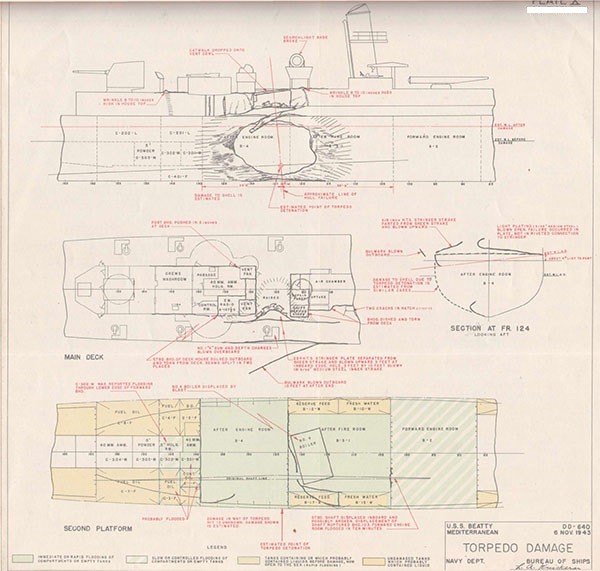
The Navy Department Library
Destroyer Report
Torpedo and Mine Damage and Loss in Action
17 October, 1941 to 7 December, 1944
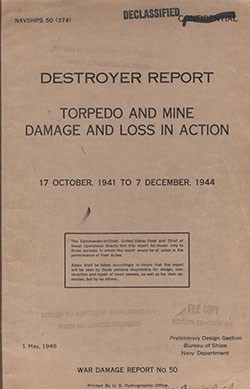
NAVSHIPS 50 (374)
CONFIDENTIAL
Destroyer Report
Torpedo and Mine
Damage and Loss in Action
17 October, 1941 To 7 December, 1944
The Commander-in-Chief, United States Fleet and Chief of Naval Operations directs that this report be shown only to those persons to whom the report would be of value in the performance of their duties.
Steps shall be taken accordingly to insure that the report will be seen by those persons responsible for design, construction and repair of naval vessels, as well as for their operation, but by no others.
Preliminary Design Section
Bureau of Ships
Navy Department
1 May, 1945
WAR DAMAGE REPORT No. 50
Printed By U. S. Hydrographic Office
| Page | |
| I - FOREWORD | 1 |
| II - SUMMARY AND DISCUSSION | 2 |
| III - NARRATIVES | 13 |
| Name | DD No. | Std. Displ. | Page No. | Damaged by | Locale | Date |
| HAMBLETON | 455 | 1630 | 13 | Torpedo | North Africa | 11/11/42 |
| LA VALLETTE | 448 | 2100 | 19 | Torpedo | Rennell Is. | 1/30/43 |
| STRONG | 46 |
2100 | 24 | Torpedo | Kula Gulf, Solomon Is. | 7/5/43 |
| ABNER READ | 526 | 2100 | 27 | Mine | Kiska Is. | 8/18/43 |
| KENDRICK | 612 | 1620 | 32 | Torpedo | Western Mediterranean | 9/2/43 |
| CHEVALIER | 451 | 2100 | 35 | Torpedo | Vella La Vella, Solomon Is. | 10/6/43 |
| SELFRIDGE | 357 | 1850 | 39 | Torpedo | Vella La Vella, Solomon Is. | 10/6/43 |
| BRISTOL | 453 | 1630 | 44 | Torpedo | Western Mediterranean | 10/13/43 |
| FOOTE | 511 | 2100 | 47 | Torpedo | Bougainville, Solomon Is. | 11/2/43 |
| BEATTY | 640 | 1630 | 52 | Torpedo | Western Mediterranean | 11/6/43 |
SECTION I - FOREWORD
1-1. Destroyers now in service range in size from the old 1200-ton ships to the modern 692 class of 2200 tons standard displacement. As a group, destroyers have established an enviable record in combat, not only in damage inflicted upon the enemy but also in ability to absorb damage to themselves. Destroyer development in the past 5 years has been marked by rapid growth in offensive characteristics with a corresponding increase in size. The increase in size has resulted in ships with a high degree of resistance to damage, through improved watertight subdivision, increased longitudinal strength, and an arrangement of machinery which permits operating with a completely split plant.
1-2. This report covers the period from 17 October 1941 to 7 December 1944, and is based on the latest information available. Over one hundred U.S. destroyers have been damaged by enemy weapons larger than 40mm projectiles. Of these, a total of 44 have been lost as a result of the damage incurred. Reports of damage and loss submitted by Commanding Officers and other activities generally have been excellent and have permitted the compilation of reasonably complete records of the war experience of this class, particularly with respect to ability to resist damage. Analysis of these reports has revealed a number of outstanding features.
1-3. In view of the interest which has been attached recently to destroyer stability characteristics, it is significant that there have been only two clear-cut cases, among the 44 destroyers sunk by enemy action in the period covered by this report, in which loss of stability followed by capsizing, has been the major factor in causing loss. With respect to magazine explosions, only one destroyer experienced an immediate magazine explosion when struck by an enemy weapon. In 5 other cases, however, fire reached the vicinity of the magazines and ultimately caused magazine explosions which resulted in the loss of the vessels.
1-4. It is the purpose of this report to show clearly by case histories what happens to a destroyer when it is torpedoed or mined*. The design features and damage control measures involved are discussed when of special importance. Altogether, 31 of our destroyers have been torpedoed and seven of them were saved. Of the eight vessels damaged by enemy mines, five survived. Although some of the 39 also were damaged by other types of weapons, the torpedo or mine was the primary cause of loss. The 10 cases included in this report have been selected for publication because of their general interest and also because they portray what may be considered as typical destroyer damage resulting from torpedoes or mines.
1-5. The large number of cases described in this report has resulted in a comparatively long publication. In order, however, that the important lessons drawn from these experiences will not be obscured by the length of the report, the usual organization of the Bureau's damage reports has been reversed. Thus, the discussion is presented before the narratives on which it is based.
___________
*Buships War Damage Report No. 51 concerns destroyer bomb and projectile damage.
--1--
SECTION II - SUMMARY AND DISCUSSION
(Plates I through X and Photographs 1 through 61)
A. General
2-1. A selection has been made of cases that show the effect upon a destroyer of underwater detonations at various locations throughout the entire length. Of the ten destroyers discussed in detail in this report, three were damaged abaft the machinery spaces, five were damaged in way of the machinery spaces, and two were damaged forward of the machinery spaces. Thus, these cases, combined with those of KEARNY (DD432)*, O'BRIEN (DD415)**, and several other destroyers which are discussed only enough to stress certain points, give a fairly complete picture of the effects on destroyers of underwater attack by large weapons.
2-2. The ten cases of loss or damage which have been chosen for detailed analysis are those for which the data are reasonably complete. Most of the reports of damage or loss submitted by the Commanding Officers followed the form of the Bureau's letter C-FS/L11-1(374), C-EN28/A2-11 of 17 April 1942, which has been distributed to all vessels in the U.S. Navy. A few of the reports, however, were not based on this letter. Accordingly, some important details still remain unknown. This is particularly true in those cases where loss of the vessel occurred. It is realized that the preparation of a complete report often may be an onerous task to the individuals involved. However, it is only through such reports that the forces afloat can keep the Department fully aware of significant events and the need for design changes or material improvements. It is emphasized that reports of damage and loss have served as a basis for improvements in both design and equipment.
B. Enemy Torpedoes
2-3. Recently, considerable information concerning the sizes and types of German and Japanese torpedoes and mines has become available through Naval Intelligence sources. In addition, a number of intact German and Japanese torpedoes and mines have been recovered and these have been examined and tested by the Bureau of Ordnance.
2-4. Present information indicates that the Germans have used a number of different types of submarine torpedoes of which 90 per cent or more are fitted with warheads containing 660 pounds of blockloaded hexanite. German hexanite is about 30 per cent more powerful than an equal weight of TNT, while torpex used in certain types of U. S. torpedoes has been estimated by the Bureau of Ordnance as about 50 per cent more powerful per unit weight than TNT. The air-driven and electric-driven torpedoes fitted with contact or magnetic pistols are the most common types of German submarine torpedoes. Since 1942, the use of the "Curly" has been in evidence. "Curly" is the name given a torpedo using a mechanism which causes the torpedo to describe a to-and-fro or circling course to obtain a greater chance of a hit. The acoustically-controlled torpedo,
____________
*Buships War Damage Report No. 15.
**Buships War Damage Report No. 28.
--2--
T-5", with a warhead charge of 590 pounds of hexanite, came into general service about September 1943, and has caused damage to a number of U. S. vessels. There are four known types of aircraft torpedoes used by the Germans, all 18 inches in diameter. The charges of the warheads are 400, 450 (2 types) and 470 pounds of block-loaded hexanite.
2-5. The range of weights of torpedo explosive charges employed by Japanese submarines, surface craft and aircraft is from about 338 to 1086 pounds. At least three types of explosive have been used in the torpedo warheads including "Shimose", "Type 94" and "Type 97". "Shimose" and "Type 97" are about equivalent to TNT in explosive power, while "Type 94" is somewhat more powerful. Since 1938 the "Type 90" 24-inch torpedo, which is estimated to contain about 880 pounds of "Type 94" explosive, apparently has been used on some of the old destroyers and light cruisers. Available data indicates that since 1940 the large "Type 93" 24-inch torpedo, containing about 1086 pounds of "Type 97 explosive, is the type carried on cruisers and destroyers built since that year and also on some destroyers built prior to 1940. Weights of Japanese aircraft torpedo explosive charges vary from about 338 to 812 pounds.
C. Enemy Mines
2-6. The Germans have used not only various types of their own mines, but also Dutch, French, and Italian. Moored contact mines usually laid by surface craft are of three types: standard (330 to 660 pounds), small charge (less than 100 pounds), and special purpose (1-3/4 to 120 pounds, some of which are laid by aircraft). Moored influence mines, usually laid by surface craft or submarines with a normal case depth of 60 to 90 feet, contain from 470 pounds of cast hexanite to 760 pounds of block-loaded hexanite. Several types of drifting mines have been recovered with charges from 25 to 430 pounds of TNT. Ground influence mines also have been employed extensively. These ground mines, laid usually by planes or submarines, are magnetic, acoustic, or magnetic-acoustic combination mines; the charges ranging from 660 to 1850 pounds of cast hexanite.
2-7. All Japanese mines encountered to 7 December 1944, with the exception of beach mines, have been moored contact types used for defensive purposes only. The charge varies from 121 to 550 pounds of "Shimose", "Type 88" or "Type 98" explosive. One has been recovered from a depth of 3527 feet (case depth was 246 feet) - the maximum depth so far encountered with moored contact types. They are laid either by submarines or surface craft. All incorporate chemical horns for firing. The one most commonly used is "Type 93" Model 1 with a 220-pound charge of "Type 88" granular explosive and is laid by surface craft. "Type 88" granular is somewhat more powerful than TNT. No Japanese antenna mine is known to exist, although stocks of British antenna mines were captured early in the war. "Type 92", acoustically and visually monitored, is a commonly used controlled mine. The charge is 1100 pounds of "Type 88" granular and is laid at a minimum depth of 100 to 125 feet. Numerous new types of mines, both contact and influence have been reported by Japanese prisoners of war. Information from captured documents and photos also has been obtained. The Japanese are known to have
--3--
received a number of German ground mines and influence firing units before 7 December 1941. They also have captured a number of U. S. mines; consequently, they are expected to introduce new types of mines, perhaps with influence firing units and suitable for laving from aircraft and submarines.
D. Structural Damage
2-8. In the cases of practically all the destroyers discussed in this report, it is noted that the detonation of a torpedo or mine lifted the vessel bodily. Flexural vibrations of the hull occurred in about half the cases, for detonations in way of the machinery spaces as well as at the bow or stern. However, none of these vessels incurred damage from flexural vibration as severe as that which led to the breaking up of O'BRIEN (DD415).
2-9. Some of the main transverse bulkheads in the machinery spaces were subjected successively to blast pressure, a static head of water due to flooding and pressure of the sea due to the motion of the ship. A secondary factor, transverse displacement of a propeller shaft, caused bulkhead ruptures in CHEVALIER (DD451) and BEATTY (DD640). In general, however, the main transverse bulkheads remained effective under severe conditions. There were a number of cases of large deflections with only minor leaks. In HAMBLETON (DD455) the bulkhead between the forward engineroom and forward fireroom was about 18 feet from the point of detonation of a torpedo warhead charge of about 660 pounds of German hexanite. This bulkhead did not fail, although it was deflected forward about 36 inches. There was only a small amount of leakage through the bulkhead structure itself, by reason of a 6-inch tear through a weld and some small fragment holes. Again, after the bow of SELFRIDGE (DD357) was blown off, bulkhead 68, reinforced by shoring, exhibited no signs of failure despite a speed of 10 knots. At the other extreme is the case of the forward bulkhead of the after engineroom of STRONG (DD468). This bulkhead, about 35 feet from the estimated point of detonation of a torpedo warhead charge more powerful than that which damaged HAMBLETON, was split open by blast pressure, permitting the after engineroom to flood to the waterline.
2-10. For an explosive charge of fixed weight the extent of structural damage to the ship girder (or the reduction in sectional modulus) depends upon the width and depth of the hull, and also upon the scantlings of remaining material at the transverse section in way of the detonation. In general, complete rupture, for detonations outside the middle one-half length of destroyers, is to be expected in the case of large charges, such as are found in torpedoes and the larger mines. Of the five vessels in this report damaged by underwater detonations outside of the middle one-half length, CHEVALIER and SELFRIDGE lost their bows and ABNER READ (DD526) and FOOTE (DD511) their sterns. The relatively small hole at the stern of KENDRICK (DD612) apparently was due to the location of the detonation at the extreme stern. In the case of O'BRIEN, a deep detonation in the vicinity of the stem did not cause a complete transverse rupture of the bow. The sterns of destroyer escort vessels damaged by torpedo or mine detonations have shown a tendency to be folded upward rather than broken off.
--4--
2-11. After a detonation in the middle one-half length of a destroyer, an appreciable part of the structure in the transverse section has remained intact in the majority of cases so far experienced. The strength of any vessel so damaged is affected adversely in two ways: first, by the reduction of the section modulus of the damaged section due to rupture or distortion of structure; and second, by an increase in the bending moment applied to the hull due to the weight of the damage water taken aboard. If the reduction in section modulus is serious, the increase in bending load, caused by flooding, will result in corresponding stress increases in the remaining structure and complete failure of the hull may occur. Transverse deck or bottom wrinkles accomplished by crumpling of attached longitudinal members eventually may lead to complete rupture, as in the case of O'BRIEN.
2-12. Among the 1630-ton destroyers, HAMBLETON was struck by a torpedo on the port side in way of the forward engineroom. The remaining effective strength members after damage consisted essentially of about one-half of the main deck, the starboard sheer and the next two lower side strakes, with their longitudinals. Two main machinery spaces were flooded to the waterline, and a third to a depth of about 4 feet. The two ends of the ship worked noticeably relative to each other in a light sea. Calculations indicate that the minimum section modulus of remaining effective structure was reduced to approximately 15 per cent of that of the intact transverse section. With the ship in the still water condition, it is estimated that the tensile stress at the lower edge of the partially intact "C" strake approached 22 tons per square inch, the yield point of high tensile steel, of which the middle one-half length was constructed. Although the warhead charge is estimated as equivalent to about 860 pounds of TNT, the vessel survived, principally because of good weather, the proximity of a safe anchorage, and excellent damage control measures. BRISTOL (DD453), another 1630-ton destroyer, was hit in way of the same machinery space by a torpedo with a warhead charge believed to be somewhat smaller. The same three machinery spaces were involved, but all three flooded to the waterline rapidly. Although sea conditions were favorable, about 4 minutes after being hit, BRISTOL broke in two. Possibly, the somewhat greater stresses induced by the third machinery space flooding completely to the waterline, rather than just to a depth of about 4 feet as in the case of HAMBLETON, was an important factor. BEATTY (DD640), another vessel of the same class, incurred a reduction in section modulus about the same as that of HAMBLETON. However, three of BEATTY's main machinery spaces flooded to the waterline and some 4 hours and 20 minutes after the detonation, in spite of only a light swell, complete structural failure, similar to that of BRISTOL, resulted.
2-13. Among the 2100-ton destroyers damaged by underwater detonations in way of the middle one-half length, LA VALLETTE (DD448) was struck by a torpedo on the port side abreast the forward engineroom. The torpedo had an estimated warhead charge equivalent to about 522 pounds of TNT, considerably less powerful than the damaging agent in the cases discussed in paragraph 2-12. Two machinery spaces flooded to the waterline immediately, and a third to a depth of about 4 feet. The sea was moderate. There was no evidence of any working of the hull. LA VALLETTE survived handily. STRONG (DD468), which was damaged by a more powerful
--5--
charge than was LA VALLETTE, incurred a greater reduction in section modulus and rapid flooding of three main machinery spaces to the water-line. About 39 minutes after being torpedoed, STRONG broke in two and sank. The detonation of the mine which damaged WADLEIGH (DD689) left only the main deck, the sheer and next lower strakes on each side, with their longitudinals, as the main effective strength members. Calculations indicate the section modulus of remaining effective structure below the new neutral axis was reduced to about 14 per cent of that in the intact condition. Three main machinery spaces flooded to the water-line. The bow and stern worked noticeably with respect to each other. That WADLEIGH survived was due primarily to favorable, sea conditions. ROSS (DD503) was damaged by two well-separated mines, which were much less powerful than the one in the case of WADLEIGH. Less than a 40 per cent reduction in cross sectional area occurred and ROSS was never in danger of breaking up. ROSS incurred flooding not only of three main machinery spaces, but also of a considerable portion of the ship aft of the after engineroom. Despite this extensive flooding and severe structural damage in two locations, ROSS safely rode out a severe storm.
2-14. MEREDITH (DD726), a 2200-ton vessel with main hull structure essentially the same as the 2100 class, incurred severe damage from the detonation of a large mine. About one-half of the main deck, one side, and one-half of the bottom (possibly including the keel) remained as effective strength members. Three machinery spaces were flooded to the waterline. At first, there was no evidence of working of the hull. After a number of hours, relative movement of the two ends began and she finally broke in two about 29 hours after being mined.
2-15. There are a number of reasons why the 2100 and 2200-ton destroyers have shown greater resistance to breaking up than have the earlier classes. Compared to the earlier destroyers, the two later classes have greater beam and depth of hull and also much heavier scantlings with correspondingly smaller bending stresses in the intact condition. In addition, in the middle one-half length, the sheer and next lower side strakes and all main deck strakes are STS rather than HTS. This has resulted in a greater margin of strength in the ship girder to resist breaking in two after damage.
2-16. War experience indicates how important it is, from a structural point of view, to limit and reduce, if possible, the extent of flooding. It appears that the upper limit of flooding which can be incurred in combination with a sharp reduction in section modulus is somewhat greater than two machinery spaces for the smaller classes, and somewhat greater than three machinery spaces for the larger. When damage of such magnitude occurs, the situation is critical, but not necessarily hopeless. Thus, if measures to control the damage are promptly and effectively instituted, the ship may be saved as was HAMBLETON.
E. Buoyancy and Stability
2-17. The necessity of keeping a constant check on the stability of destroyers was recognized a number of years ago. Although this Bureau is primarily responsible for the stability of naval vessels, assistance from all personnel engaged in design, construction, repair and operation is mandatory to insure that adequate stability characteristics are maintained. In
--6--
the light condition of loading, with fuel tanks empty, the older destroyers in particular have an inadequate margin of stability. Therefore, in order to maintain adequate stability characteristics while operating, instructions long ago were issued which specify a certain sequence to be used when emptying fuel oil tanks, based on emptying the lowest tanks last. More recently, instructions were issued for liquid ballasting whereby certain fuel oil tanks are filled with salt water as soon as they are emptied of fuel. Present liquid ballasting instructions are based on insuring adequate stability characteristics, after large consumption of fuel.
2-18. Also, limiting drafts have been established as a guide against overloading. Prevention of overloading is necessary to safeguard many important characteristics, including reserve buoyancy, speed, radius, and dryness as a gun platform.
2-19. Of the cases of destroyers lost due to enemy action, a far greater number have gone down by plunging than by bodily sinkage or capsizing. In the foreword it was noted that there have been only two clear-cut cases in which it appears that impairment of stability, followed by capsizing, was the primary cause of loss of a destroyer. The vessels involved were PRESTON (DD379) and JOHNSTON (DD557). These were riddled along the waterline by gunfire and incurred very extensive flooding, apparently including at least all main machinery spaces. In addition, shallow flooding outside of the main machinery spaces also occurred and seriously impaired stability characteristics because of the large free surface effect.
2-20. A recent report indicates that at least one destroyer has been operating with water deliberately introduced into the machinery space bilges to a depth of one or two feet. Such a procedure is dangerous, being detrimental to stability, especially in a heavy seaway or in case of damage, because of the large, wide areas of free surface involved. It is estimated that the effect of this quantity of free water is equivalent to adding 90 tons of topside weight.
2-21. HAMBLETON, STONG, MEREDITH and BEATTY developed initial lists after damage (15 degrees in the case of STRONG) to the side away from the point of impact under circumstances which are not unusual for ships of destroyer size. These vessels were damaged by underwater detonations in way of the machinery spaces, close to boilers. The list was caused by reduced GM in combination with a resultant moment acting to the side opposite to the detonation. The following factors produced the resultant moment:
(a) Large machinery weights (boilers, reduction gears, turbines, and turbo-generators) were displaced transversely. Boiler movement was the greatest-single factor.
(b) Hull structure in way of the detonation was lost.
(c) Small items of machinery were lost or displaced transversely.
Flooding of empty or partially full ruptured wing tanks normally creates a moment opposite to factors (a) to (c) above.
--7--
2-22. ROSS (DD503) experienced flooding to the waterline in three main machinery spaces, plus considerable additional flooding aft. The list was about 14 degrees, with the main deck aft awash on the low side. Thus, her stability was critical. By means of adequate damage control measures, however, her list was removed; and in spite of extensive flooding it was possible for ROSS to survive a severe storm. A vessel probably will not be in danger of loss by capsizing, plunging or bodily sinkage after damage until the following conditions exist in combination with each other:
(a) The weather deck at the low side or low end more or less continuously awash.
(b) Flooding progressing with little or no possibility of checking it.
It is significant to note that in case of ROSS, (a) existed, while (b) did not develop.
2-23. In spite of the flooding of two machinery spaces to the waterline and a third to a depth of about 4 feet, LA VALLETTE incurred no list after damage and remaining freeboard was about 6 feet. It is evident that her stability characteristics* were satisfactory after damage. This case and that of ROSS are examples of the applicability to destroyers of the general rule contained in Section 4-3 of FTP170-B: "Aside from cases involving loss from fires or structural failures, war experience has demonstrated that no matter what the list or trim, if the ship does not sink within a very few minutes after damage, there is a good chance of saving her by proper damage control measures. The cases of loss by bodily sinkage, plunging or capsizing several hours after damage have been entirely attributable to progressive flooding".
F. Machinery Damage
2-24. Underwater detonations at the stern caused ABNER READ to lose both propellers, while the blades of the starboard propeller of FOOTE were broken off and the port shaft was bent sharply. As a result these vessels were without propulsion. KENDRICK, however, retained both propellers after a torpedo detonation at the stern and in spite of some misalignment of the shafts, still was able to use both engines in making a speed of about 12-1/2 knots. In the case of FOOTE, the detonation at the stern caused both shafts to stop suddenly. However, damage to the main machinery units was relatively minor. Keys in both reduction gear units were sheared. The port low pressure turbine ran free for a brief period, scoring surfaces of the rotor bearings.
2-25. Underwater detonations in way of the machinery spaces caused complete loss of propulsion in the cases of HAMBLETON, STRONG, WADLEIGH, ROSS, MEREDITH, BRISTOL and BEATTY. LA VALLETTE, however, proceeded on the port shaft (after engine) at 7 knots for over 4 hours until all the remaining feed water was consumed. Part of her feed water was lost, and the evaporators were destroyed. After her bow was
____________
*Calculations indicate that the GM of LA VALLETTE was never less than 1.8 feet under the most unfavorable conditions encountered.
--8--
blown off, SELFRIDGE was able to make a speed of about 10 knots.
2-26. In general, destroyer main machinery installations have proven to be surprisingly rugged and effective in absorbing the shock of a sudden stop at high speed. Despite much evidence which indicates that misalignment of main units is surprisingly infrequent, it is mandatory in cases of underwater damage that at the first opportunity the alignment of main shafting and main reduction gears be checked, the main reduction gear rotating units be dial-indicated and the condition of the turbine-reduction gear flexible couplings be investigated.
2-27. As a result of torpedo hits, HAMBLETON, CHEVALIER, BRISTOL and BEATTY were without any electrical power. The only sources of light were hard flashlights and battle lanterns. STRONG, WADLEIGH, MEREDITH and ROSS were left with only an emergency diesel generator to furnish power. Since 1630-ton destroyers have no emergency diesel generator because of weight considerations, there was none aboard HAMBLETON, BRISTOL, or BEATTY. MEREDITH, a 2200-ton destroyer, had two of these generators; but the forward one would not take a load, apparently because of grounded cables.
G. Drainage
2-28. In addition to permanently-installed drainage facilities, including the main circulating pumps in the enginerooms when on bilge suction, destroyers now have various types of portable pumping equipment available for emergency purposes. This portable equipment on occasions has been used in conjunction with the permanent facilities, while there have been other cases where the only means of keeping a destroyer afloat after damage consisted of the portable equipment. During the early part of this war, the allowance for destroyers of such equipment consisted of two 60 g.p.m. gasoline-driven handy billy pumps and three portable electric submersible pumps.
2-29. In HAMBLETON, water entering the forward fireroom reached a depth of about 4 feet. It was possible to keep even with this flooding by using the gasoline handy billy pumps on board at the time. There was no emergency power available for operating the portable electric submersible pumps. However, the handy billy pumps broke down frequently and it was with considerable difficulty that flooding was controlled at a depth of 4 feet. Additional pumps obtained from vessels anchored in the vicinity included three handy billy pumps and a 3-inch salvage pump. By means of these, it was possible to unwater the forward engineroom of HAMBLETON and to keep that space dry. As explained in the discussion on structural damage, the danger of breaking in two would have been increased had the forward engineroom flooded to the waterline.
2-30. Numerous cases of destroyer gunfire and bomb damage* have placed further emphasis on the need for additional portable emergency pumping equipment. For that reason and as production has permitted, the allowance for destroyers has been increased to three 60 g.p.m. handy billy pumps, two Model P-500 gasoline-driven pumps and five portable electric submersible pumps (four for vessels prior to the DD348 class).
___________
* Buships War Damage Report No. 51.
--9--
2-31. Considerable difficulty was experienced in FOOTE due to the clogging of portable electric submersible pump strainers by debris in the water. A screened intake was devised from the expanded metal holder of the after floater net. Numerous ships have reported difficulty with clogging of portable electric submersible pumps, and various solutions have been tried successfully. These include the use of "basket" strainers placed over the regular strainers as well as inserting the entire pump into a perforated can. While in use, portable pumping equipment should be constantly attended in order to minimize the effects of clogging or overheating.
2-32. The various types of emergency pumps included in the allowance of destroyers were designed for pumping water. FOOTE and BEATTY were typical of a number of cases of unsuccessful operation when pumping fuel oil or mixtures of fuel oil and water. Both favorable and unfavorable reports have been received concerning the ability of the portable electric submersible pumps to handle fuel oil or mixtures of fuel oil and water. A greater lift will result from connecting two or more pumps in series. The viscosity of the fuel oil and the presence of sludge are important factors. There is some evidence that a good deal of the trouble has been due to inadequate maintenance or faulty operation. Particular attention should be taken to insure the tightness of the packing gland where the electric cable passes through the watertight packing to the motor. When pumping fuel oil or mixtures of fuel oil and water with portable electric submersible pumps, the pump strainers should be checked continually and kept free of sludge to prevent overheating. Recent tests conducted by the U. S. Naval Engineering Station, Annapolis, Maryland, showed no evidence of leakage of water or oil into the motors. These tests indicated satisfactory operation when pumping diesel oil. However, when pumping several types of heavier fuel oil, the output, with full load on the motor, varied from about 70 to 0 per cent of the water capacity, depending upon the make of pump and the viscosity of the oil.
2-33. Model P-500 pumps were added to the allowance in order to provide additional capacity (both for firefighting and drainage) and to eliminate some of the difficulties experienced with other units. The P-500 pumps are designed primarily for pumping water, and since the gasoline engines are liquid-cooled, the engines will overheat when there is oil in the cooling medium. However, by taking a suction from overboard with a P-500 pump and discharging through eductors, it is possible to drain spaces containing oil or mixtures of oil and water without any harm to the pumps. In addition to their use for pumping fuel oil, the 4-inch portable eductors furnished with the pumps will increase the drainage capacity at low suction and discharge heads. As soon as they can be produced in sufficient quantities, two 4-inch portable eductors plus the necessary hose will be included in the allowance for each P-500 pump authorized. The subject of emergency dewatering is under constant study and further changes in allowance will be made as experience dictates.
2-34. The operating and maintenance manuals furnished with the various types of pumps should be studied carefully. Additional important information in a convenient form has been prepared by the Bureau of Ships in Navships 250-689, entitled "Uses and Applications of Portable Emergency Pumping Equipment". This publication includes instructions for "slip on"
--10--
strainers for portable electric submersible pumps to be fabricated by the forces afloat. Experience has proven that portable emergency pumping equipment can be depended upon if tested periodically and if drills in its use are conducted regularly.
H. Magazine Explosions and Fires
2-35. During the first three years of the war, there were five known cases of destroyers where fires reached magazines and eventually caused explosions which resulted in the loss of the vessels.
2-36. In the case of SELFRIDGE, the torpedo which struck the starboard side at frame 40 detonated in way of the forward 5-inch powder magazine. The powder cases were severed by fragments. Because of the loss of the bow, there is no evidence that a powder fire resulted. It is probable that a fire of brief duration similar to that on SAVANNAH (CL42)* occurred. The inrush of water, however, extinguished the fire almost immediately. Thus, SELFRIDGE escaped a powder magazine explosion.
2-37. One of CHEVALIER's magazines containing thin-walled 5-inch AA projectiles possibly was struck by LA VALLETTE's torpedo. Reports indicate definitely that a mass detonation followed. A similar phenomenon evidently occurred on ROWAN (DD405), the only U. S. destroyer known lost during the first three years of the war by an immediate magazine explosion from an enemy weapon. In the case of ROWAN, a German "E"-boat torpedo apparently struck and detonated abreast an after magazine which probably contained spare depth charges, causing a mass detonation of the depth charges.
2-38. With the exception of a few small fires, mainly electrical, which were quickly extinguished, no fires occurred on any of the vessels covered in this report. Other cases also substantiate the fact that it is unusual for a fire to occur on destroyers after damage from a mine or a torpedo. A complete discussion of firefighting war lessons as applicable to destroyers will be found in the Bomb and Gunfire Report**.
I. Conclusions
2-39. There are certain practicable limits to the amount of damage any vessel can absorb and still survive. Compared to cruisers and larger ships, destroyers are inherently more vulnerable to the effects of torpedoes and mines, a natural consequence of their smaller size and lighter construction. Despite their comparative vulnerability, numerous cases
____________
*In the case of SAVANNAH (CL42), a large bomb detonated in the forward 6-inch powder magazines. A powder fire was started, but the flooding through ruptures in the hull extinguished this fire before the temperatures and pressures sufficient to cause an explosion were created.
**Buships War Damage Report No. 51.
--11--
of war damage have demonstrated that destroyers are rugged vessels and will absorb and survive an astonishing amount of punishment. This is particularly true of the 2100 and 2200-ton classes. Furthermore, it is possible to greatly augment their inherent ability to survive extensive damage by prompt and effective damage control measures. Outstanding examples of the effectiveness of well-trained damage control parties will be found in this report in cases of HAMBLETON, ABNER READ and SELFRIDGE.
--12--
USS HAMBLETON (DD455)
Torpedo Damage
North Africa
11 November 1942
| Class | BRISTOL (DD453) | Length (O.A.) | 348 ft. 4 in. |
| Launched | 26 September 1941 | Beam (O.A.) | 36 ft. 0 in. |
| Displacement (Standard) | 1630 tons | Draft (Estimated, mean, prior damage) | 12 ft. 4-1/2 in. |
References:
(a) ComDesDiv 19 ltr. C-DD19/A16-3, Serial 042 of 20 November 1942 (Action Report).
(b) C.O. HAMBLETON ltr. DD455/L11-2, Serial 057 of 29 November 1942 (War Damage Report).
(c) CinClant ltr. L9-3, Serial 02787 of 4 December 1942 (Summary of Damage to HAMBLETON).
(d) C.O. HAMBLETON ltr. DD455/L2-1, Serial 059 of 6 December 1942 (Material Required for Repair of Damage).
(e) Comdt. NOB Casablanca ltr. L9-3 of 27 January 1943, (Recommendations for Repairs).
(f) C.O. HAMBLETON ltr. DD455/P13-5, Serial 014 of16 February 1943 (Supplementary War Damage Report).
(g) Comdt. NOB Casablanca ltr. L9-3 of 4 March 1943 (Report of Temporary Repairs).
(h) Comdt. NOB Casablanca ltr. L9-3, Serial 50 of 4 March 1943 (Photographs of Repairs).
(i) Comdt. NOB Casablanca ltr. Serial 350 of 19 May 1943 (Docking Report).
(j) C.O. HAMBLETON ltr. DD455/P13-5, Serial 037 of 27 June 1943 (Supplementary War Damage Report).
(k) Comdt. Navy Yard Boston ltr. C-DD455/L11-1(MEFS)of 6 December 1943 (Supplementary War Damage Report).
Photographs Nos. 1 through 15 (furnished by the Commanding Officer HAMBLETON, NOB Casablanca, and the Navy Yard, Boston).
PLATE I
3-1. On the night of 11 November 1942, HAMBLETON was anchored off Cape Fedala, French Morocco, in 17 fathoms of water. The sea was calm. The vessel was completely darkened, as were all other vessels in the vicinity. There was no moon. However, there was a searchlight on the shore which illuminated the beach, causing HAMBLETON and all other vessels in the vicinity to be silhouetted from seaward.
3-2. At 1952, a torpedo, fired by a submarine and apparently intended for the transport JOSEPH HEWES (APA22)*, crossed the bow of that vessel and struck HAMBLETON on the port side in way of the forward engineroom at about frame 97, approximately 5 feet below the waterline. (Photos 1 and 2). The detonation blasted a large hole in the port shell between frames 89 and 106. The forward engineroom and after fireroom flooded to the waterline immediately. The forward fireroom started to flood very slowly. All propulsion and electrical power and lighting were lost. Battery powered flashlights provided the only means of illumination. There were no fires.
3-3. Immediately after the detonation, HAMBLETON listed about 8 to 10 degrees to starboard (the side opposite the hit). The freeboard* on the low side at the midship section was about 15 inches. Orders were issued to set material condition ABLE. Prompt action was taken to reduce the list and limit the flooding. These damage control measures continued during the night. The forward and after ends of the ship worked noticeably with respect to each other as the vessel rode the light swells. The following morning, HAMBLETON was towed to Casablanca where temporary repairs were accomplished.
3-4. Plate I shows structural damage which resulted. It will be noted that the hole in the port shell was about 30 feet long and extended from the main deck down to the keel (photos 3 and 4), and was centered at about frame 97. The keel was pushed upward between frames 90 and 107 with a maximum deflection of about 16 inches at frame 97-1/2 (photo 5). The four bottom starboard shell strakes were wrinkled and broken in numerous places in the vicinity of frame 96-1/2 (photo 7). Fortunately, the three upper starboard strakes, including the sheer strake, were intact except for slight buckles. In general, starboard longitudinals were intact, although those in way of the four bottom shell strakes were distorted rather severely. The main deck was severely damaged (photos 8, 9 and 10). However, the starboard stringer strake was intact and relatively undamaged, while the port stringer strake was pushed sharply upward but not broken. Thus, the upper starboard corner of the hull girder comprised almost all of the structure which remained effective in preventing the ship from breaking in two.
3-5. As the combined result of the structural damage to the hull described above and the weight of the damage water, the forward and after portions of the vessel worked noticeably with respect to each other. However, progressive rupture of the hull did not occur.
3-6. The midships deck house structure was damaged severely between frames 85 and 115 (photos 1 and 2). The expansion joint at frame 85 was raised 4 inches on the port side and was wrinkled deeply on the starboard side. The top of the deck house was pushed upward from frame
____________
*Buships War Damage Report No. 32.
--13--
85 aft to No. 2 smokepipe, canting the smokepipe aft and to starboard.
3-7. Bulkhead 103, separating the forward engineroom and the after fireroom, was only about 10-1/2 feet from the point of impact, and was destroyed completely on the port side (photo 11). On the starboard side, this bulkhead remained intact although it was distorted. Bulkhead 86-1/2 did not fail, although it was stressed severely and was deflected forward by the combined effect of the blast pressure of the torpedo detonation and the static head imposed subsequently by the flooding in the forward engineroom (photos 12 and 13). This bulkhead was about 18 feet from the point of impact. The vertical stiffeners on the starboard side were deflected forward and to starboard. Also, on the starboard side, the bulkhead was dished forward, with a deflection of about 8 inches at the middle of the bulge. All the welds on the starboard side were intact. The upper edge of the bulkhead was pulled away from the main deck for about three-fourths of its length from the port edge and pushed against No. 2 boiler casing (photo 12). The port side of the bulkhead was bulged forward a maximum distance of about 3 feet. The port bottom corner was pushed upward about 2 feet (photo 12). The weld between the bulkhead and the shell had a 6-inch crack at the turn of the bilge on the port side. There was a small amount of leakage through this weld and also through small fragment holes. However, most of the leakage into the forward fireroom through this bulkhead was through cracked piping connections.
3-8. The leakage through this bulkhead permitted the water to reach a depth of about 4 feet in the forward fireroom. It was possible to keep even with the flooding in the forward fireroom by using the 60 g.p.m. portable gasoline-driven handy billy pumps aboard HAMBLETON. Because of frequent breakdown, however, these pumps were unable to lower the water. Damage prevented the use of the fire and bilge pump installed in the forward fireroom while there was no electrical power available for operating the portable electric submersible pumps. Additional pumps were requested from HUGH L. SCOTT (AP43), CHEROKEE (AT66) and AUGUSTA (CA31), anchored in the vicinity. The pumps obtained from those three vessels, including three gasoline-driven handy billy pumps from HUGH L. SCOTT and a 3-inch salvage pump from CHEROKEE, were able to remove all water from the forward fireroom and then keep that space dry. Bulkhead 86-1/2, which was badly distorted and in danger of collapsing from the static head of the water in the forward engineroom, was shored thoroughly.
3-9. After the torpedo detonation, HAMBLETON took an immediate 8 to 10-degree list to starboard. Effective measures were taken at once to reduce the list. All 300-pound depth charges and arbors on the starboard side and the starboard smoke generator were jettisoned. The starboard boat and all life rafts were lowered into the water and retained alongside. The eight starboard 600-pound depth charges were moved to the port deck edge. The port boat was swung out. Twenty-one tons of fuel oil were sluiced from tanks A-5F, C-1F and C-7F to tanks A-4F, C-4F and C-8F respectively. Upon completion of these measures, the list was reduced to about 5 degrees to starboard.
3-10. Damaged machinery was blown inboard and up by the detonation. All feed water and fuel oil lines in the vicinity of the hit were destroyed or damaged. All steam lines within 15 feet of the point of detonation were
--14--
carried away except the main steam cross-over, one main steam line to the after engineroom and the port auxiliary line (photo 10). These lines, however, were cracked and penetrated by fragments.
3-11. The machinery in the forward engineroom was damaged beyond repair with few exceptions. The reduction gear unit was deflected to starboard about 1 inch and upward approximately 2 inches (photo 11). The foundation was distorted in several places. The low pressure turbine was raised from its foundations and pushed to starboard against the high pressure and cruising turbines, all of which were moved about 3 inches to starboard. The turbo-generator in this compartment was wrecked. Most of the auxiliary machinery on the port side in way of the detonation was lost through the rupture in the hull.
3-12. In the after fireroom, all the machinery in the forward port corner was damaged severely. The port side of No. 3 boiler was destroyed almost completely and the remainder of the boiler was moved to starboard about 5 feet (photo 8). No. 4 boiler was generally intact. Most of the auxiliary machinery units were thrown from their foundations and damaged severely. All piping and valves at bulkhead 103 were ruptured. The fuel oil service lines to both boilers were distorted. Fresh water tank B-10W was ruptured.
3-13. In the forward fireroom, the main steam piping expansion joint at bulkhead 86-1/2 was pulled loose. All atmospheric exhaust piping, shore steam connections, main feed piping, auxiliary exhaust piping, feed suction piping, fuel oil transfer piping, fire main piping in the vicinity of the fire and bilge pump, the salt water circulating system, fuel oil transfer piping, as well as feed water tank B-8W were damaged and ruptured in many places. Except for the fire and bilge pump, all auxiliary machinery units in the forward fireroom were undamaged. No. 1 boiler was intact. However, the after end of the water drum of No. 2 boiler was raised about 6 inches, distorting the tube nest proportionately, while the air casing was ruptured in the port after corner and back of the boiler. The starboard, and port fresh water tanks and starboard reserve feed tank in way of the forward fireroom were intact; but the evaporators in the forward engineroom were demolished. It was necessary for men to work in a steam-filled atmosphere in order to secure the necessary valves in the forward fireroom.
3-14. In the after engineroom, there was no damage. However, no means of supplying steam to the main and auxiliary equipment, including the after turbo-generator, existed. With all propulsive power lost, the ship could not get underway. Battery powered flashlights were the only sources of illumination.
3-15. All armament except Nos. 3 and 4, 20mm guns and the torpedo tubes, remained fully operative manually. The torpedo tube mount was lifted bodily and the ends of the tubes were canted downward (photo 1). The training motor was jammed by wreckage. The tension links to the torpedoes failed, due to shock, and the torpedoes slid forward. Nos. 1, 2, 3 and 4 torpedoes had 2 to 3 inches of their noses imbedded in the skirt of No. 1 smokepipe. No. 5 torpedo was moved out of its tube about 14 feet before being wedged between the smokepipe and the starboard foremast shroud.
--15--
3-16. On 12 November, HAMBLETON was towed by CHEROKEE about 15 miles to Casablanca and then anchored. At Casablanca, berthing was shifted frequently due to congestion in the harbor. Electrical power was obtained from shore whenever practicable. On 14 November, 20,000 gallons (72 tons) of fuel oil were transferred to HOGAN (DMS6) in order to remove the remaining list. In order to provide additional stability, ready service ammunition was shifted below. On 24 November, the torpedo tube mount, with torpedoes still wedged in the tubes, was removed. The drafts then were reported as 14 feet, 6 inches forward and 14 feet, 3 inches aft.
3-17. It was obvious from a preliminary examination that extensive repairs necessitating dry-docking would be required before HAMBLETON could return to the United States. First, however, it was necessary to raise and repair the only floating dock of sufficient capacity (5000 tons). This required about two months. On 19 January 1943, HAMBLETON entered the dock. During the docking operations, the port stringer pulled away from the sheer strake at frame 98 (photo 4).
3-18. At first it was contemplated to repair the vessel by realigning the bow and stern sections and then removing the damaged structure and equipment in the forward engineroom and after fireroom. Semi-permanent repairs were to be made by replacing all the hull structure removed. The required structural material was to be prefabricated by the Navy Yard, New York and shipped to Casablanca. This plan would have entailed the exclusive use of the only available and much-needed dry dock for a long period. Accordingly, a different plan was adopted. This consisted of removing all structure between frames 87 and 116, moving the stern section forward 38 feet and then connecting the bow and stern by a fairing section 12-3/4 feet long. This scheme required the minimum docking time. It was a difficult undertaking inasmuch as the bow section had a negative GM of about 4 feet. It was necessary to ballast the bow with heavy weights and secure it to the dock (photo 14) before the dock was flooded. The stern then was floated forward and swung into line with the bow, and the faired section was installed. Bulkhead 86-1/2 was renewed. On 8 May 1943, this work was completed and HAMBLETON was undocked.
3-19. To operate the vessel with the forward fireroom and after engine-room, temporary steam lines were run through the intervening compartment between the forward fireroom and the after engineroom. An evaporating unit and a 75 KW diesel generator were installed in the hold of this midship compartment. The 75 KW diesel generator served as a standby in case of casualty to the turbo-generator in the after engineroom.
3-20. On 9 June 1943, HAMBLETON left Casablanca operating with only the port propeller. Speeds up to 18 knots were made on the return trip. HAMBLETON arrived at the Boston Navy Yard on 26 June (photo 15). There the faired section was removed, the stern moved back to its original position, and a new forward engineroom and after fireroom installed. Authorized alterations were accomplished at this time. HAMBLETON returned to service 15 November 1943.
--16--
3-21. The torpedo which struck HAMBLETON apparently was from the same salvo as those launched by a submerged submarine at JOSEPH HEWES and WINOOSKI (AO38). A fragment of the torpedo which struck WINOOSKI was recovered. This fragment was a storage battery plate, indicating that the torpedoes employed were electrically propelled*. The Germans and Italians are known to have employed several types of electric-driven submarine torpedoes. Some of these types, of German manufacture, have contained warhead charges of 660 pounds of German hexanite, equal in explosive power to about 860 pounds of TNT. The damage to HAMBLETON is characteristic of that resulting from a charge of this size and type.
3-22. It was reported in reference (b) that HAMBLETON listed initially about 10 degrees to starboard; that is, away from the side of the torpedo detonation despite the fact that there may have been some port unsymmetrical flooding of tanks B-8W and B-10W. Detailed calculations of the stability of HAMBLETON by the Bureau indicate that GM before damage (corrected for an average amount of free surface in the ship's tanks) was approximately 2.7 feet at an estimated displacement of 2223 tons. This corresponded to a mean draft of 12 feet, 4-1/2 inches. Reference (b) reported drafts of 14 feet, 6 inches forward and 14 feet, 3 inches aft, upon completion of measures to remove the list and improve the stability. Calculations indicate that immediately after damage, the GM was about 1.7 feet at a displacement of about 2986 tons, corresponding to a mean draft of about 15 feet, 2-1/2 inches. With the ship in this condition, a starboard moment of approximately 700 foot tons would have produced a starboard list of 8 degrees. Reference (b) reported about 10 degrees initial list. Based on a list of 8 degrees and a mean draft of 15 feet, 2-1/2 inches, the freeboard at the low side at the midship section was about 15 inches. An 8-degree list would have been produced by the following:
(a) Displacement of large machinery weights to starboard, including the reduction gear, turbines, No. 3 boiler, main switchboard, and turbo generator. This produced a starboard moment sufficient to cause a 4-3/4-degree list. Among the machinery units known to have been moved, No. 3 boiler produced the largest starboard moment.
(b) Displacement of auxiliary machinery. Reports indicate that enough items of auxiliary machinery were lost or displaced to produce an additional 1-3/4-degree list.
(c)Although not reported in detail, there is evidence which indicates that a number of minor items, such as piping, gratings, electrical cables, etc., were lost or moved inboard in sufficient quantity to produce another 1-1/2-degree of list.
(d) In addition to the above, the amount of water in wing tanks B-8W and B-10W prior to damage would affect the list after damage. The amount of water in these two tanks prior to damage was not reported. If they were completely full, opening them to the sea would have produced an additional starboard list by the run-off of water above the waterline.
____________
*Although these torpedoes were electrically driven, their paths were observed by the phosphorescent glow created by their movement through the water.
--17--
3-23. Structural damage to HAMBLETON was consistent with a charge of about 660 pounds of German hexanite. Based on the damage shown in the transverse section on Plate I, calculations indicate that the section modulus of remaining effective structure was reduced to approximately 15 per cent of that of the intact transverse section. With the ship in calm water and with the forward engineroom and the after fireroom flooded to the waterline, it is estimated that the tensile stress at the lower edge of the starboard "C" strake approached about 22 tons p.s.i. This value is equal to the yield point of high tensile steel of which the middle one-half length is composed. Thus, it is very doubtful that HAMBLETON could have survived had there been even a moderate sea, or had the forward fireroom flooded to the waterline. It will be recalled that bulkhead 86-1/2 was damaged severely, but did not collapse or permit serious flooding. It is unusual for a destroyer main transverse bulkhead to be so effective as was this bulkhead, particularly when it is considered that the point of detonation of a large charge was only about 18 feet distant. It was fortunate that no bad weather occurred while HAMBLETON was under tow to Casablanca. Severe working of the hull or complete failure of bulkhead 86-1/2 might well have been fatal. BRISTOL (DD453) and BEATTY (DD640), also 1630-ton destroyers which were torpedoed in way of the machinery spaces, incurred rapid flooding of three such spaces and broke in two.
3-24. Another factor which helped keep HAMBLETON afloat was the fact that emergency gasoline-driven portable pumps were obtained quickly from vessels in the vicinity. It was these pumps which dewatered the forward fireroom and kept it dry. It will be recalled that HAMBLETON's portable 60 g.p.m. gasoline handy billy pumps were the only emergency pumping equipment available. She apparently had her full allowance of these, which, at the time, was only two. It was thus imperative that outside assistance be obtained. As noted in the summary, Section EE, it has been possible to make considerable improvements in the allowance of emergency portable pumping equipment.
3-25. HAMBLETON absorbed a tremendous amount of damage. Her survival was possible because of the general excellence of the damage control measures, adequate stability characteristics, and the ruggedness of her hull. Favorable weather conditions and the proximity of a port were important factors. Temporary repairs at Casablanca not only were ingenious but also were soundly conceived and executed.
--18--
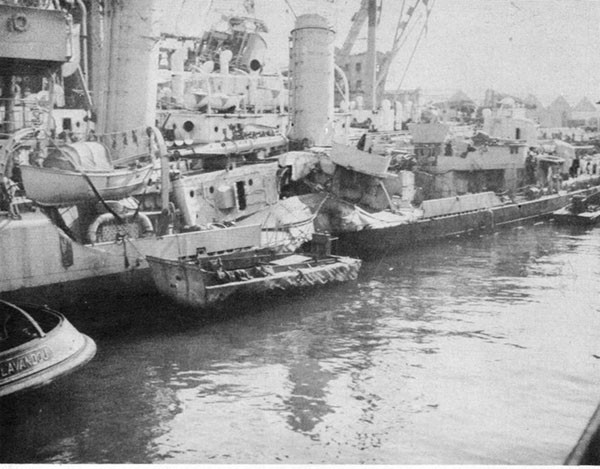
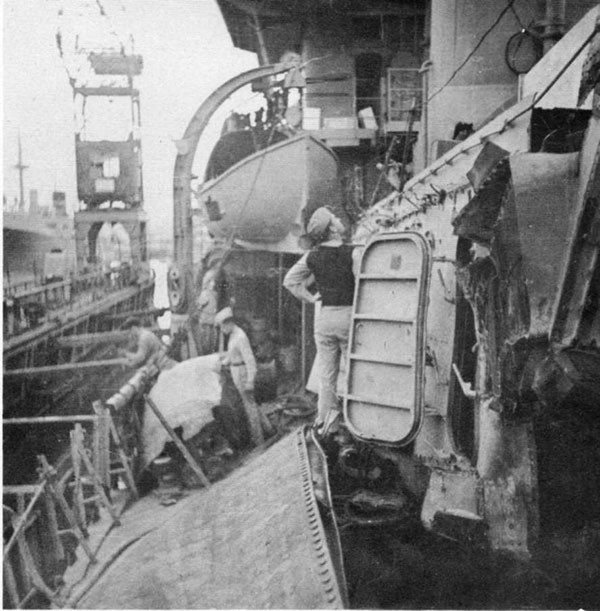
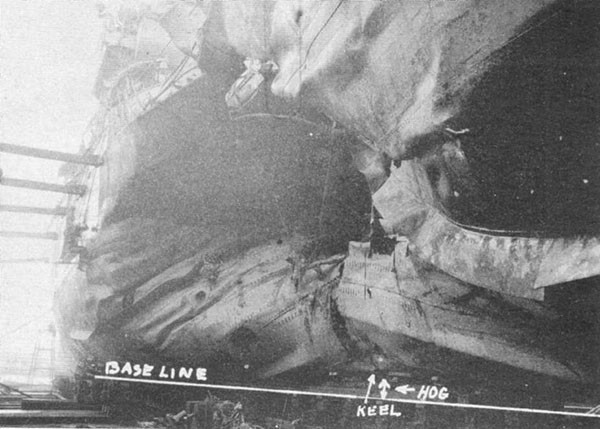
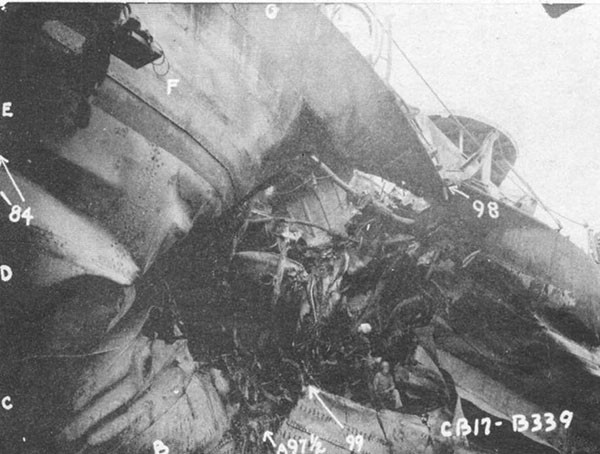
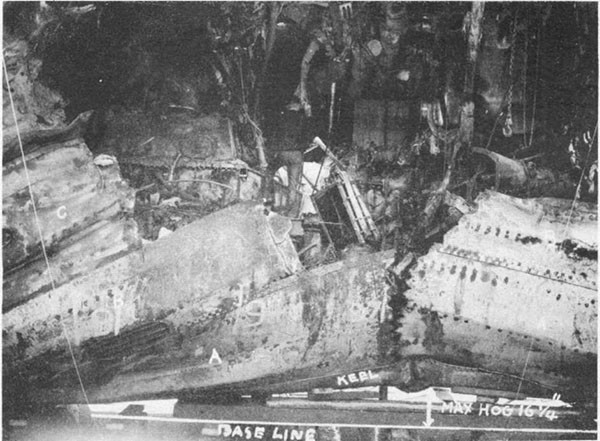
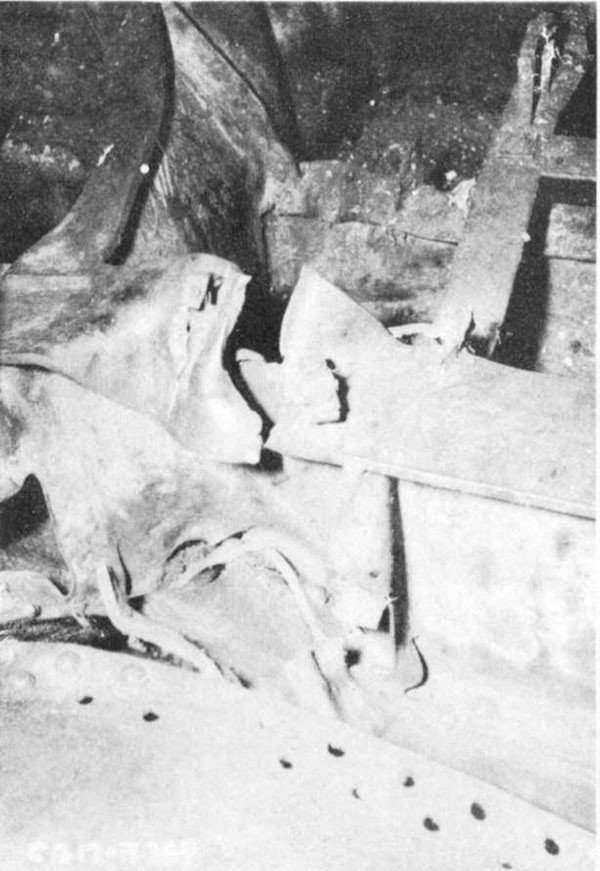
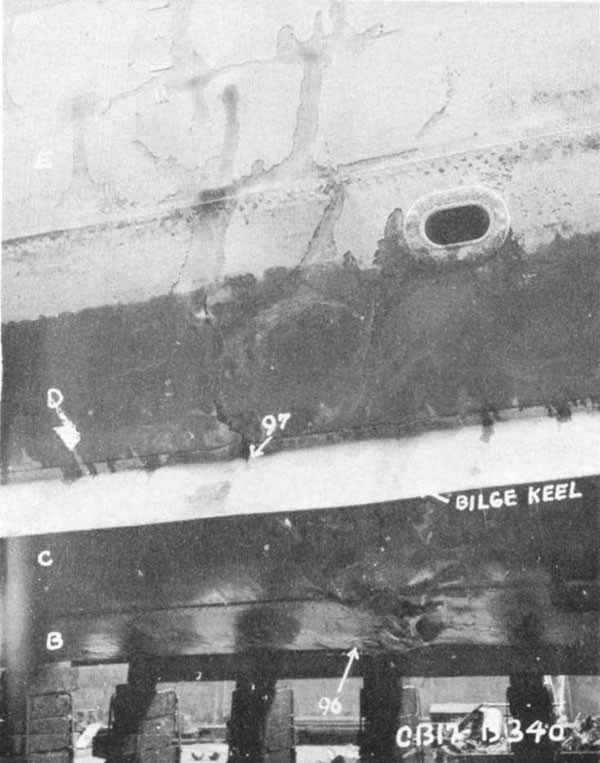
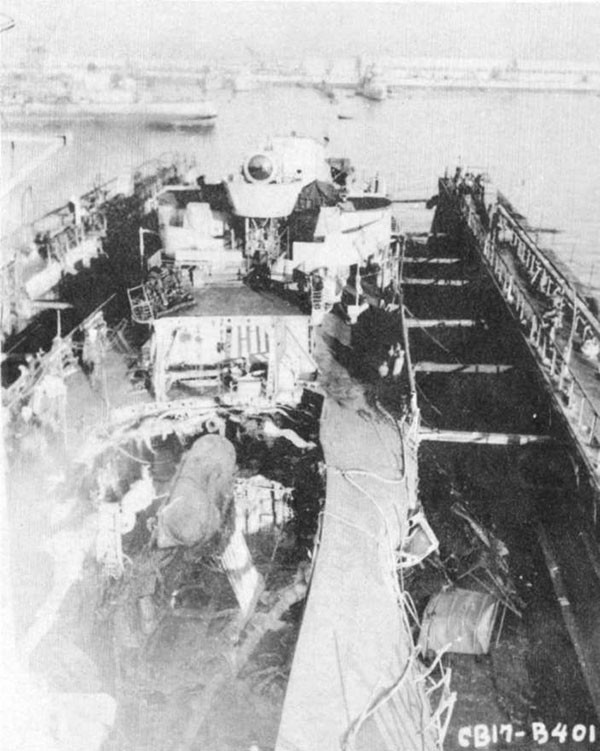
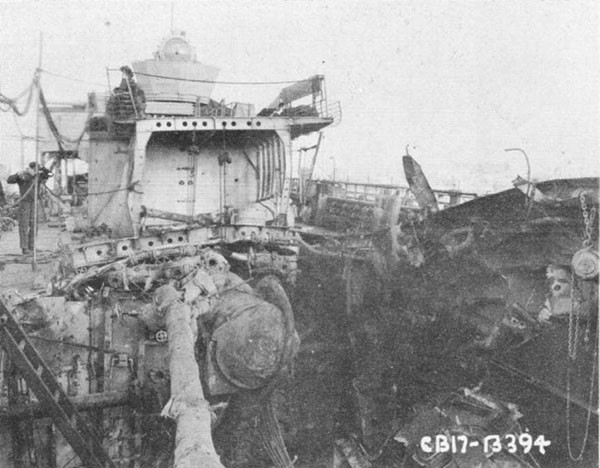
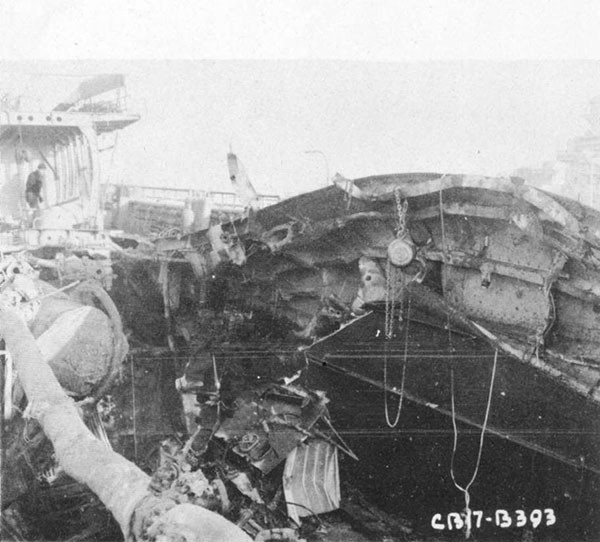
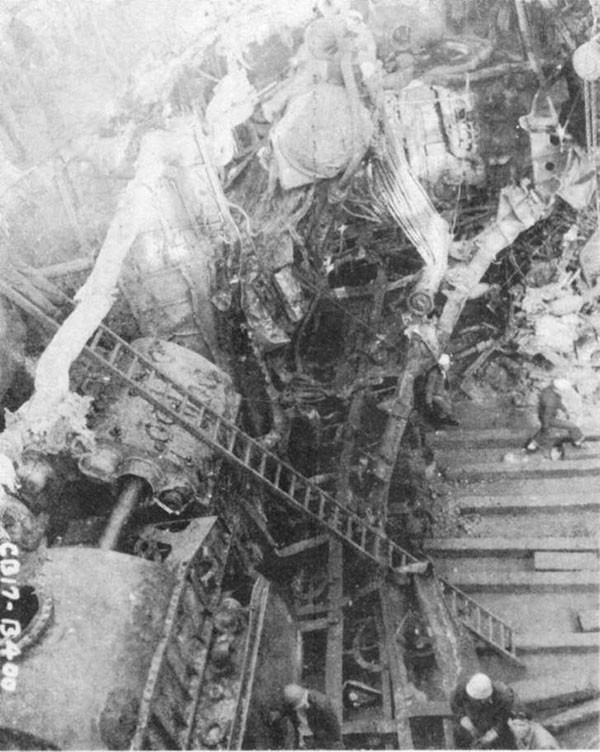
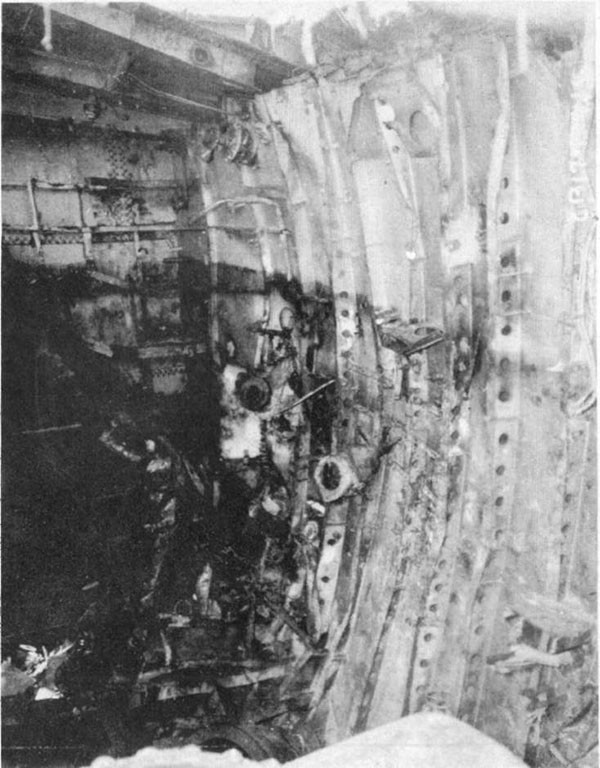
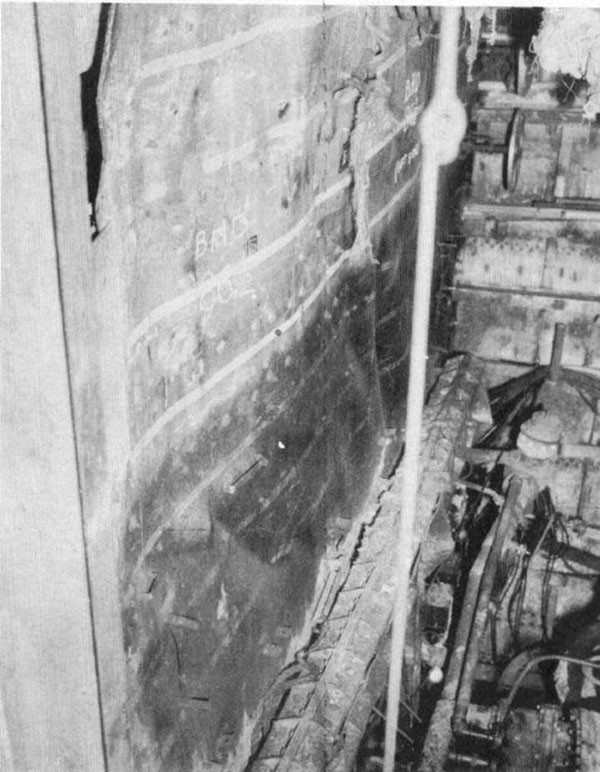
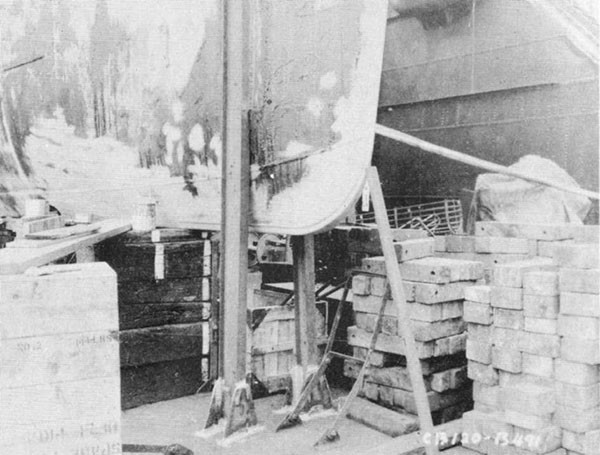
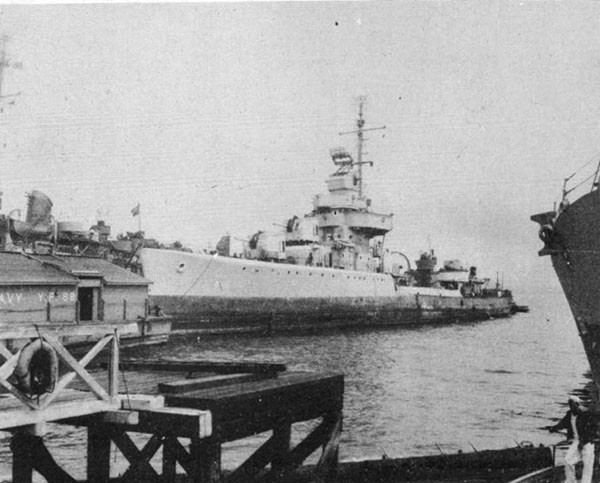
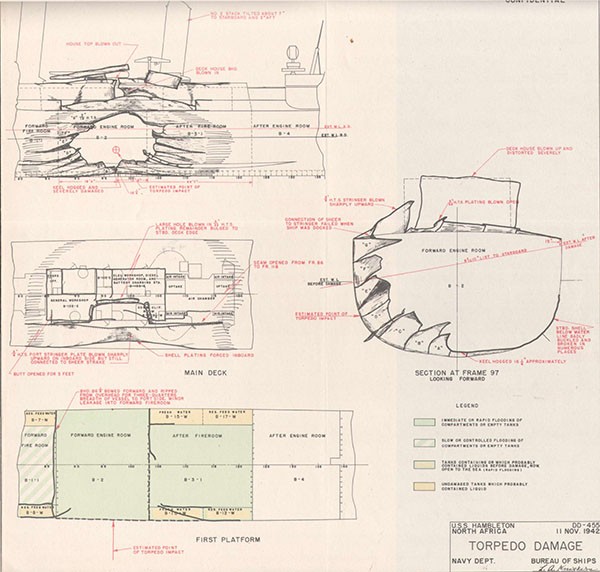
Torpedo Damage
30 January 1943
Off Rennell Island
| Class | FLETCHER (DD445) | Length (O.A.) | 376 ft. 6 in. |
| Launched | 21 June 1942 | Beam (O.A.) | 39 ft. 4 in. |
| Displacement, (Standard) | 2100 tons | Drafts (prior to damage) | |
| Forward. | 12 ft. 0 in. | ||
| Aft | 14 ft. 0 in. |
References:
(a) C.O. LA VALLETTE ltr. DD448/A16-3/(tg), Serial 0-7 of 8 February 1943 (Action Report).
(b) C.O. LA VALLETTE ltr. DD448/L11-1(tg), Serial 09 of 14 February 1943 (War Damage Report).
(c) C.O. LA VALLETTE ltr. DD448/L11-1/(tg), Serial 019 of 14 April 1943 (Supplementary War Damage Report)
(d) C.O. ARD5 Docking Report of 11 March 1943.
(e) Comdt. Navy Yard, Mare Island ltr. DD448/L11-1, Serial 351-621872 of 18 November 1943 (Supplementary War Damage Report).
Photographs Nos. 16 through 27 (furnished by the Commanding Officer, LA VALLETTE, and the Navy Yard, Mare Island).
PLATE II
4-1. On the afternoon of 30 January 1943, LA VALLETTE, while a unit of a force composed of four destroyers and one high speed destroyer transport assigned to screen the damaged CHICAGO (CA29)* (under tow of NAVAJO (AT64)), was attacked by Japanese aircraft 34 miles west of Rennell Island. LA VALLETTE was steaming on the 3000-yard circle at 15 knots. The wind was from 120 degrees true, force 3. The sea was moderate and visibility was good.
4-2. At 1620, a group of 11 enemy planes attacked from about 20 degrees forward of the port beam. The attack came directly over LA VALLETTE. Although the vessel was turning to port at the time to avoid being hit, one torpedo dropped by a burning plane 300 yards distant, struck the port side in way of the forward engineroom at frame 94, about 8-1/2 feet below the waterline. A 40-foot column of water deluged the vessel. LA VALLETTE was shaken violently from stem to stern and seemed to lift bodily out of the water. The forward engineroom and fireroom flooded immediately. The after fireroom started to flood gradually. There was no apparent list. Both engines stopped and all power was lost temporarily. No fires resulted.
4-3. Electricity was restored in about one minute and propulsion on the after (port) engine in about one and one-half minutes. LA VALLETTE proceeded at 7 knots for over 4 hours, after which she was taken in tow. Temporary repairs to make the hull watertight were accomplished at Espiritu Santo.
4-4. From Plate II it will be noted that structural damage extended about 65 feet fore and aft. The shell plating was blown inboard, leaving an opening between frames 87 and 102, approximately 26 feet long and which extended from the lower edge of the 3/4-inch STS "F" strake to within 5 feet of the keel (photos 16 and 17). The remaining lower strakes of the port shell plating were deflected inboard, and the keel was hogged between frames 78 and 118 with a maximum deflection of 14 inches between frames 93 and 94. The starboard bottom plating was distorted considerably from the keel to the "D" strake between frames 80 and 89 with a particularly sharp buckle in line with the buckle in the keel.
4-5. The main deck was deflected up between frames 72 and 110 with the maximum permanent set occurring in the vicinity of the port access hatch to the engineroom at frame 98 (photos 18-20). The main deck longitudinals, transverse beams and supporting deck stanchions in the immediate vicinity above the detonation were distorted and buckled (photo 21). Stanchions in the two forward machinery spaces were broken at the main deck connections. The watertight hatches leading to the forward fireroom and engineroom were secured at the time, but these all were blown open. There were no indications of longitudinal strength failure.
4-6. The midship deck house, between frames 89 and 110, was damaged by distortion of the main deck and by the blast from the torpedo detonation which passed up the ruptured ventilation trunks and hatch openings that terminated in this structure (photo 22). The most extensive damage to this
____________
*Buships War Damage Report No. 37.
--19--
deck house occurred between expansion joints at frames 98 and 108. The deck house in this region was blown upward, the expansion joints were ruptured (photo 23), and the exterior and interior bulkhead plating was buckled and torn loose from the riveted deck coaming. The internal girders supporting the top of the deck house parted at the sliding joint which bridges the expansion joints. This caused the structure to break away from its supporting stanchions. All ventilation trunks were bulged and the blower sets were damaged.
4-7. Bulkhead 110 (about 30-1/2 feet from the point of impact) did not give way although it was stressed severely and deflected aft by the combined effects of blast and the static head imposed by the flooding of the forward engineroom. A maximum deflection of 18 inches occurred at the mid-height of the bulkhead and the bulkhead stiffeners tipped slightly between the anti-tipping brackets in this area (photo 25). This deflection caused the center section of the bulkhead to be wedged firmly against the steam line at the rear of No. 3 boiler. There was no evidence of failure at the shell or deck connections, but several welds joining the main deck longitudinals and bulkhead stiffeners were broken. A rupture, 16 inches by 2-1/2 inches, and a circular fragment hole 2 inches in diameter were found on the port side (photo 26). These openings, in addition to leakage around the starboard shaft gland (photo 27), resulted in partial flooding of the after fireroom.
4-8. All machinery foundations on the port side of the forward engine-room were distorted severely with the exception of the turbine and reduction gear foundations. Practically all machinery on the port side of the forward engineroom was destroyed (photo 18). Most of the damaged equipment, including all distilling plant machinery, was lost through the hole in the shell plating. Fragment attack was in evidence. Two fragments penetrated the forward end of the lower casing of the L.P. turbine located just to starboard of the centerline. Two fragment holes also were found in the main reduction gear foundation. An examination of the photographs reveals that fragment damage occurred to piping and other equipment located in this compartment.
4-9. Machinery in the after port corner of the forward fireroom and the port half of No. 2 boiler were damaged. In the after fireroom, practically all the brickwork in No. 3 boiler was broken by the shock but did not fall. There were no reports of damage in the after engineroom. Tanks B-8W and B-10W were opened to the sea.
4-10. Immediately after the detonation, all power was lost. In about one minute, electricity was restored. Although no mention was made of the auxiliary diesel generator in A-305-1E, it probably was started at this time. About one-half minute later, the port propeller started turning over. Speed was built up gradually to about 7 knots. A repair party secured the forward plant promptly by operating the remote control valves. Since the distilling plant was among the damaged equipment in the forward engine-room, it was impossible to replenish the feed water supply. Therefore, at 2100, about 4 hours and 20 minutes after LA VALLETTE was torpedoed, she was taken in tow by NAVAJO due to loss of feed water.
--20--
4-11. The flooding of the forward fireroom and engineroom to the waterline and of the after fireroom to a depth of about 4 feet, increased LA VALLETTE's drafts from 12 feet forward and 14 feet aft before damage to 17 feet, 6 inches forward and 15 feet aft subsequent to damage. There was no apparent list. The freeboard at the midship section after damage was about 6 feet.
4-12. Damage control measures were undertaken immediately to control the flooding in the after fireroom and to prevent the collapse of bulkhead 110. The damage water in the after fireroom was removed by the steam-driven fire and bilge pump and two portable electric submersible pumps. The lead on one of these submersibles was not sufficiently long, and a length had to be spliced to it in order to reach a 440 volt outlet connection. In the meantime, the two holes in bulkhead 110 were plugged. Difficulty was encountered in sealing the larger hole due to the large flow of water. Wedges were cut from 4-1/2-inch soft pine plugs (the oak wedges supplied for damage control purposes were found to be too hard, and would not stay in place even when driven in with a heavy hammer). The soft pine wedges were wrapped in oakum, spaced about 1 inch between wedges, and driven into the opening. This reduced the leakage. The 1-inch spaces between the wedges then were caulked with oakum. The smaller hole was plugged in a similar manner, using oakum and toweling for the packing agent. A flat piece of wood was placed against the packing and held in place by a shore. This served two purposes in that it braced the bulkhead and kept the packing in place. The leak around the starboard shaft also was reduced by packing with oakum. Although it was impossible to stop the flooding completely, the repairs that could be made reduced the inflow of water to about 5000 g.p.h. which could be controlled by one submersible pump. Shoring of bulkhead 110 was extremely difficult due to the lack of space between the bulkhead and No. 3 boiler. Shores were placed, however, in way of the patches in the fragment holes and in the vicinity of the starboard shaft. As a precautionary measure, bulkhead 130-1/2 also was shored.
4-13. Since the fire main was ruptured, along with other piping in the forward engineroom, pressure was lost on the forward section of the fire main. In order to provide pressure should fire occur, the ruptured section was isolated and a fire hose jumper was run to a riser forward. This restored fire main pressure to the forward magazine sprinkling system and to the hose outlets forward of the break.
4-14. The detonation broke the tension links for all ten torpedoes. The torpedoes in the forward mount slid out of the tubes, hit the bulwark on the main deck and then fell into the sea. The torpedoes were running when they left the tubes and the propellers of some were seen turning over when the torpedoes cleared the side. The torpedoes in the after mount slid forward about 3 feet and also were running in the tubes. These were fired immediately before any further shock or motion of the ship could cause them to slide clear of the tubes. The loss of the ten torpedoes acted as a jettisoning measure to somewhat improve the stability characteristics.
--21--
4-15. Although the depth charge projectors and 5-inch mounts were operable, the Commanding Officer considered that it would have been inadvisable to use them in view of the weakened condition of the hull structure in the vicinity of the torpedo hit. There was also the danger of further damage to bulkhead 110. The Commanding Officer planned, if the necessity arose, to rely exclusively on the 40mm and 20mm batteries.
4-16. While LA VALLETTE was being towed to Espiritu Santo for temporary repairs, all watertight doors and hatches on the main deck and below were dogged securely, in the event that bulkhead 110 should fail. During this period, the ship's personnel lived topside. Detailed plans for jettisoning ship were made carefully and repair parties were instructed in the procedure to be followed in the event that bulkhead 110 should collapse.
4-17. At Espiritu Santo, LA VALLETTE was placed in a floating dry dock. All compartments were unwatered and loose debris removed. On the port side a temporary patch composed of plating welded to longitudinals and frames was secured to the undamaged sections of existing longitudinals and frames (photo 22). A new keel was constructed from 1-inch plate, and was installed between frames 84 and 102 below the damaged keel. On the starboard side the damaged sections of longitudinals 1, 2, 3 and 4 were removed and new longitudinals installed. The starboard "A" and "B" strakes also were renewed. Several longitudinals 8 feet long spaced 1 foot apart, were installed along the starboard "C" strake in way of the wrinkled shell plating. A 4-foot doubler plate was installed on the starboard "D" strake. These repairs provided adequate strength for the trip to Mare Island, where LA VALLETTE arrived on 1 April 1943. At Mare Island, all battle damage was repaired and several authorized alterations were accomplished. The vessel was placed back in service on 24 July 1943.
4-18. It is difficult to estimate the size of the warhead charge involved, inasmuch as the Japanese are known to use numerous different types of aircraft torpedoes with warhead charges ranging from 338 to 867 pounds and consisting of several different types of explosives. A comparison of the damage indicates that the warhead charge used against LA VALLETTE was less powerful than the 660 pounds of hexanite which is believed to have caused the" damage in the case of HAMBLETON. The smaller amount of damage incurred by LA VALLETTE may be attributed also to her greater depth and breadth of hull girder as well as heavier scantlings. The torpedo employed against LA VALLETTE may have been the "Type 91, Model 3" with a warhead charge of 522 pounds of "Type 97" explosive which is about equivalent in effectiveness to an equal weight of TNT.
4-19. The longitudinal strength of LA VALLETTE was greatly reduced because in addition to the ruptured structure, the keel was hogged and much of the plating and longitudinals which remained in way of the damaged section were bent and buckled. The main deck and the port sheer and next lower strakes, although distorted, remained intact and these members, along with the undamaged portion of the starboard shell provided sufficient longitudinal strength to permit LA VALLETTE to proceed
--22--
under her own power in a moderate sea to Espiritu Santo without any noticeable working of the bow and stern sections. This is in contrast to the case of HAMBLETON, where the two ends worked considerably in an almost flat sea.
4-20. Calculations based on Inclining Experiment Data indicate that prior to damage LA VALLETTE had a GM of about 3.8 feet (corrected for an average amount of free surface in the ship's tanks). The reported drafts were 12 feet forward and 14 feet aft, with a corresponding displacement of about 2700 tons. After damage the GM as calculated was about 1.8 feet at a displacement of about 3625 tons, corresponding to the reported drafts of 17 feet, 6 inches forward and 15 feet aft. Therefore, after damage, the initial righting moment was still adequate to absorb considerable additional flooding. Removal of the water in the after engineroom reduced the free surface considerably and thus improved the stability characteristics.
4-21. The Commanding Officer reported that no apparent list occurred after damage. This was contrary to the case of HAMBLETON (paragraph 3-22). Since the rupture in the hull of LA VALLETTE was considerably smaller than that in HAMBLETON, the amount of structure and auxiliary machinery which was lost was probably much less. The exact amount lost was not listed in the references. The heavy machinery units were evidently displaced only slightly.
4-22. The temporary repairs performed by the repair base at Espiritu Santo were thorough and complete. It will be noted in paragraph 4-17 that all shell plating and longitudinals that were buckled were either removed and replaced or adequately reinforced with plating of sufficient weight to provide a complete restoration of the original cross-sectional area. It also should be noted that the plating and longitudinals used were of sufficient length to permit efficient attachment to the intact portions of the buckled or ruptured structure, thus insuring that practically all of the original longitudinal strength was restored. In addition, the scantlings of the temporary framework and plating were sufficient to insure adequate longitudinal strength for the return trip to Mare Island. This is in marked contrast to the temporary repairs performed on O'BRIEN (DD415)*.
____________
*Buships War Damage Report No. 28.
--23--
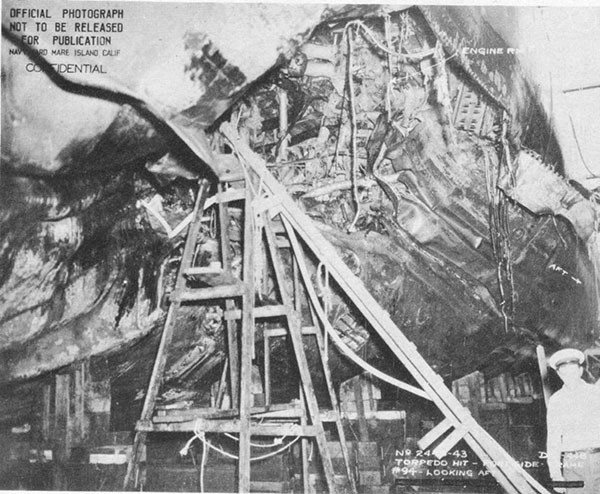
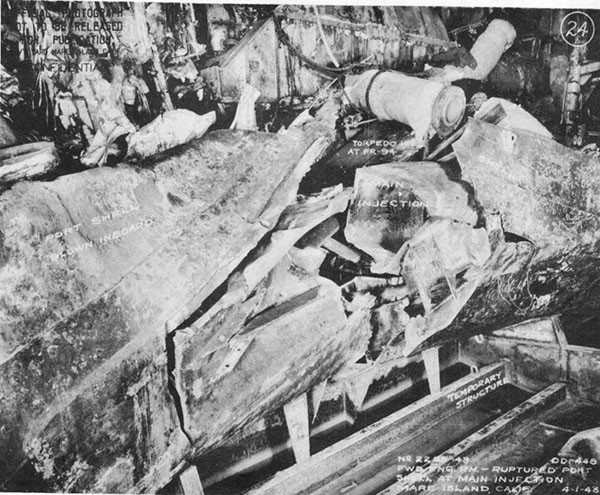
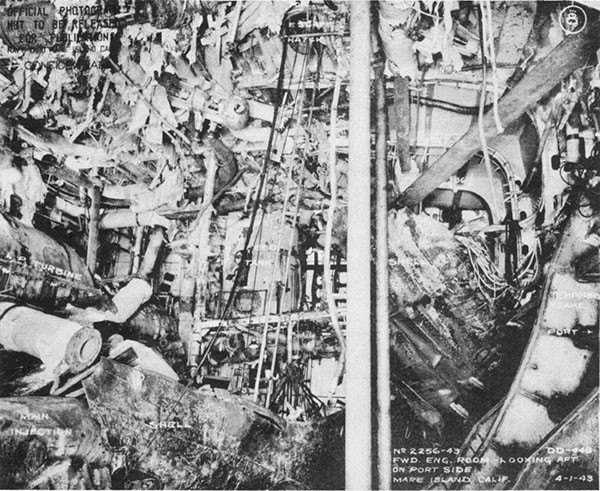
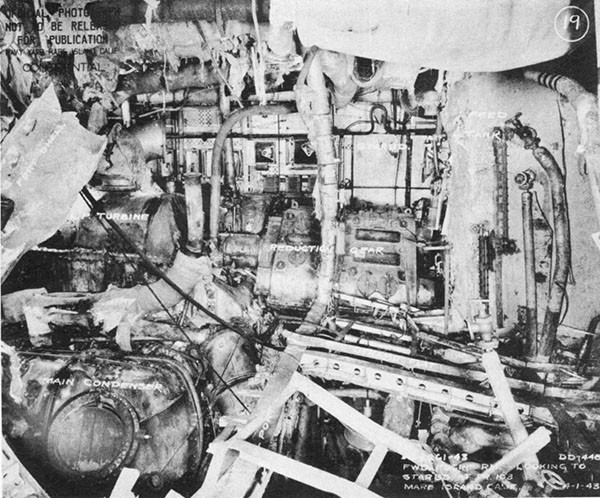
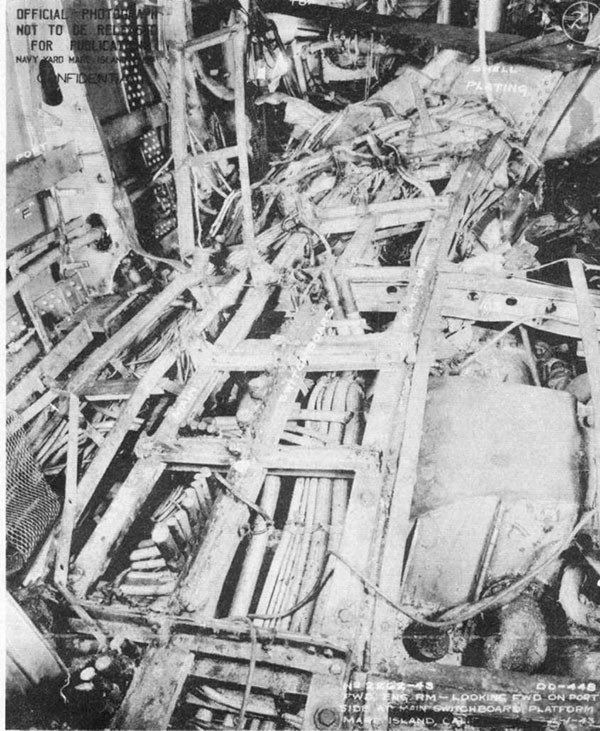
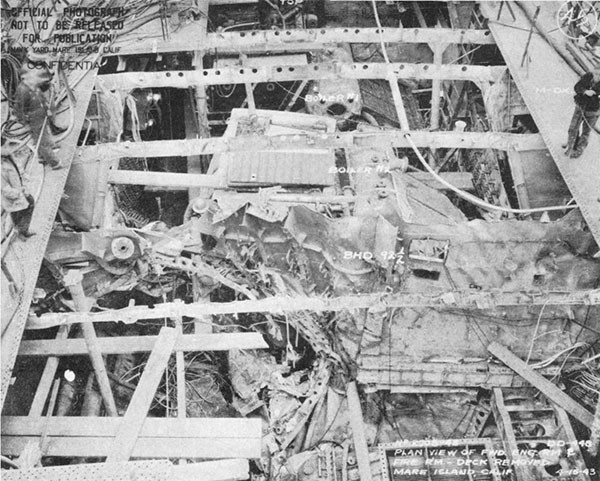
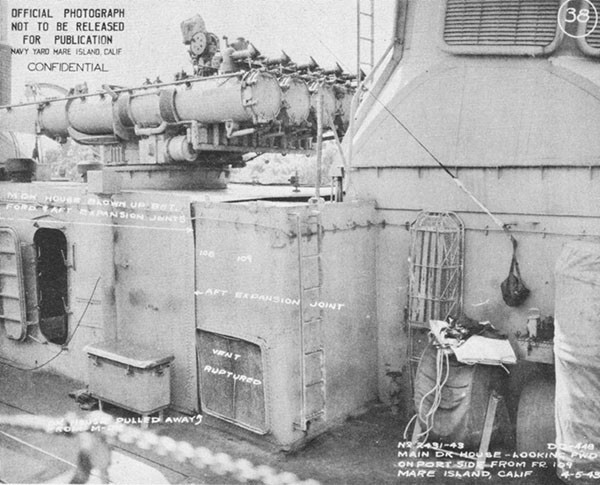
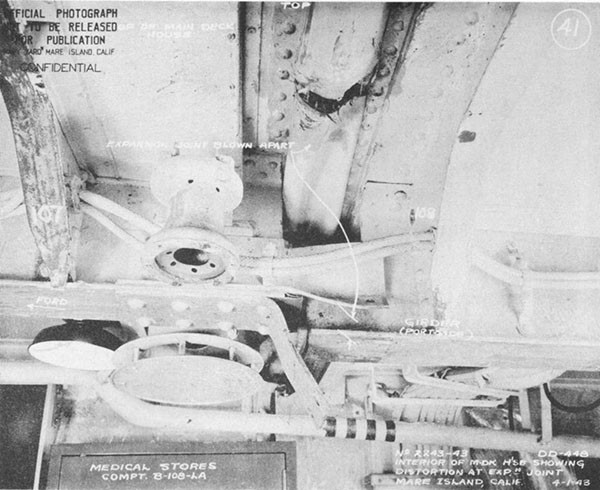
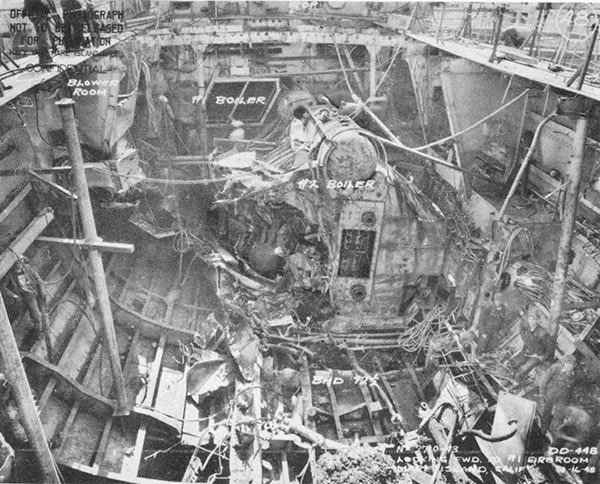

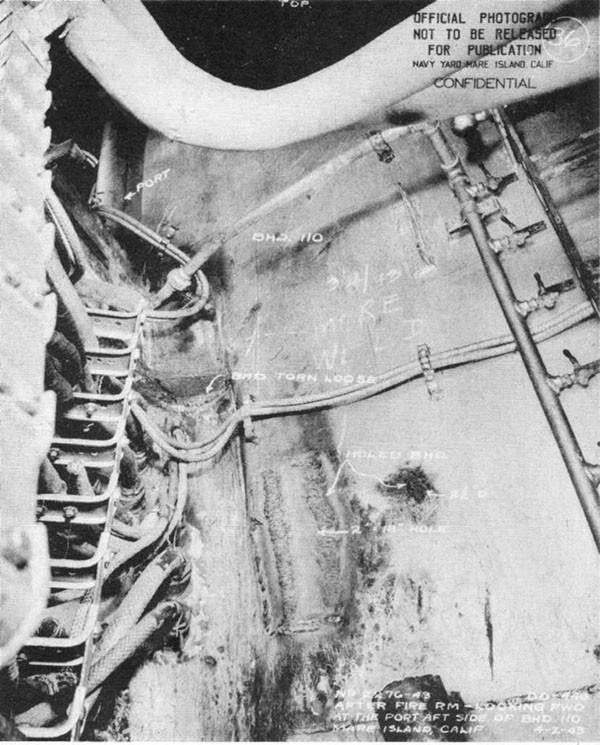
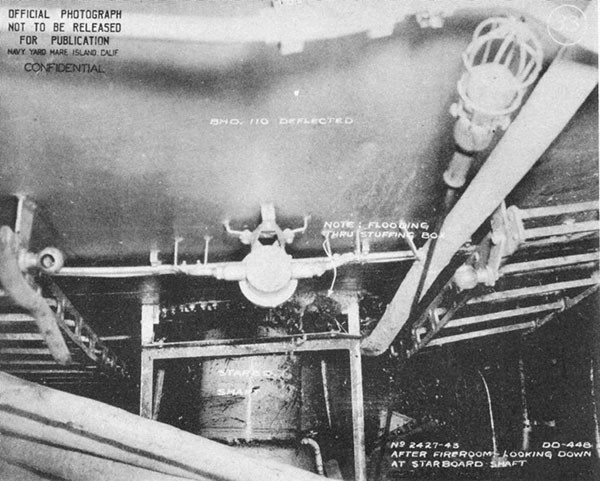
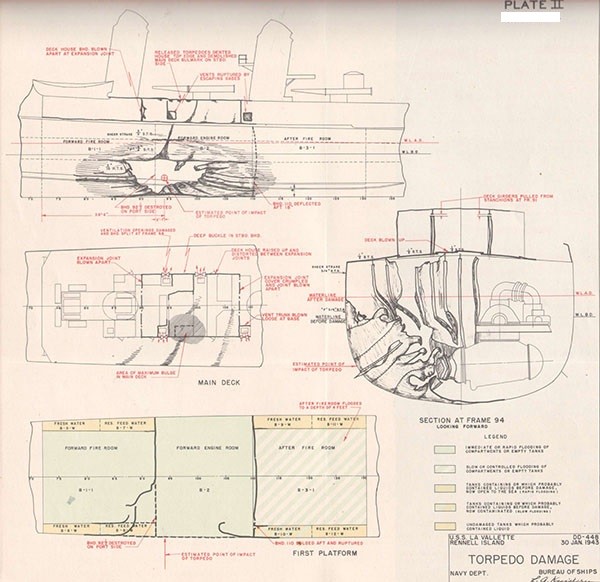
Loss in Action
Kula Gulf, Solomon Islands
5 July 1943
| Class | FLETCHER (DD445) | Length (O.A.) | 376 ft. 6 in. |
| Launched | 17 May 1942 | Beam (O.A.) | 39 ft. 4 in. |
| Displacement. (Standard) | 2100 tons | Draft (estimated, mean, prior to damage) | 13 ft. 1 in. |
References:
(a) C.O. STRONG ltr. A16-3/DD467 of 12 August 1943 (Loss Report).
(b) C.O. STRONG contingent ltr. DD467 of 6 July 1943 (Senior Unwounded Surviving Officer's Report of Loss).
(c) CO. O'BANNON ltr. DD450/A16 Serial 008 of 7 July 1943.
(d) CO. CHEVALIER ltr. DD451/A16-3 Serial 005 of 8 July 1943.
PLATE III
5-1. On the night of 4-5 July 1943, STRONG was a unit of a force composed of three light cruisers and four destroyers assigned to bombard Japanese positions on the islands of Kolombangara and New Georgia in the Solomon Group. The sky was overcast. The sea was moderate with a 12 to 15 knot wind from the northeast. Rain squalls occurred intermittently.
5-2. About 0000, 5 July, the force entered Kula Gulf and STRONG was the second ship in column. All four boilers were in use and the two machinery plants were completely split. Enemy positions on Kolombangara Island were bombarded first, followed by installations around Bairoko Inlet on New Georgia Island. At 0040, after completing the bombardment STRONG turned left to course 000 degrees true. At 0043, about one and one-half minutes after STRONG completed the turn, a torpedo struck and detonated on the port side in way of the forward fireroom at about frame 90.
5-3. The forward fireroom and engineroom flooded to the water line immediately. The after fireroom flooded more slowly. The vessel took an initial list of 15 degrees to starboard, away from the point of impact. All propulsion was lost but emergency electrical power remained available. About 29 minutes after being torpedoed, STRONG broke in two and sank.
5-4. The detonation blasted a large opening in the port shell, extending approximately from frame 80 to frame 100. The sheer strake and main deck plating to port of the midship deck house were destroyed in way of the hit. The midship deck house was distorted between frame 75 and the forward torpedo mount. On the starboard side of the main deck, in way of the after fireroom, the seam between the main deck stringer strake and the next inboard strake was split open. References (a) and (b) reported that a large hole was blown in the starboard side at about frame 90. Considerable difficulty was experienced in lowering the gig due to interference with side plating blown out below the gig davits.
5-5. In the main machinery spaces, bulkhead 92-1/2, separating the forward fire and enginerooms, was demolished completely. These forward two spaces flooded immediately. Bulkhead 110, separating the forward engineroom and after fireroom, was split on the starboard side and permitted slower flooding of the after fireroom. Bulkhead 72 apparently remained intact above the first platform, at least, for no flooding was reported in plotting room A-207C and the only damage reported in this compartment consisted of some blown fuzes. This bulkhead probably was intact below the first platform also, since the emergency diesel generator in compartment A-305-1E (on the second platform just forward of the forward fireroom) was able to operate successfully.
5-6. Immediately after the hit, the vessel acquired a 15-degree starboard list which gradually increased as the vessel settled in the water. There was also a noticeable sag amidships in way of the hit.
--24--
5-7. All ship's service electrical power was lost about one minute after the torpedo detonation, inasmuch as both firerooms were flooded. Emergency power supplied by the emergency diesel generator came on immediately and remained available until the vessel was abandoned. With the failure of the ship's service electrical power, the 5-inch main battery was temporarily inoperable, except in manual control. Within ten minutes, however, all except No. 5 mount were provided with emergency power. All boiler stop and bulkhead stop valves were secured. Steam pressure bled off all boilers either through main or auxiliary steam lines.
5-8. Telephone communications remained intact after the detonation except for communications with the after 40mm and 20mm mounts. With but few exceptions, all radio equipment was put back into operation immediately by shifting to emergency power. The transmitting antennas were destroyed, while the TBS transmitter and the antenna rotation control of the SC radar were inoperative.
5-9. Although fuel oil was spread over the water in the forward engineering spaces and on the surface of the water around the ship, no fires were started except for one of a very minor nature. This was a small fire that occurred in the after engineroom when a coil relay behind the after switchboard ignited. This fire was extinguished quickly with CO2.
5-10. At 0113, CHEVALIER (DD451) came alongside to port in order to remove survivors. The starboard side of the main deck of STRONG was then awash. About this time, a 140mm (5.5 inch) dud projectile from a shore battery on New Georgia Island struck the starboard side of the after 40mm splinter shield. The splinter shield was torn loose and thrown forward abreast No. 5 mount. About seven minutes later, STRONG began to settle more rapidly with an increased list to starboard. At 0122, (39 minutes after the torpedo hit) STRONG broke in two when the after end listed about 40 degrees to starboard. According to reference (c), STRONG appeared to split in the middle with the bow and stern going up in the air and sinking immediately thereafter. The two ends apparently sank bodily with a large starboard list. Shortly thereafter, three or four of the 300-pound depth charges in the starboard rack, which had depth settings of 50 feet, detonated, injuring survivors in the water.
5-11. The source of the torpedo which sank STRONG is not definitely known. The torpedo may have been fired by some submarine to the westward or north-westward of STRONG. Also, two enemy destroyers were believed to have left Kula Gulf at high speed at about 0040.
5-12. From the great extent of the structural damage as reported in reference (b), notably the hole in the starboard shell and the fore and aft split in the seam on the starboard side of the main deck, it appears that the warhead charge was unusually large. A comparison of the damage to STRONG with that incurred by HAMBLETON (DD455) also indicates that the detonation was considerably greater than the 660 pounds of German hexanite (equal in explosive power to approximately 860 pounds of TNT)
--25--
which appear to have caused the damage to HAMBLETON (paragraphs 3-6 and 3-23). Since no Japanese submarine (including midget submarine) torpedo is know to contain more than about 880 pounds of explosive, it appears quite probable that one of the large 24-inch long-range destroyer torpedoes caused the damage. The torpedo may have been one of the "Type 93" which are fitted with warhead charges containing about 1096 pounds of "Type 97" explosive.
5-13. Although little time was available for a thorough inspection by the ship's officers, the damage which was observed and reported in references (a) and (b) indicates that the structural damage sustained by STRONG was the most severe incurred by any destroyer struck by one torpedo for the period covered by this report. This is the first instance in which the side opposite a torpedo detonation in way of machinery spaces has been reported ruptured. Although the extent of the rupture on the starboard side was not observed, the opening undoubtedly was large since difficulty was encountered in lowering the starboard motor whale board due to the interference of the shell plating blown outboard. The fore and after extent of structural damage was also unusually severe. Bulkhead 110, approximately 35 feet aft of the estimated point of impact, was ruptured despite the presence of an intervening bulkhead (91-1/2). The condition of bulkhead 72, approximately 31-1/2 feet forward of the estimated point of detonation, was not reported but also probably was damaged enough to permit some slow flooding forward. Damage to the main deck also was extensive. It will be noted that the port main deck stringer strake of 1/2-inch STS, was destroyed by way of the hit.
5-14. STRONG's loss was caused primarily by extensive destruction of the hull girder, rather than by flooding. Under the circumstances, there was little which could be done to saver her.
--26--
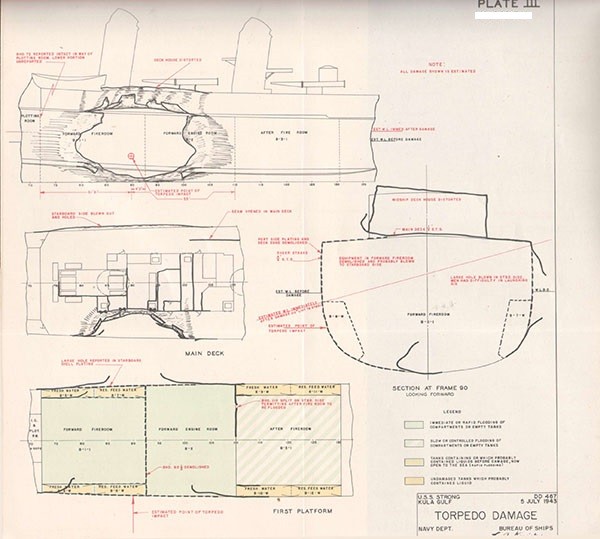
Mine Damage
Off Kiska Island, Alaska
18 August 1943
| Class | FLETCHER (DD445) | Length (O.A.) | 176 ft. 6 in. |
| Launched | 18 August, 1942 | Beam (O. A.) | 39 ft. 4 in. |
| Displacement Standard | 2100 tons | Drafts (Prior to damage) | |
| Forward | 13 ft. 1 in. | ||
| Aft | 14 ft. 1 in. |
References:
(a) C.O. ABNER READ ltr. DD526/A16-3, Serial 006, of 26 August, 1943 (Action Report).
(b) C.O. ABNER READ ltr. DD526/A16-3, Serial 009, of 28 August 1943 (War Damage Report).
(c) C.O. MARKAB ltr. AD21/DD526/L11-1/A-9, Serial 036, of 7 September 1943 (Repair Report).
(d) Comdt. NYPS ltr. DD526/L11-1(M-22) of 27 November 1943 (Supplementary War Damage Report).
(e) C.O. WADLEIGH ltr. DD689/A9-8/S1-1/eam of 3 December 1944 (Report of War Damage).
(f) C.O. ROSS ltr. DD563/A9/A16-3 of 1 November 1944 (Report of War Damage).
(g) C.O. MEREDITH ltr. A16/A9 of 20 June 1944 (Report of Loss).
Photographs Nos. 28 through 39 (furnished by the Commanding Officer, ABNER READ, and the Navy Yard, Puget Sound.
PLATE IV
6-1. On the night of 17-18 August 1943, ABNER READ Was on an anti-submarine patrol off Kiska Island, screening vessels anchored in the vicinity. The patrol line assigned to ABNER READ ran directly toward and away from the beach. The shoreward end as assigned was about 2000 yards from an area labeled "possible Japanese mine fields" off Bluff Cove, but was shortened arbitrarily 2000 yards that night in order to keep outside the 50-fathom curve and to afford a greater margin of safety in case of a late turn. The vessel was darkened and condition of readiness TWO and material condition BAKER were set. Degaussing was in operation. Boilers Nos. 2 and 4 were in use, with oil suction forward on A-3F and aft of C-1F. The two propelling plants were completely split. Speed was 5 knots. The sea was calm, with a 1/2-knot current running from 295 degrees true. The wind was from the south, force 2. The moon could be seen at intervals through a cloudy sky, intermittent fog patches and mist. Visibility was about 2000 yards.
6-2. At 0150, 18 August 1943, while making a turn with full right rudder at the shoreward end of the patrol line, the stern of ABNER READ apparently struck and detonated a drifting mine on the port side of the stern at about frame 190, about 14 feet aft of 5-inch powder magazine C-305-M. The depth of the water was reported to be about 51 feet. No flash nor flame was observed, and no fires resulted. A geyser of water about 40 feet high was observed on the port side. The shock effect was not serious. Flexural vibration, however, was present and caused extensive damage of a minor nature. The port shaft stopped immediately and the starboard shaft froze in about 2 minutes. The ship listed at once about 4 degrees to port and changed trim a small amount by the stern.
6-3. Immediately after the detonation, the General Alarm was sounded and all hands were called to their battle stations. The word was passed "do not abandon ship" after men were reported to be in the water. Fumes of FS smoke from ruptured generator tanks caused a number of casualties and interfered with damage control measures. About 4 minutes after the detonation, the stern broke off at frame 170 and sank. ABNER READ then was towed to Adak for temporary repairs (photo 28).
6-4. Although the port shaft stopped immediately as a result of the detonation, the starboard shaft continued to operate at 50 r.p.m. However, in about 2 minutes as the decks, shell, and strength members began to fail at frame 170, the starboard shaft froze. A heavy thumping noise developed in the starboard reduction gear and the engines were stopped. At 0154, 4 minutes after the detonation, failure at frame 170 was complete and the stern, including 5-inch gun No. 5 and the steering gear, drifted aft and sank immediately (photo 28). A subsequent examination of the hull at Adak revealed that the port shaft had broken at frame 170 (photos 29 and 30). The starboard propeller nut apparently split, allowing the after strut and propeller to slip off the starboard tail shaft, as evidenced by the absence of scoring of threads (photo 32). Sinking of the stern apparently caused the bending and freezing of the starboard shaft (photo 31). Because of the rapid loss of the stern aft of frame 170, details of the local structural damage caused by the detonation were not
--27--
observed. All depth charges had been set and checked on "safe" after dark and there were no explosions when the stern sank. All remaining depth charges were checked and found to be on "safe". The watertight doors, hatches and manhole covers that were not directly damaged held up excellently.
6-5. The damage from flexural vibration, although not serious, was extensive. Aluminum bunk hooks both in the vicinity of the detonation and in the forward end of the ship straightened out, causing numerous bunks to fall, cutting and trapping many men. Supplies and equipment in forward stowage spaces were cast about and disarranged. Battens and stanchions in 5-inch projectile stowages A-407-M, A-409-M and A-301-M and in the upper handling room powder tank stowages of all 5-inch mounts were bent and twisted. A few welds in A-407-M failed. About ten 5-inch powder tanks and cartridges in A-406-M were distorted. All 5-inch projectiles stowed on bulkheads in the upper handling room of No. 1 mount were thrown to the deck. In addition, the keel and the lower longitudinals between frames 134 and 135 were buckled (photos 35 and 36) and the hull plating was wrinkled on the starboard and port sides up to about the 9-foot waterline. The slip joints in the catwalk and midship deck house structure showed evidence of extreme flexure. The gyro in A-207-C stopped when the suspensions failed, allowing the sensitive element to drop to the phantom ring. The sound gear became inoperative when two high voltage fuzes between the generator and driver were blown, but the gear functioned properly upon replacement of the fuzes.
6-6. Nos. 2 and 4 boilers were not damaged by the detonation. However, fires under No. 4 boiler were extinguished by sea water from contaminated service tank C-1F. This tank was contaminated from fuel oil tank C-8F thru tank C-4F, by means of the sluice valve between tanks C-8F and C-4F which was jammed open about 2 turns. Contamination of C-4F resulted in contamination of fuel oil tank C-1F through the sluice valve which was normally open. In anticipation of such an occurrence, steps had been taken immediately after the detonation to shift fuel oil suction for No. 4 boiler to a forward tank. This was done and No. 4 boiler was relighted immediately. There were no casualties to the electrical system although numerous branch circuits tripped automatically, due to grounds. Casualty power was connected up in the event that portable electric submersible pumps and portable lights should be required. Since all means of propulsion were lost, No. 4 boiler was secured about 25 minutes after the detonation, leaving No. 2 to handle the auxiliary load.
6-7. The flooding which occurred in the portion of the ship which remained is shown on Plate IV. Except for a minor rupture in bulkhead 157 that allowed water to enter C-7F from C-9F, the hull was watertight from bulkhead 157 forward. Aft of this bulkhead only C-302-M was watertight and unflooded. Compartments C-203-L, C-303-M and fuel oil tanks C-8F and C-9F were open to the sea. C-301-M on the second platform flooded slowly to a depth of 3 feet through watertight door 2-157-2 which had been opened to permit personnel to escape from the living spaces aft. When the door was closed, a blanket caught in the door and prevented complete closure. The blanket was removed subsequently and the door closed properly. The water was removed by bucket brigade and the use of a gasoline handy billy pump. There was a small amount of water about 2 inches deep in compartment C-201-L which entered when the door in bulkhead 157 was opened to permit personnel aft to escape. Prior to damage, the drafts had been 13 feet 1 inch forward and 14 feet 1 inch aft. Immediately after damage, the drafts were 12 feet 7 inches forward and 15 feet 1 inch aft at frame 160. The initial list after damage was about 4 degrees to port. Action was taken promptly to establish flooding boundaries, remove as much of the water as possible, and bring the vessel to an even keel.
--28--
Bulkhead 157 was shored in crew's quarters C-201L and workshop C-202E (photo 34). Fuel oil in the forward tanks was shifted athwartships to remove the 4-degree port list. Fuel oil was pumped from aft to forward to improve the trim.
6-8. Although fuel oil was released by the detonation, no fires occurred. The "smoking lamp" was extinguished and this safety precaution was enforced rigidly. The after fire main, which had been broken at frame 170, was restored to service by closing the valve at the after bulkhead of the after engineroom.
6-9. Because ABNER READ was damaged close to the suspected mine field and a 1/2-knot current was moving the ship in that direction, it was imperative that ABNER READ be taken in tow immediately. BANCROFT (DD598) which was patrolling in the vicinity came alongside and commenced preparations for towing. At 0300, ABNER READ was taken in tow. At 0440, towing was transferred to UTE (AT76), using UTE's 2-inch main tow wire and 75 fathoms of ABNER READ's anchor chain. The tow proceeded to Adak and arrived on 19 August 1943.
6-10. ABNER READ was tied up alongside MARKAB (AD21) in order to permit the removal of loose wreckage, torpedoes and 5-inch mount No. 4. Additional shoring on bulkhead 157 was installed by the repair force of MARKAB. On 20 August, ABNER READ was docked in YFD22 for further temporary repairs. Difficulty was encountered in docking because the starboard shaft aft of the stern tube coupling was bent out of line about 10 feet (photo 31). First, the shaft had to be rotated 180 degrees by the jacking gear, with the initial force applied by a crane. ABNER READ then was docked and the underwater wreckage was removed. The starboard shaft was cut immediately forward of the stern tube coupling. No. 4 ammunition hoist assembly was removed and the oil was cleaned from compartments open to the sea. No temporary repairs were undertaken due to the urgent need of the dock for repairs to LSTs. Accordingly, ABNER READ was towed by TATNUCK (AT27) to Dutch Harbor for temporary repairs prior to the trip to Navy Yard, Puget Sound. At Dutch Harbor, a temporary watertight bulkhead was installed at frame 168-1/2 (photo 37). A temporary rudder was designed and installed (photos 38 and 39). ABNER READ then was towed from Dutch Harbor to Navy Yard Puget Sound where permanent repairs, together with authorized alterations, were accomplished. ABNER READ returned to service on 6 December 1943.
6-11. The rapid loss of the stern prevented detailed observation of the damage. Accordingly, the weapon causing the damage cannot be identified with certainty. The circumstances of the attack, however, make a torpedo hit improbable. Damage therefore is concluded to have been caused by a mine detonation. This mine probably struck the port shaft, port propeller, or counter. The fore and aft position of the center of detonation has been estimated as being at frame 190. Subsequent to the damage incurred by ABNER READ, eleven mines were recovered in the area that had been patrolled by ABNER READ. All of these mines were of the Japanese moored contact type known as "Type JB". Such mines contain 220 pounds of "Type 88" explosive. Data contained in captured Japanese documents indicate that this explosive is more destructive than TNT. In view of the fact that all mines recovered were of the same type, it is concluded that damage to ABNER READ probably occurred from the type of mine discussed above. However, the amount of damage appears more extensive than normally would be expected from a mine of this size.
--29--
6-12. Apparently, the detonation lifted the stern and caused a tension crack in the bottom plating and compression buckles in the upper portion of the shell plating and main deck at frame 170. The stresses at this point may have been augmented by the flexural vibration which occurred as the result of the detonation. Flooding of ruptured compartments aft added sufficient weight to the stern to cause rupture of the remaining effective plating and longitudinals at frame 170. The stern then drifted aft, sliding off the starboard shaft, and sank. The failure at frame 170 does not denote a structural deficiency in the longitudinal strength of the 445 class destroyer. This type of failure will in all probability occur only when a mine or torpedo detonates under the stern in a location close to that of ABNER READ.
6-13. Flexural vibration as discussed in paragraph 6-5 caused aluminum bunk hooks to straighten out, permitting bunks to fall. This resulted in many injuries. On the basis of this and other cases of war experience, type plans for crew's, CPO's and hospital bunks have undergone thorough revision, including the use of steel instead of aluminum for hooks.
6-14. There were no fumes from the detonation itself. However, several FS smoke generator tanks were blown forward. Fracture of these generators permitted liquid FS to escape and caused many casualties to personnel from burns and suffocation. The smoke formed a blanket which enveloped the stern from about frame 168 aft, penetrated the damaged living spaces and hindered rescue of personnel from the rapidly sinking stern. According to Ordnance Pamphlet No. 1042 of 25 September 1943, "Ships Chemical Smoke Munitions", gas masks should be worn where high concentrations of FS smoke exist.
6-15. Two recent cases of mine damage, for which complete reports have not yet been received, give further indication of the ability of 2100-ton destroyers to withstand combinations of severe structural damage and extensive flooding. On 16 September 1944, WADLEIGH (DD689) was engaged in mine demolition operations inside Kossol Passage, Palau Islands. The depth of water was about 12 fathoms. At 1428, while making a speed of 15 knots, she struck a mine which detonated on the starboard side in way of the after fireroom at about frame 113 midway between the starboard bilge keel and vertical keel (reference (e)). The mine had a reported explosive charge of about 800 pounds. No flame or smoke was noted. The shock effect was extensive, but not serious except for the loss of the SC-2 radar antenna. No general flexural vibration was noted. There were no fires. The forward engineroom and after fireroom flooded to the waterline immediately. The after engineroom flooded completely in about 2 minutes from the after fireroom through the starboard shaft bulkhead stuffing gland. Some water also appears to have entered from C-5E, the starboard shaft stuffing box compartment, through the shaft gland in bulkhead 148. All propulsive and electrical power (except for the emergency diesel generator) was lost. The ship took an initial list of 5 degrees to starboard, but was brought upright within about two hours. The reported drafts were 13 feet forward and 14 feet aft prior to damage and 16 feet forward and 17 feet 6 inches aft following the damage. WADLEIGH was towed away safely for temporary repairs.
6-16. The rupture in WADLEIGH's shell was roughly elliptical in shape, with maximum dimensions of about 28 feet longitudinally by about 19 feet along the girth. The hole extended from frames 106 to 122 and from the starboard bilge keel to a point about 1 foot to port of the vertical keel at frame 112. At frame 110, the vertical keel was displaced 3 feet 3 inches to port and pushed upward 3 feet 5 inches. In addition, there also was a transverse crack at frame 112, extending 8 feet above the starboard bilge keel and 4 feet 4 inches above the port bilge keel. The vertical keel, both bilge keels, 9 starboard longitudinals and 7 port longitudinals were broken.
--30--
Thus, the entire bottom flange of the ship girder was, in effect, destroyed. The main deck was buckled to a height of 2 inches, but was otherwise intact. Calculations indicate that the section modulus of the remaining effective structure below the neutral axis was reduced to about 14 per cent of the original section modulus to the bottom of the keel, while the section modulus above the neutral axis was reduced to about 37 per cent of the original. In spite of this severe reduction in section modulus and the flooding of three main machinery compartments, the vessel survived. Undoubtedly, favorable sea conditions were an important factor in her survival.
6-17. During the night of 18-19 October 1944, ROSS (DD563) was escorting a group of minesweepers along the swept channel in Leyte Gulf, Central Philippines (reference (f)). The depth of water was about 30 fathoms and speed was 4 knots. At 0133, about one minute after commencing a turn of 90 degrees to the right to retrace her track along the swept channel, ROSS struck a mine which detonated in way of the forward fireroom at about frame 91 about 11 feet to port of the keel. At 0155, ROSS struck a second mine which detonated directly under the keel at about frame 151, a few feet aft of the after engineroom. A dim, yellowish-orange flash was observed from each of these detonations. No smoke was noted. The shock effect was extensive but not serious except for the master gyro compass which was seriously damaged and the SC radar antenna which snapped loose. There was a general flexural vibration of the hull, but no permanent distortion was noted. There were no fires. Each mine had a reported explosive charge of 400 pounds. Both enginerooms were flooded and all propulsive and ship's service electrical power were lost. ROSS was taken in tow for temporary repairs. Later, while anchored in the vicinity of Mariquitdaquit Island, ROSS shot down two Japanese aircraft, and without further damage rode out a typhoon with winds of 75 knots on the night of 29 October 1944.
6-18. The first mine blew a hole in the port shell that was reported in reference (f) to have been about 45 feet long by about 18 feet along the girth. The second mine caused a rupture about 18 feet long by about 20 feet in girth in way of the vertical keel between frames 146 and 156. The forward engineroom, forward fireroom, after engineroom and several after compartments and tanks were flooded. Minor leakage into the after fireroom was controlled by pumps. Because of the flooding, the vessel listed to port, the list increasing slowly to 14 degrees. Damage control measures slowly reduced this list to zero. The reported drafts were 12 feet 4 inches forward and 14 feet 5 inches aft prior to damage, and about 17 feet 9 inches forward and 21 feet 4 inches aft subsequent to damage. The main deck aft on the low side was awash.
6-19. It can be seen that extensive flooding and structural damage sharply reduced the stability, reserve buoyancy, and strength of ROSS. Yet, she still was able to shoot down two enemy planes and ride out a storm. It is problematical whether WADLEIGH, with much greater reduction in section modulus, but somewhat less flooding, could have survived such unfavorable sea and weather conditions.
--31--
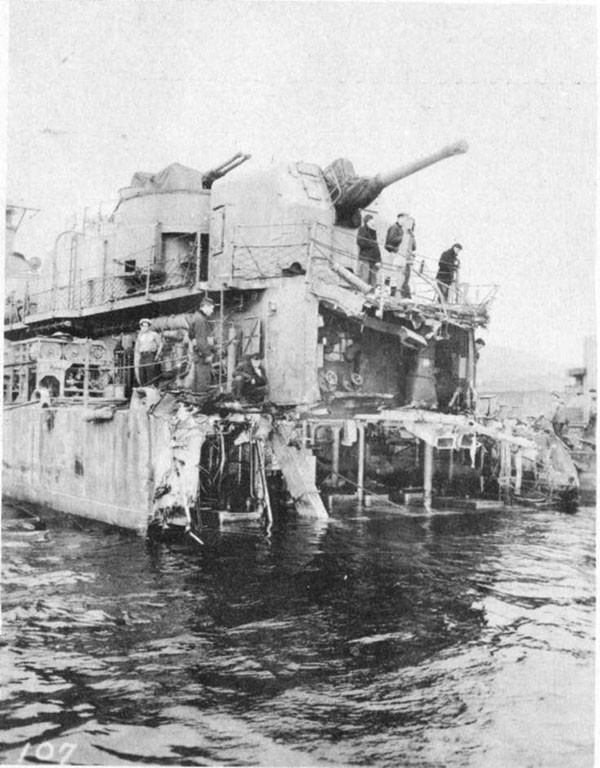
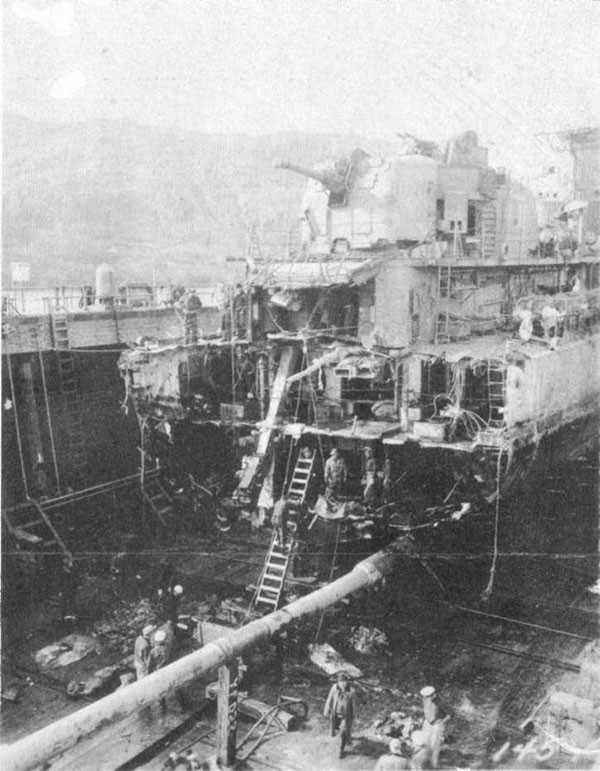
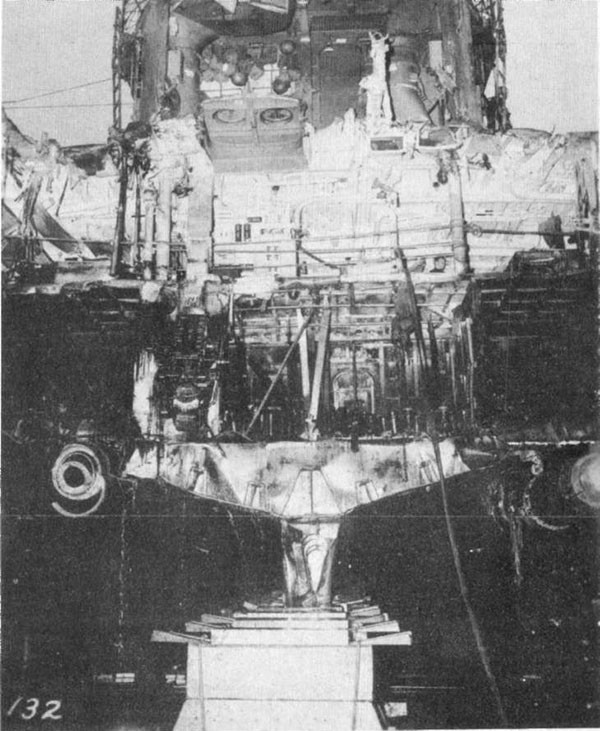
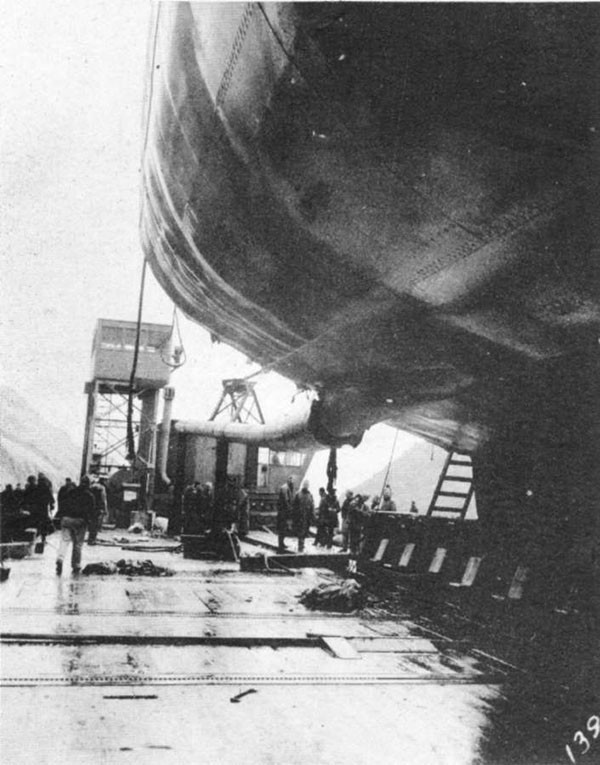
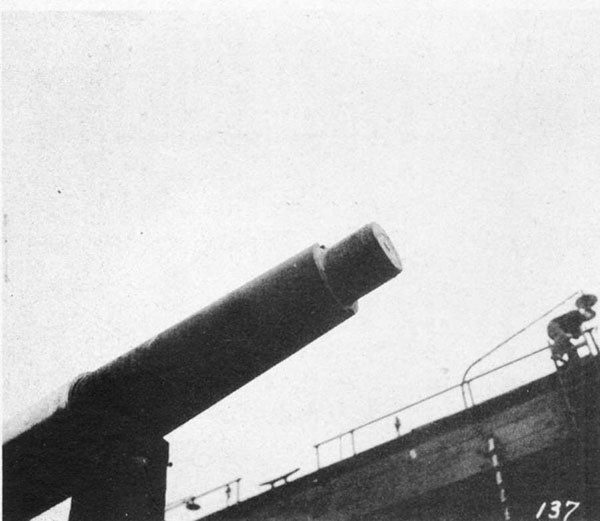
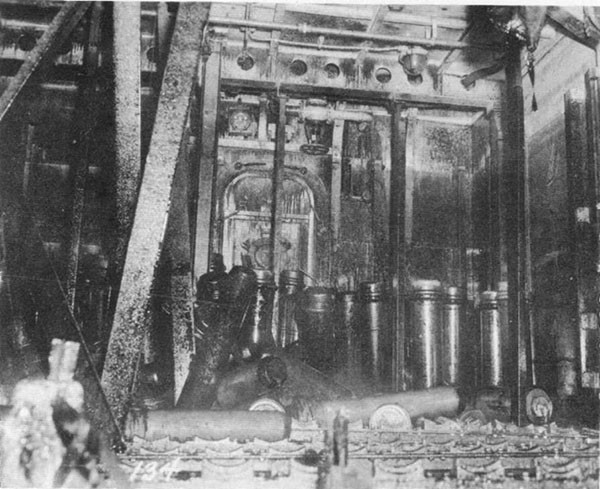
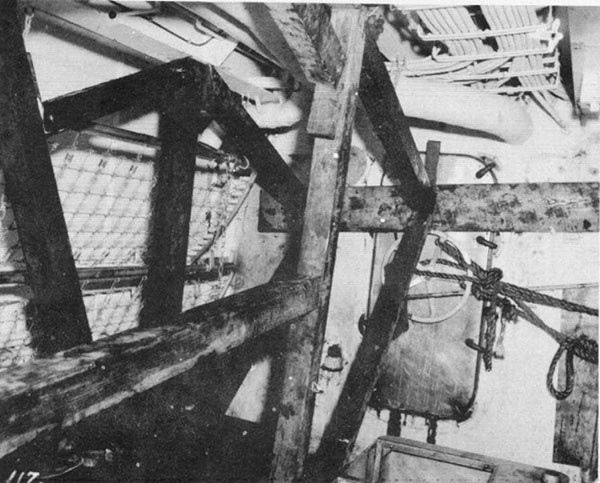
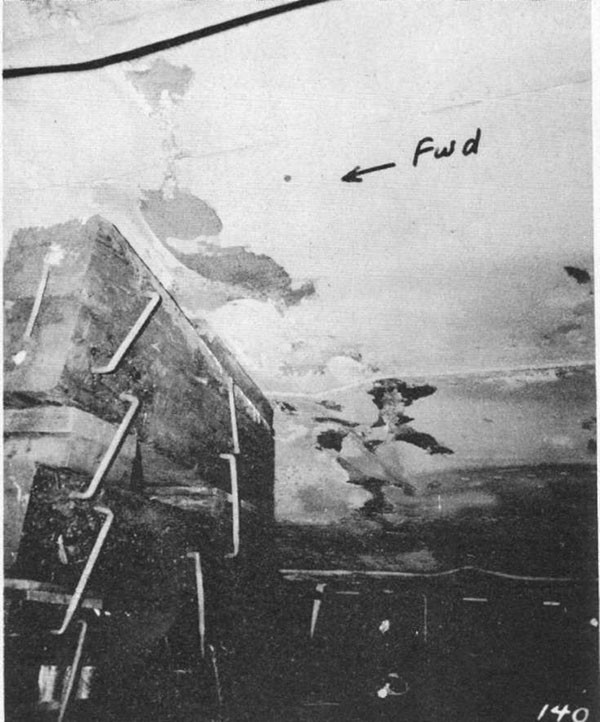
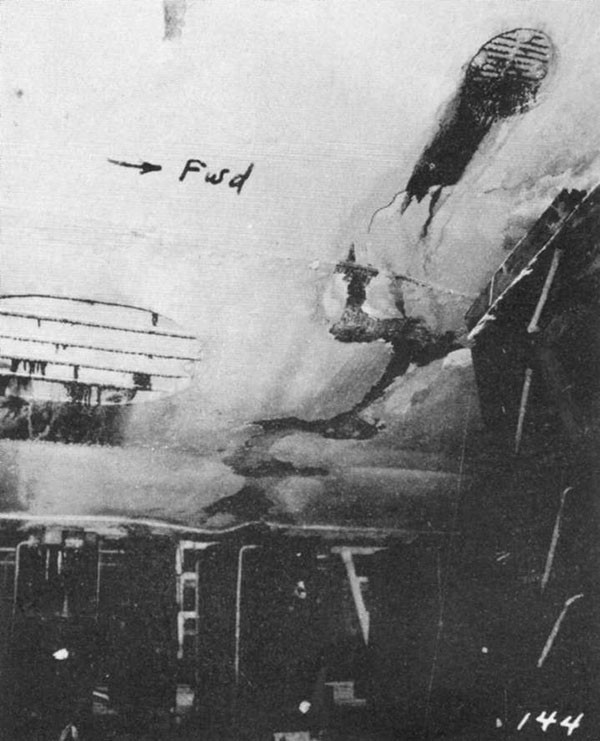
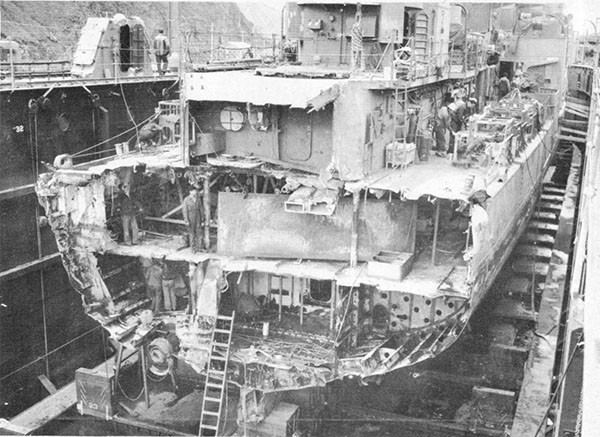
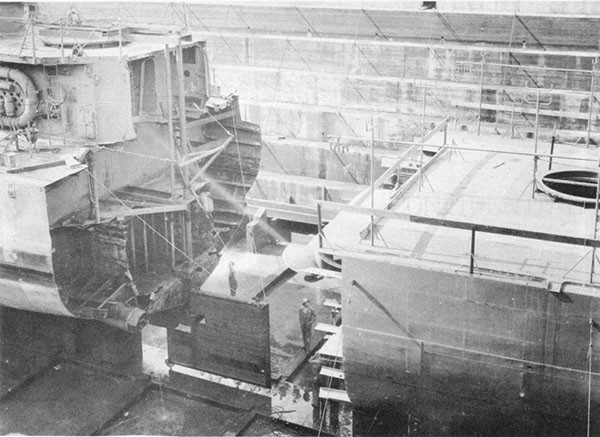
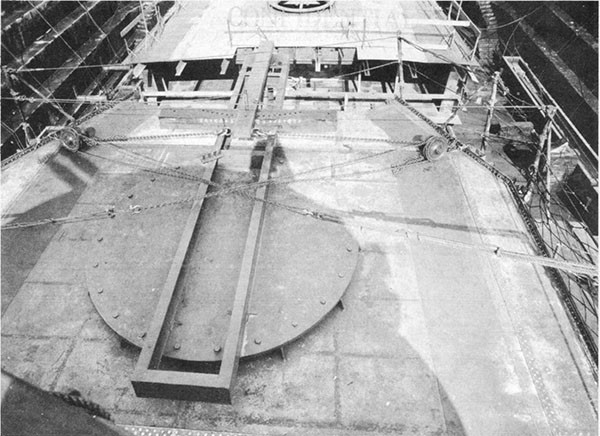
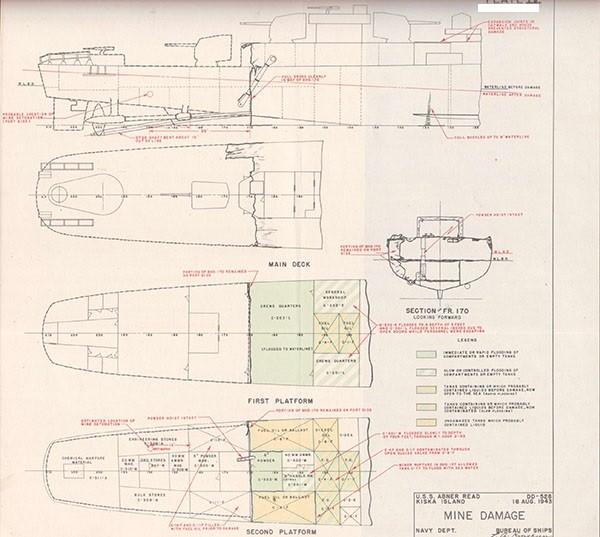
Torpedo Damage
Northwest African Waters
2 September 1943
| Class | LAFFEY (DD459) | Length (O.A.) | 348 ft. 4 in. |
| Launched | 2 April 1942 | Beam (O.A.) | 36 ft. 0 in. |
| Displacement (Standard) | 1620 tons | Drafts (prior to damage) | |
| Forward. | 13 ft. 6 in. | ||
| Aft | 13 ft. 9 in. |
References:
(a) C.O. KENDRICK ltr. DD612/L11-1, Serial 077 of 5 September 1943 (Action Report).
(b) C.O. KENDRICK ltr. DD612/P13-5, Serial 079 of 6 September 1943 (War Damage Report).
(c) C.O. KENDRICK ltr. DD612/S25, Serial 085 of 26 October 1943 (Report of Towing Operations).
(d) Comdt. Navy Yard, Norfolk ltr. DD612/L11, Serial 0100, of 1 January 1944 (Supplementary War Damage Report).
Photographs Nos. 40 through 48 (furnished by the Commanding Officer, KENDRICK and Navy Yard, Norfolk).
PLATE V
7-1. On the evening of 2 September 1943, KENDRICK, while an escort unit of a convoy, was patrolling astern the convoy in an area about 100 miles east of Oran. The sea was calm and visibility was about 5 miles with intermittent fog banks.
7-2. At 2109, after twilight, the convoy was attacked by German aircraft. At the time, KENDRICK was steaming on course 045 at 12-1/2 knots. At 2114, two torpedoes were launched by Heinkel 111's, from about 1500 yards on the starboard quarter. KENDRICK swung hard left to course 020 in order to "comb" the torpedo tracks. One torpedo missed to port, but the other struck and detonated against the rudder. The detonation destroyed the rudder and steering gear and severely damaged the stern aft of frame 183 (photo 40). The shafts were out of alignment, but the propellers were undamaged and the engines functioned normally. The shock from the torpedo detonation was not severe. No geyser of water was observed. Flexural vibration was present. There was one minor electrical fire which was extinguished quickly. There was no list, but a slight change in trim by the stern resulted. Two depth charges thrown off the stern detonated about 150 yards astern of KENDRICK. The speed dropped to 10 knots immediately after impact, but was brought back to 12-1/2 knots within 2 minutes.
7-3. KENDRICK kept her position in formation until 2130 when she was ordered to return to Oran. Throughout this period, she maintained a speed of 12-1/2 knots steering by the engines. The return trip of 100 miles to Oran for temporary repairs was made under her own power. The average speed was about 6-1/2 knots as higher speeds were found to cause excessive vibration and working of weakened bulkheads.
7-4. The torpedo, which came from almost directly astern, apparently struck the trailing edge of the rudder, which was positioned amidships. As shown on Plate V, the stern aft of bulkhead 183 was blown sharply upward with a knuckle in the bottom plating at frame 183 (photo 41). There were deep buckles in the main deck and first platform at frame 174. There were deep compression wrinkles and tears in "F" strake on both the port and starboard sides (photo 42). Interior longitudinal bulkheads were also wrinkled and ruptured (photo 44). Small compression wrinkles were present as far forward as frame 137. The primary effects of the detonation were directed upward, blasting holes about 14 feet in diameter in the bottom plating, first platform and main deck (photo 41). The sheer strakes on both sides were badly crumpled but intact except for at the extreme stern (photo 40). Bulkhead 183 was badly buckled but intact except for minor weld failures at the lower boundary. Two watertight doors in this bulkhead on the first platform were blown out (photo 43). Bulkhead 171 (a stepped bulkhead) was intact except for a 12-inch crack in a weld on the port side near the centerline at the first platform. Quick-acting door 2-171-1 in this bulkhead was damaged slightly and leaked. Structural damage to KENDRICK thus was not extensive.
7-5. Some flexural vibration of the hull occurred. There were small wrinkles at the foot of bulkheads 103 and 123 and some slight damage to the amidships deck house. All radio antennas (except TAJ) snapped. Emergency radio aft was without power. There were no other failures of communications, radar or gyro.
7-6. The machinery damage consisted essentially of misalignment of the propeller shafts. The propellers suffered only minor damage although they were within 16 feet of the detonation. The lifting of the stern resulted
--32--
in the starboard tail shaft being out of alignment a maximum of 1-11/16 inches (photo 47), at the after strut. The port shaft was out of alignment only about 3/8-inch. As a result there was some damage to shaft bearings and journal sleeves (photo 46) while underway. The extent of the bearing damage was limited to excessive wear on the rubber bearing strips and the bearing retainers of the strut and stern tube bearings and also on the bearing metal of the spring bearings. Bulkheads 103 and 123 were wrinkled in way of the shaft stuffing boxes (Plate V). The fact that KENDRICK could return to port under her own power is additional evidence of the general ruggedness and high resistance to damage of propeller shafts and propellers. Similar experience on other classes of vessels is found in the cases of PENSACOLA*, CAPELLA**, and ALHENA**.
7-7. The after 5-inch gun was without power but all other guns and the director functioned normally in automatic control. The torpedo tubes were blocked temporarily until the fallen radio antennas were cleared. The depth charges and racks were blown overboard.
7-8. Immediately after the detonation, there was a small electrical fire in the steering gear compartment when cable insulation ignited, the result of a short circuit. Power was removed immediately from this circuit and a portable CO2 extinguisher smothered the fire in about one minute.
7-9. Flooding resulting from the detonation is shown on Plate V. Compartments aft of bulkhead 183 were open to the sea. Compartment C-311-A flooded through ruptures around the longitudinals in bulkhead 183. Bulkhead 183 was watertight above the first platform, but C-204-L flooded through holes in the buckled shell plating. Additional compartments below C-204-L were flooded through open hatches and cracks in buckled bulkheads. There was slight flooding through bulkhead 171 and C-305-M, well forward of the damage, flooded slowly through cracks in the shell around the palms of the forward struts.
7-10. The reported drafts were 13 feet 6 inches forward and 13 feet 9 inches aft prior to damage, and 12 feet 6 inches forward and 14 feet 9 inches aft subsequent to damage. However, the statement in reference (b) that C-204-L flooded to a depth of 30 inches at frame 172 indicates the draft aft following damage was probably about 15 feet 6 inches. No list developed. Immediately after the damage, bulkhead 171 was shored on the forward side from No. 4 upper handling room (C-203-LM). Quick-acting door 2-171-1 on the starboard side was caulked with oakum. Smoke and fumes from steering gear compartment C-205-E at first interfered with damage control efforts in C-204-L, requiring the use of rescue breathing apparatus. About 5 minutes after the detonation, the air in C-204-L cleared and more men entered the compartment. Since C-204-L was partially flooded, pillows and blankets were inserted in the cracks in the shell close to the deck. Two gasoline-driven handy billy pumps were able to keep even with the water entering C-204-L. About 25 or 30 minutes after the detonation, a portable electric submersible pump was substituted for the handy billy pumps. A second portable electric submersible pump was employed also and C-204-L was dewatered in about 8 hours. Water next was partially removed from C-307-M. Pumping then was secured until arrival at Oran. About an hour after the detonation, the leak in bulkhead 171 was welded. The water (2 inches deep) in C-203-L was removed completely. About an hour after the hit, it was discovered that A-201-2A was flooded completely due to the failure of the priming line to the forward semi-fixed submersible pump. The line had been fractured, apparently when stores had been moved. The firemain forward of frame 25 was secured. The water in A-201-2A was not removed until arrival at Oran.
_____________
*Buships War Damage Report No. 35.
**Buships War Damage Report No. 27.
--33--
7-11. It required about one-half hour to put the portable electric submersible pumps in operation because the portable leads were too short to reach the nearest receptacles. On the basis of this and other cases of war experience, the allowance has been increased from one to two 75-foot lengths of portable cable for each portable electric submersible pump.
7-12. At Oran, KENDRICK was placed in dry dock to receive temporary repairs before proceeding to the United States. All structure aft of frame 183 was removed. Damaged structure forward of this point was temporarily replaced and a temporary bulkhead was erected across the stern (photo 48). It was determined that the misalignment of the propeller shafts was too great to permit passage to the United States. Accordingly, the propellers were removed. A temporary rudder then was rigged on the new stern.
7-13. The temporary rudder was designed by the Commanding Officer of KENDRICK and was installed by the repair forces at Oran. The control of this rudder was unique in that it utilized 5-inch mount No. 4 (to which power had been restored) as the source of steering power (photo 48). The rudder was constructed from 3/8-inch plating and reinforced by three small I-beams. The stock was made from a broken LST shaft, and was hinged at bulkhead 183 by three gudgeons and pintles. A 20-foot athwartship cross-bar was installed at the end of the rudder stock just above the main deck. Connections were made from each end of the crossbar to the training circle of No. 4 mount by using 3/4-inch wire cable. The rudder angle could be controlled by the Commanding Officer from the bridge. The connections of the control cables at the mount were designed so that they could be disconnected readily if the mount were needed.
7-14. After these temporary repairs, KENDRICK was towed to Navy Yard Norfolk by the W.S.A. tug POINT LOMA. Some difficulty was experienced on three separate occasions due to partial failure of the towing rig. This trouble resulted from the wearing of the chain in the bull nose. KENDRICK arrived at Navy Yard Norfolk 4 September 1943. At Navy Yard Norfolk the damage was repaired and many authorized alterations were accomplished. KENDRICK returned to service on 1 January 1944.
7-15. Damage to KENDRICK was not extensive compared with that which has been incurred by other destroyers suffering torpedo hits. The small extent of damage undoubtedly was due to the location of the point of impact on the trailing edge of the rudder, a location so far aft that a large portion of the explosive energy was dissipated more or less harmlessly. The deflection upward of the stern rather than complete destruction has been paralleled in many cases on escort vessels where the point of impact was at the extreme stern.
7-16. Temporary repairs made at Oran were thorough and complete. The temporary rudder was particularly ingenious and proved thoroughly satisfactory.
--34--
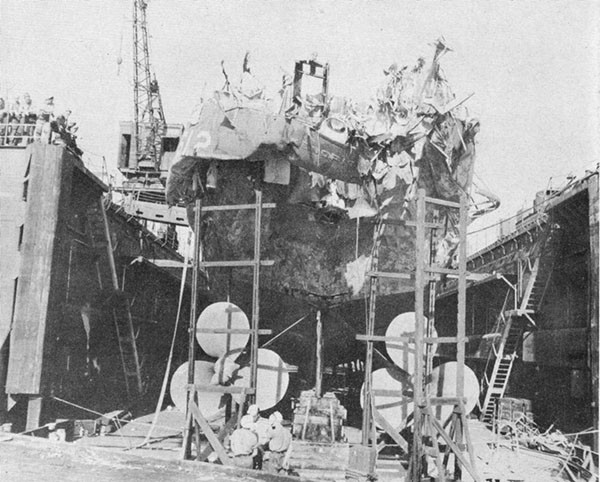
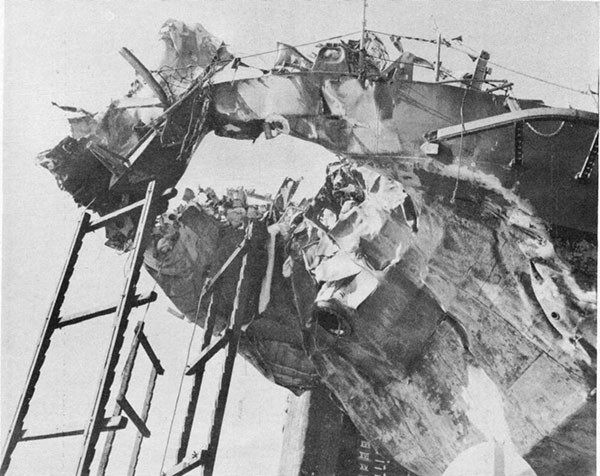
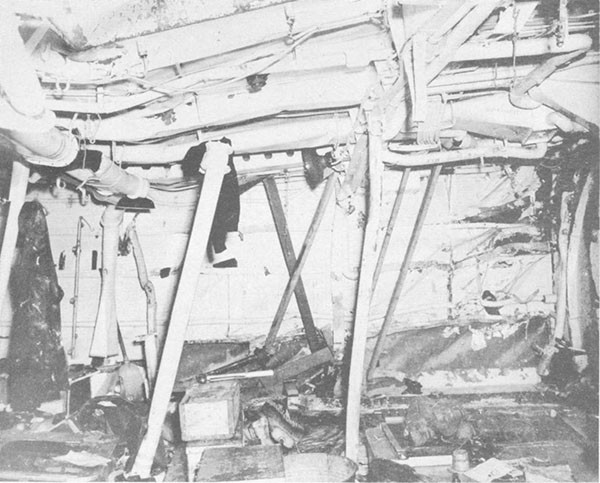
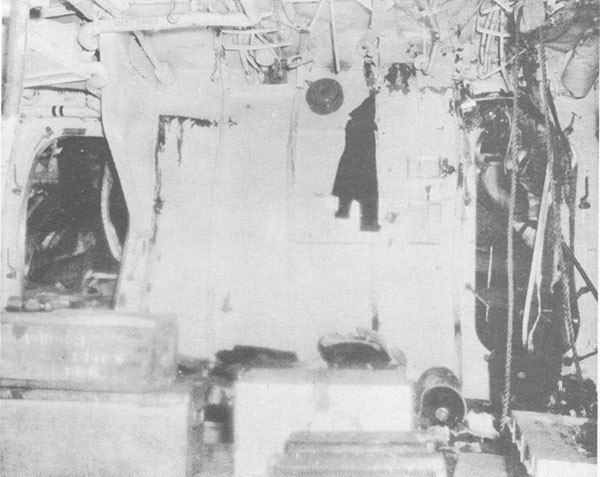
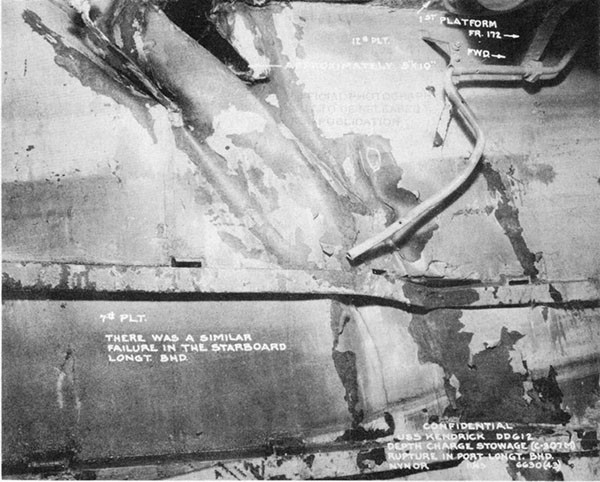
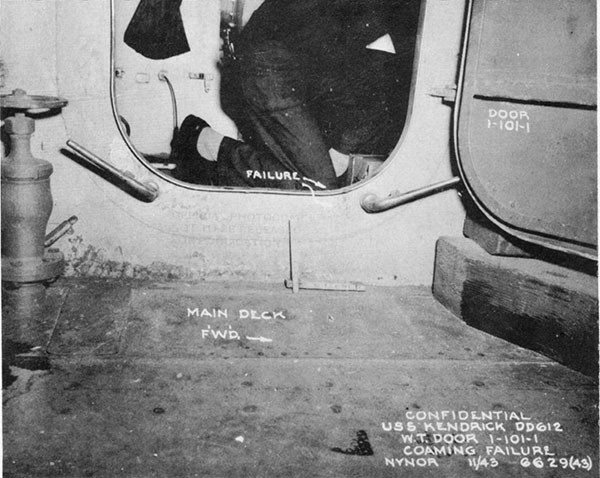
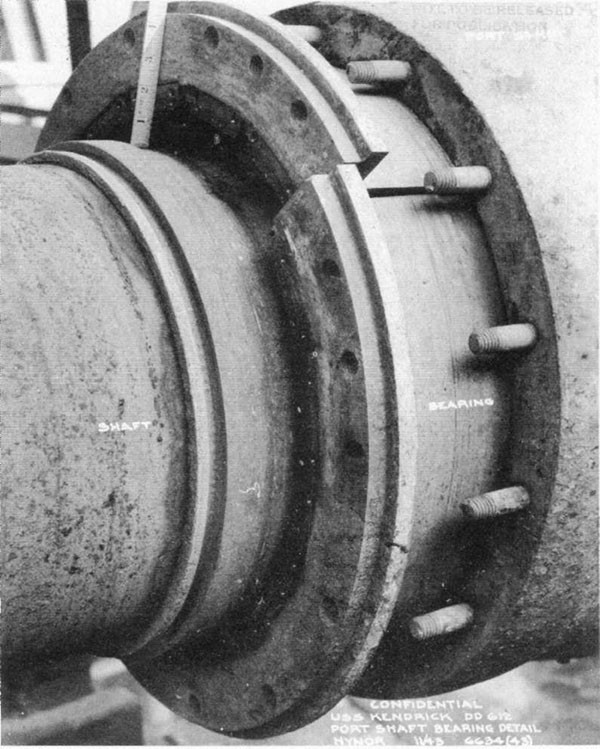
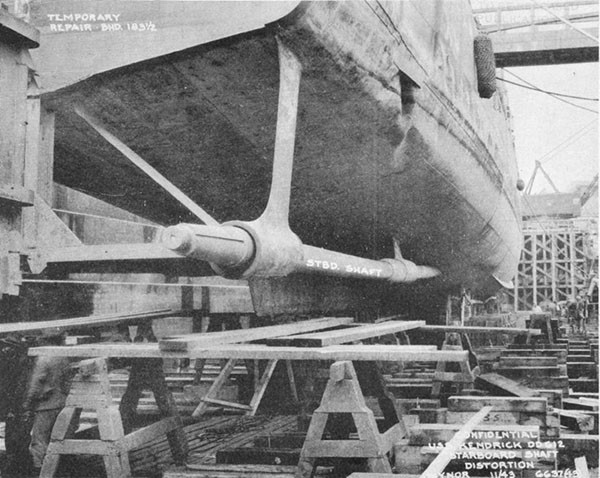
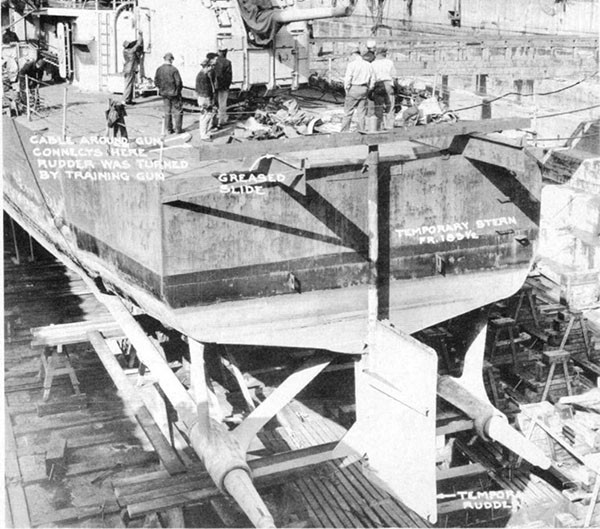
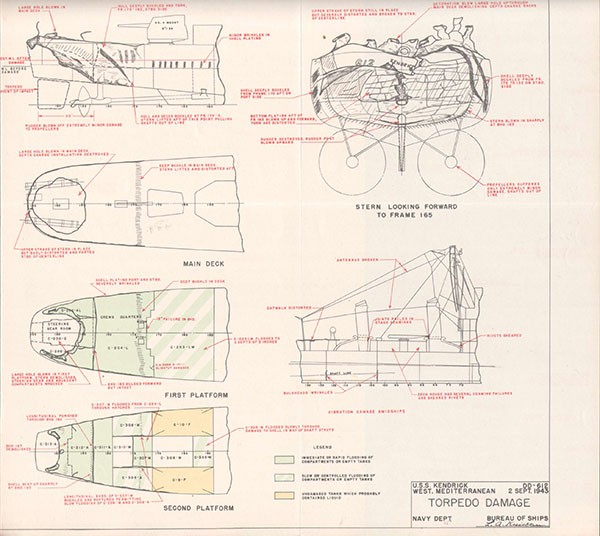
Loss in Action
Off Vella La Vella Island
6 October 1943
| Class | FLETCHER (DD445) | Length (O.A.) | 376 ft. 6 in. |
| Launched | 11 April 1942 | Beam (O.A.) | 39 ft. 4 in. |
| Displacement (Standard) | 2100 Tons | Draft (estimated, mean, prior to damage) | 13 ft. 1 in. |
References:
(a) C.O. CHEVALIER ltr. DD451/A16-3, Serial 0013 of 15 October 1943 (Loss Report).
(b) C.O. O'BANNON ltr. DD450/A16, Serial 009 of 15 October 1943 (O'BANNON's Action Report).
(c) C.O. LA VALLETTE ltr. DD448/A16-3, Serial 006 of 12 October 1943 (LA VALLETTE's Action Report).
PLATE VI
8-1. On the night of 6-7 October 1943, CHEVALIER was a unit of a destroyer task group composed of SELFRIDGE (DD357), CHEVALIER and O'BANNON (DD450). These vessels were assigned the mission of intercepting and destroying enemy forces composed of barges, torpedo boats and destroyers which were attempting to evacuate trapped Japanese ground troops from the northwest side of Vella La Vella Island. A bright half-moon was overhead and visibility was excellent, ranging from 13,000 to 20,000 yards. There were a few scattered squalls. The sea was calm and smooth, with a long swell running. The wind was westerly, force one. CHEVALIER was at General Quarters. The engineering plant was completely split, and material condition ABLE was set.
8-2. At 2231, CHEVALIER obtained a radar contact with two enemy groups composed of destroyers; the first was apparently an escort group and the second an evacuation group. At about 2239, the speed of the U. S. task group was increased to 30 knots. The order in column was SELFRIDGE, CHEVALIER and O'BANNON, and the distance between vessels was 500 yards. At 2243, CHEVALIER made radar contact with a third group; two small high-speed surface craft. These latter vessels approached to within 4,000 yards and then retired. Complete attention then was devoted to the first group, consisting of the main enemy force which at 2255 was 5700 yards on the port beam. A half salvo of torpedoes was launched from the after tubes at this time. About 1-1/2 minutes later the same enemy group was taken under fire by the 5-inch battery and gunfire was continued for 6 minutes. At 2259, CHEVALIER made another radar contact with two high-speed targets approaching on the starboard beam, and "right full rudder" was ordered. At 2301, while in the right turn, CHEVALIER was hit by a torpedo. The point of impact appears to have been just forward of the bridge at about frame 58, four to five feet below the waterline. Although the side on which the torpedo struck was not identified definitely by the Commanding Officer, the description of the damage as reported in reference (a) indicates that the torpedo detonated on the port side.
8-3. The detonation completely severed the bow in the general vicinity of frame 58. The forward fireroom started flooding rather rapidly. Although the bow never was sighted by the survivors of CHEVALIER, it was found and sunk by LA VALLETTE (DD448) about 4 hours later. A large column of water and oil was blown up by the torpedo detonation, completely drenching all of the remaining structure forward of about frame 106. However, no fires were reported. All communication between the bridge and enginerooms was lost.
8-4. As a result of the damage, the ship, which still had considerable way on, started to plunge by the bow. Therefore, about one minute after the detonation, messengers were despatched to the engineering spaces with orders to back all engines. About 1-1/2 minutes after the detonation, O'BANNON, which was astern of CHEVALIER, rammed CHEVALIER on the starboard side just abaft the after bulkhead of the after fireroom and quickly brought CHEVALIER to a stop. When CHEVALIER stopped, her bow came up a few feet. O'BANNON's bow penetrated approximately 10 to 12 feet into the after engineroom on the starboard side at about frame 134, and severely damaged CHEVALIER's starboard shaft. Immediate flooding of the after engineroom to the waterline prevented the operation of the port shaft. Thus, all propulsive power was lost. The after fireroom and forward engineroom started to flood slowly. All electrical power (including emergency) was lost, and CHEVALIER developed a slight list to starboard and began to settle slowly. O'BANNON backed clear and attempted to come alongside to port in order to receive wounded personnel.
--35--
Numerous attempts were made but all failed because CHEVALIER's damaged bow made the latter unmanageable. O'BANNON then stood off a short distance and received wounded and other survivors by boat. CHEVALIER was abandoned about 2 hours and 40 minutes after being torpedoed and rammed. She was sunk by LA VALLETTE about an hour after being abandoned.
8-5. As a result of the torpedo detonation, all structure forward of about frame 58 was missing. The reported damage is indicated on Plate VI. The main deck aft of frame 58 was buckled and ruptured in many places. On the superstructure deck the port 20mm mount was blown upward. The mount itself was found on top of the pilot house. The forward port side of the pilot house was damaged and the port wing of the bridge was torn and twisted. The port torpedo director was thrown inboard into the port flag bag. The starboard wing of the bridge was practically intact except for the wind shield. All equipment in the radar room, chart house and pilot house was damaged except the wheel and rudder angle indicator. It was reported by the Executive Officer that the beams of the overhead in the radar room and chart house were twisted. On top of the pilot house the FD radar antenna crashed into the director platform. Later, the pilot house sagged forward assuming a sharp angle.
8-6. On the main deck the port boat was missing and the davits were twisted sharply. The port bulwark was distorted and bent inboard. The port galley bulkhead was noted to have been holed by fragments. There also was a large hole in the forward port side of the forward smokepipe. No damage was reported to have occurred on the starboard side in this area. Fortunately, the starboard boat was intact.
8-7. An inspection of the starboard side of the main deck aft revealed that the following damage had occurred as a result of the collision with O'BANNON: both of the starboard 20mm guns were missing, the starboard splinter shield was crushed against the bulkhead of the midship deck house, the 5-inch loading machine was moved from its base about 6 inches and there was a large hole in the starboard side of the main deck in the vicinity of frame 134.
8-8. As a result of structural damage the I.C. and plotting room (A-207-C) flooded rapidly to the waterline with a mixture of fuel oil and water. Bulkhead 72 was buckled and split, permitting the forward fireroom to flood rather rapidly. As a result of the collision, the after engine-room of CHEVALIER was flooded to the level of the sea almost immediately. Reserve feed tank B-11W was ruptured and the starboard side of bulkhead 130-1/2 was split, permitting the after fireroom to flood slowly. The forward engineroom flooded slowly, probably through the after bulkhead when the starboard shaft was displaced by the bow of O'BANNON. CHEVALIER developed a slight list to starboard and began to settle deeper in the water. The extent of flooding at the time of abandoning is shown on Plate VI.
8-9. The emergency diesel generator in A-305-1E was not available (the forward bulkhead of this space was destroyed and the space was flooded). The rapid flooding of the forward fireroom caused the men on watch to abandon that space. The after engineroom had to be evacuated quickly when the bow of O'BANNON punctured the shell. The after fuel oil lines in the after engineroom were severed. With no fuel forward and the supply lines to the after tanks cut, it was impossible to keep fires under the boilers in the after fireroom, the flooding of which might have been controlled with the fire-and-bilge pump. The combined result of the torpedo detonation and the ramming was the complete loss of all propulsive and electrical power. Battle lanterns and flashlights provided the only means of illumination.
--36--
8-10. With all power lost, damage control efforts were extremely limited. An attempt was made to increase the freeboard by jettisoning topside weights. All heavy and easily removed weights on the starboard side were jettisoned including the 300-pound depth charges, ammunition for No. 3 mount (which was jammed in train when O'BANNON rammed CHEVALIER), and damaged bridge structure. The torpedoes in the forward tubes were jettisoned by firing them singly at 30-second intervals at two enemy destroyers maneuvering around a third badly damaged enemy destroyer. An effort was made to remove the water in the forward engineroom and after fireroom. The Commanding Officer reported, however, that the openings were too numerous and too large to reduce the inflow of water sufficiently to permit successful pumping with the two gasoline handy billy pumps on board. There was no power, of course, to operate the portable electric submersible pumps. In order to prevent depth charges from detonating if the stern should go under, orders were issued to remove all pistols, boosters and detonators. The registered publications, ECM, radar, and radio transmitters and receivers were destroyed to safeguard their security.
8-11. Since the situation appeared hopeless, CHEVALIER was abandoned about 2 hours and 40 minutes after being torpedoed and rammed. The freeboard on the port side amidships had been reduced to approximately 2 feet. On the starboard side amidships the freeboard was about 6 inches. The roll had become appreciably slower, and the vessel had a tendency to hang at the end of each roll. The main deck on the starboard side was dipping underwater frequently. All survivors were transferred to O'BANNON. O'BANNON then departed the area and reported to the Squadron Commander that CHEVALIER was still afloat. LA VALLETTE (DD448), also in the area, was ordered to sink the hulk. LA VALLETTE searched the area but found no survivors. An officer boarded CHEVALIER to make a final inspection for wounded survivors. This completed, LA VALLETTE stood off at 2100 yards and fired one torpedo with a depth setting of 5 feet. It struck aft and apparently caused a mass detonation of one of CHEVALIER's magazines as the Commanding Officer of LA VALLETTE reported that an unusually large explosion occurred. Flame and fire rose to a height of at least 500 feet, followed by a dense cloud of black smoke. CHEVALIER was destroyed completely. Upon leaving the area, LA VALLETTE located the bow section of CHEVALIER about one mile west of the location where she was sunk. LA VALLETTE dropped three 300-pound depth charges and two 600-pound depth charges, all with settings of 50 feet, close to the bow. When last seen at 0311, the bow was sinking slowly.
8-12. From the characteristics of the structural damage reported, it appears that the torpedo struck the port side. In view of the fact that enemy destroyers were on the port beam and in a favorable position to launch torpedoes, it is almost certain that the damaging agent was a Japanese destroyer torpedo. Prisoners of War from a Japanese destroyer sunk in this action have provided the names of the Japanese destroyers participating in this engagement. All were modern destroyers believed to use the "Type 93" torpedo, containing a warhead of 1086 pounds of "Type 97" explosive (equivalent to TNT). Although the loss of the bow could have been caused by a smaller warhead, the severe damage to the deck house, the forward 20mm mounts and the bridge indicates that a large warhead caused the damage. Thus, all evidence leads to the conclusion that the "Type 93" torpedo was the damaging agent.
--37--
8-13. The Commanding Officer reported in reference (a) that there were two distinct concussions. The first, of course, was the detonation of the torpedo. The second, which was reported to have been almost simultaneous with the first, gave the Commanding Officer the impression that it was an explosion of 5-inch magazine No. 2. There was no detailed description of the phenomena which presumably accompanied the second explosion. Magazine explosions involving comparatively large amounts of high explosives normally are accompanied by a high column (at least 300 or 400 feet in height) of orange-colored flame and fire in which incandescent particles are clearly visible. This in turn is followed by the heavy black cloud of smoke, characteristic of explosions involving high explosives. It will be recalled that SHAW (DD373)* suffered an explosion of forward magazines at Pearl Harbor on 7 December 1941. In this case, the bow sank immediately and the ship was completely wrecked back to the forward fireroom and No. 1 smokepipe. The explosion was accompanied by the phenomena described above. If, in CHEVALIER's case, the magazine explosion had occurred, the bow probably would have sunk immediately. Actually, the bow floated for about 4 hours before LA VALLETTE destroyed it. Again, none of the Commanding Officers of other ships present described events which would lead to a conclusion that CHEVALIER's forward magazines had exploded. It thus seems doubtful that a magazine explosion occurred. However, as described in paragraph 8-11, the usual characteristics of a magazine explosion were observed by other ships present when the hulk of the CHEVALIER was torpedoed by LA VALLETTE. The point of impact of this torpedo was not definitely located by any of the reports, but it must have struck aft in way of the 5-inch magazines - the only high explosives remaining on board in a location vulnerable to torpedo attack.
8-14. The loss of the bow of a destroyer when a torpedo detonates forward of the bridge is inevitable. This follows from the narrow beam and the light scantlings necessarily employed in destroyer construction. A torpedo with even a comparatively small charge will destroy most, if not all, of the structure in way of a point of impact.
8-15. In paragraph 8-10 it is noted that the only means of dewatering the ship after damage were two gasoline handy billy pumps. As discussed in the Summary, Section II, the emergency pumping facilities for destroyers have been considerably augmented during the past 18 months.
8-16. Although CHEVALIER lost her bow there is no reason to suppose that she would not have been able to leave the scene of action under her own power had she not been rammed by O'BANNON.
____________
*Buships War Damage Report No. 7.
--38--
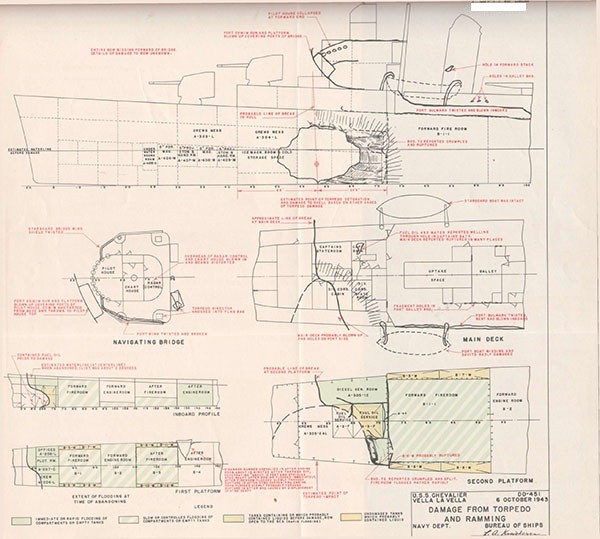
Torpedo Damage
Off Vella La Vella Island
6 October 1943
| Class
|
PORTER (DD356) | Length (O.A.) | 381 ft. 0 in. |
| Launched | 18 April 1936 | Beam (O.A.) | 36 ft. 2 in. |
| Displacement (Standard) | 1850 tons | Draft (prior to damage) | |
| Forward | 12 ft. 8 in. | ||
| Aft | 14ft. 1 in. |
References:
(a) C.O. SELFRIDGE ltr. DD357/A16-3, Serial 004 of 14 October 1943 (Action Report).
(b) C.O. SELFRIDGE ltr. DD357/A9/L11-1, Serial 006 of 17 October 1943 (War Damage Report).
(c) C.O. ARISTAEUS ltr. ARB-1/L11 of 25 November 1943 (Report of Temporary Repairs).
(d) Comdt. Navy Yard, Mare Island ltr. DD357/L11-1 (360-621903), Serial 12503 of 20 March 1944 (Supplementary War Damage Report).
(e) Comdt. Navy Yard, Mare Island ltr. DD357/L11-1 (360-605701), Serial 13866 of 5 June 1944 (Supplementary War Damage Report).
Photographs Nos. 49 through 56 (furnished by the Force Maintenance Officer, Service Squadron, South Pacific Force and the Navy Yard, Mare Island).
PLATE VII
9-1. On the night of 6-7 October 1943, SELFRIDGE was a unit of the same task group which included CHEVALIER (DD451), the torpedoing of which has been described previously (Section III-8). This group was assigned the mission of intercepting and destroying enemy forces which were attempting to evacuate trapped Japanese ground troops from Vella La Vella Island. The task group speed was 30 knots with SELFRIDGE as guide. SELFRIDGE was in material condition ABLE and the engineering plant was completely split. A bright half-moon was overhead, and visibility was excellent. The sea was calm and smooth, with a long swell running. The wind was westerly, force 1.
9-2. Radar contact was made with two enemy groups at 2231. At 2255, a half salvo of torpedoes was launched at the first group and 1-1/2 minutes later the same enemy group was taken under fire. At 2300, SELFRIDGE turned right to engage the second group of Japanese destroyers. At 2301, as described previously, CHEVALIER was struck by a torpedo and 1-1/2 minutes later was rammed by O'BANNON (DD450). Thus, SELFRIDGE alone remained to engage the enemy. At 2304, when SELFRIDGE was on course 320 degrees true, 1 torpedo was seen porpoising about 2,000 yards on the port beam on an approximately parallel course. This torpedo was thought by the Commanding Officer to have been fired from the first group of enemy destroyers. At 2305, two torpedoes were seen approaching from about 30 degrees on the port bow. The Commanding Officer ordered left full rudder but immediately countermanded this order because of a report of a torpedo close aboard on the starboard bow and ordered right full rudder. Speed was reduced to 25 knots. A few moments later the Commanding Officer saw a torpedo wake crossing the bow from starboard and pass down the port side about 25 yards away. Another torpedo wake was seen about 400 yards farther away at an angle showing that it was fired from a position on the starboard bow. The ship had swung around about 30 degrees by this time, and was heading about 010 degrees true. No other torpedoes being reported on the starboard side, left full rudder was ordered and an effort was made to locate the torpedoes previously approaching on the port bow.
9-3. SELFRIDGE had swung left to about 335 degrees true, when at 2306-1/2, a torpedo hit and detonated on the starboard side of the bow at about frame 40. The Commanding Officer reported that at about the same time another torpedo hit and detonated on the port side at about frame 30. Two almost simultaneous shocks were felt by personnel forward, while those stationed aft felt only one shock. The only flash noted by survivors was on the starboard side abreast 5-inch twin mount No. 2. Although the magazines for 5-inch mounts Nos. 1 and 2 were in way of or close to the torpedo hit(s), there were no indications of a magazine explosion. SELFRIDGE's bow was severed completely forward of the bridge (photo 49) at frame 40. After breaking clear the bow floated aft on the starboard side. All instruments and equipment on the bridge were inoperable except the TBS. The shock effect was not serious and resulted in practically no material damage. The circuit breakers on the ship's service switchboards tripped, cutting off the electrical power supply momentarily for the entire ship. Projectiles from 5-inch mount No. 2 showered the bridge. There was no flexural vibration noticed. Although the forward part of the ship was covered with oil, no fires resulted except for burning rags which were thrown overboard immediately. A momentary list of about 15 degrees to starboard was experienced, after which there was practically zero list. There was a rather large change in trim by the bow.
9-4. The engineering plant was intact. About 1-1/2 minutes after the detonation(s), the ship went full astern until sternway was gained and then the engines were stopped. The forward bulkhead of the forward fireroom was shored and other necessary damage control measures were carried out. The vessel proceeded at 10 knots to Purvis Bay for temporary
--39--
repairs. Engine control was maintained by telephone from the bridge. Steering was controlled by telephone communication between the bridge, the secondary conning station, and the steering gear room where the helmsman positioned the rudder by means of the trick wheel.
9-5. The structural damage to SELFRIDGE, resulting directly from the torpedo detonation(s), was extensive (photos 49, 50, 51 and Plate VII). One torpedo is estimated to have detonated at about frame 40 on the starboard side, somewhat above the level of the second platform. All structure forward of frame 40 was missing. Between frames 40 and 58 nearly all of the upper structure was damaged extensively and most of the lower portion was missing. The structure supporting 5-inch twin mount No. 2, which was directly aft and above the detonation, was blown bodily aft, pivoting about the forecastle deck. Peculiarly, this structure, consisting of a circular bulkhead surmounting a rectangular supporting structure, still largely retained its shape and form (photos 49, 50 and Plate VII). On the first platform, the rectangular supporting structure and adjoining deck and bulkheads were moved aft about 15 feet. The first platform at frame 55 was ruptured and rolled up by this movement of structure aft. The bulkheads and decks above the first platform were a shambles forward of frame 55. The decks in general sloped downward toward their connections with the structure under 5-inch mount No. 2. No structure remained above the first platform forward of the canted structure of mount No. 2.
9-6. The pictorial evidence indicates that the main deck and the shell on both sides down to the waterline were severed. Photo 51 shows one port shell plate folded outboard at the waterline. With the upper portion of the hull girder completely severed, presumably the bow then sagged and folded to starboard. Its movement was undoubtedly influenced by the fact that SELFRIDGE was swinging left at the time. As shown on Plate VII, the shell plating below the waterline on both sides was bent to starboard, (in the opposite direction to that above the waterline). The bottom and hold structure was also pulled to starboard. In tearing off as it swung to starboard, the bow peeled off a portion of the starboard shell plating at the waterline, back to bulkhead 59 (photos 50 and Plate VII).
9-7. When the bow forward of frame 40 broke off and floated aft, bumping along the starboard side, the ship was damaged in several locations. The bow wreckage dished in the starboard main deck bulwark at about frame 102, and dished in the "f" strake (1/4-inch medium steel) about 3 inches between frames 106 and 116 at the waterline. As the wreckage passed aft, it caught on the starboard tail shaft, strut, and propeller. The strut barrel was pushed up about 1/2-inch at the after end and the fair-water was torn off. The propeller shaft was bent slightly between the two struts. The tips of all three starboard propeller blades were bent over forward for an average depth radially of about 5 inches along the periphery of each blade. Despite this damage, the starboard propeller was useable during the subsequent trip to Purvis Bay.
9-8. There was no flexural vibration noticed. The keel and all structural members aft of frame 67 were in good condition. There was a slight indentation of the bottom at frame 75, on both sides of the keel.
9-9. As a result of the structural damage described above, all compartments and fuel oil tanks which still remained forward of bulkhead 67 were flooded or contaminated. There was some water on the signal bridge, about 4 inches deep. Considerable water entered the machinery spaces through the vent systems. There was slight seepage into the forward fireroom at the cable stuffing tubes and manhole plates of wiring trunks. The reported drafts prior to damage were 12 feet 8 inches forward and 14 feet 1 inch aft. As a result of the loss of the bow and flooding, the drafts after damage were about 16 feet 4 inches at frame 40 and 12 feet 2 inches aft. The vessel listed momentarily about 15 degrees to starboard, but righted herself immediately. This momentary list probably was caused by the bow swinging to starboard and tearing off.
--40--
9-10. The forward director was damaged and out of commission until about 1400 the next day, after which it was usable in manual control. The after 5-inch guns and after 1.1-inch mount remained operable in local control until power was regained at 2315 on 7 October. All five 20mm guns were undamaged. The SG radar was out of commission until about 0700 on 7 October, at which time this radar became the primary means of obtaining ranges for the after battery.
9-11. As a result of the detonation(s), the circuit breakers on the ship's service switchboards tripped, thus momentarily cutting off the electrical power supply for the entire ship. About 1-1/2 minutes after the detonations), the engines were backed full until sternway was gained, and then the engines were stopped. Except for the misalignment of the starboard shaft and the damage to the starboard propeller, caused by collision with the bow, the machinery plant was intact. While SELFRIDGE was lying to, the forward bulkhead of the forward fireroom was shored with 6 shores, one on each side near the shell about 8 feet above the keel and 4 between the bulkhead and No. 1 boiler. Flooding of the I.C. room caused all engine and steering control instruments on the bridge to be inoperative; power, however, was available at the steering gear.
9-12. In order to improve the stability, all of the remaining torpedoes and the depth charges were jettisoned. Later, while en route to Purvis Bay, other heavy topside weights such as torpedo directors, loading machines, etc., were shifted to the main deck aft in order to raise the forward end somewhat. For the same reason, pig lead ballast from the forward fireroom also was shifted to the main deck aft. This had the effect of reducing GM. However, when destroyers lose their bows with no flooding aft of the forward bulkhead of the forward fireroom the GM remaining is inevitably higher than that for the intact ship. The bow section forward of the bridge containing two high mounts is top heavy as evidenced by the immediate capsizing of many bows including that of SHAW*. In SHAW's case, it was necessary to install high ballast aft in order to reduce GM to the point where a reasonable period of roll could be obtained, necessary for habitability. In SELFRIDGE, in the absence of flooding, the relocation of lead ballast from the forward fireroom to the main deck aft was a desirable measure. However, it is pointed out that before undertaking the deliberate reduction of GM the situation must be carefully analyzed in order to make certain that injudicious reduction of GM does not create a critical stability condition. SELFRIDGE further exercised extreme care in the prevention of unnecessary free surface by keeping all after tanks either completely full or completely empty with the single exception of the tank in which suction was being taken.
9-13. The only fire reported was one due to burning rags. This was handled quickly by throwing the rags overboard. In order to avoid electrical fires, all circuits forward were pulled. The fire main, which was broken just forward of the galley, was secured forward of No. 1 fire-and-bilge pump (located in the forward fireroom), thereby putting the forward foam pressure proportioner out of commission. Two foam proportioners were rigged aft and a hose led directly from No. 1 fire-and-bilge pump. This was done to provide adequate firefighting facilities in the event of a fuel oil fire forward. On the morning of 7 October 1943, a blank flange was installed in the fire main in the galley in order to restore to use the forward pressure proportioner and the forward firemain risers.
____________
*Buships War Damage Report No. 7.
--41--
9-14. At 2358, 6 October 1943, after carrying out the initial damage control measures described above, SELFRIDGE got underway and proceeded to Purvis Bay. The engines were controlled by telephone. At first, speed was kept below 5 knots, but it was soon evident that such a low speed could be safely exceeded. Speed then was increased to about 10 knots although revolutions for 15 knots were being made. Some vibration of the starboard shaft and of the rudder post occurred, but did not appear serious. The gyro compass had been destroyed and the bridge magnetic compass was out of its gimbals, but the steering compass in the secondary conning station was undamaged although the compensating balls were loose. These balls were placed in their approximate positions in the dark. The deviation card normally attached to this compass had been lost. Steering control was achieved by the bridge giving compass courses and rudder angles to secondary conn over a sound-powered telephone. Secondary conn then controlled the rudder via telephone to the helmsman on the trick wheel in the steering engineroom. Steering a straight course was difficult; and when too much rudder was used, the ship would yaw violently. At 1352, 8 October, SELFRIDGE arrived in Purvis Bay and tied up alongside O'BANNON (photo 49).
9-15. At Purvis Bay, ARISTAEUS (ARB1) first removed all oil and ammunition, the most serious fire hazards. After this step, all wreckage and salvageable equipment above the first platform deck forward of frame 55 were cleared away. A temporary stub bow extending from the first platform to the forecastle deck was installed. On 23 November, SELFRIDGE got underway for Noumea, New Caledonia, arriving on 1 December. Here, she was placed in dry dock (ARD-2) for temporary repairs. Wreckage below the waterline was removed and the temporary stub bow then was carried down to the keel. On 29 December, SELFRIDGE got underway for Navy Yard, Mare Island, where she arrived on 24 January 1944 (see photo 54).
9-16. During her long availability for battle damage repairs, SELFRIDGE received alterations amounting practically to modernization. A double purpose 5-inch/38 caliber battery (2 twins, 1 single), including a Mark 37 director with the latest fire control radar, was installed and the necessary incidental rearrangements, including a modern open bridge, were provided. On 20 April 1944, SELFRIDGE returned to service. Photo 56 shows SELFRIDGE as she is now; in many respects a more efficient fighting unit than before the damage occurred.
9-17. The Commanding Officer reported in reference (b) that two torpedoes apparently struck the vessel; one on the starboard side at about frame 40 and the other on the port side at about frame 30. He based this conclusion on the fact that prior to the detonation on the starboard side the wake of a torpedo was observed approaching the ship broad on the port bow, on a collision course. In addition, personnel stationed forward felt two shocks, although men aft reported only one. There are indications of a port hit in that supplies in cold storage compartment A-308-2CE on the second platform, frames 47-51 port, were found in the starboard half of A-207-L, first platform, frames 50-59. Projectiles and powder cases from centerline compartment A-308M were found in A-309-3CE, frames 50-55 starboard. The appearance of the damaged structure when the ship was drydocked in Noumea was reported to further substantiate two hits. A second hit could well have occurred under the circumstances, although specific evidence is lacking.
9-18. Inasmuch as six torpedoes were sighted, coming from at least three different directions within a brief period preceding the detonations, it is impossible to determine the source of the torpedo(es). The references
--42--
have variously suggested that these torpedoes were launched by Japanese PT boats detected early in the action, or by the destroyers of the second group. CincPac has also suggested the possibility of aircraft torpedoes. The loss of the bow would well have been caused by a torpedo from any one of the three.
9-19. The magazines for 5-inch mounts Nos. 1 and 2 were in way of or in close proximity to the torpedo hit(s). Photo 55 shows samples of typical damage to 5-inch/38 caliber powder cases found in the wreckage of compartments A-406-M and A-308-M. Approximately 110 of these cases were found in these two compartments. The powder cases were stowed in containers prior to the torpedo detonation. There was no evidence to indicate that the percussion caps were struck or that the powder ignited. The powder cases probably were damaged by structural fragments from the hull. The inrush of water following the torpedo detonations) apparently prevented any powder fires. There were no indications of a magazine explosion.
9-20. With reference to the damage control measures which were employed, it is necessary only to emphasize their uniform excellence - indicative of thorough and intelligent training.
--43--
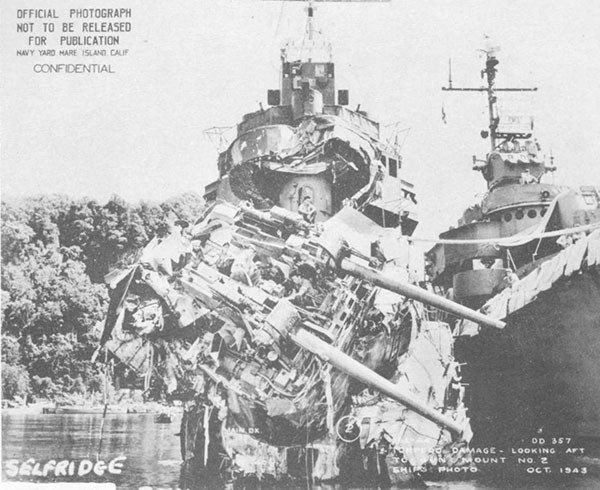
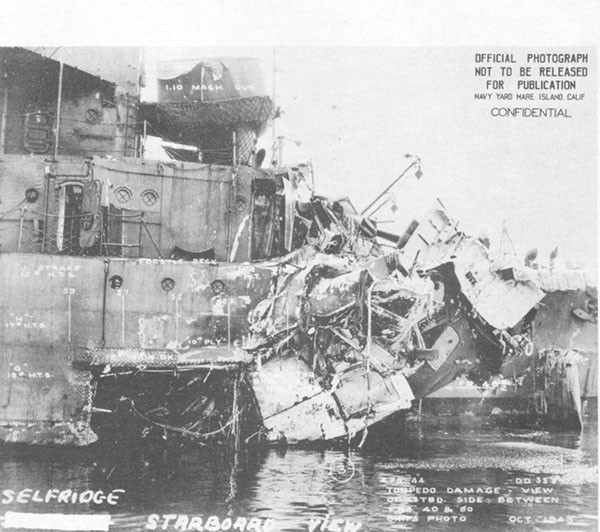
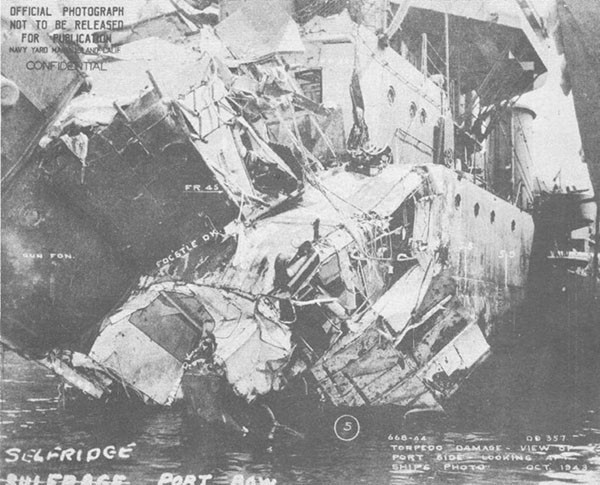
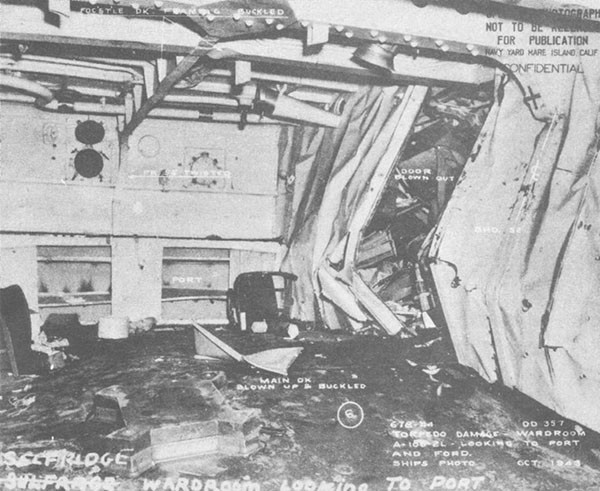
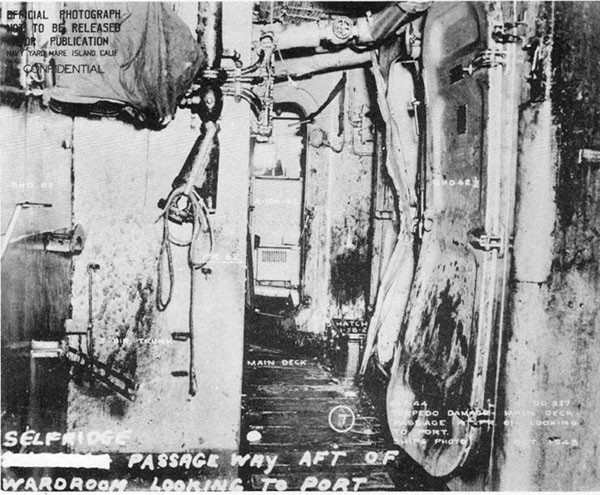
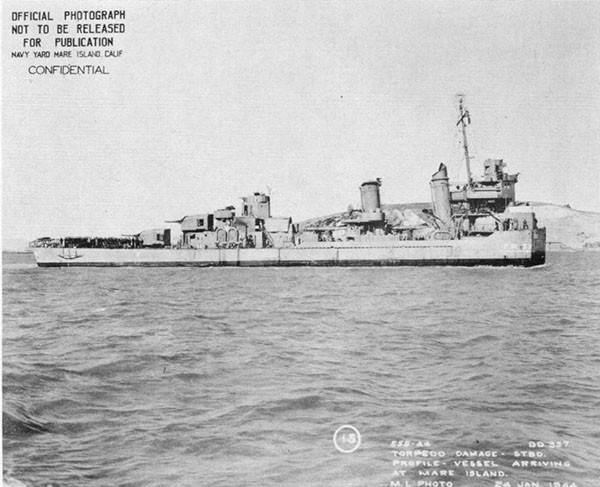
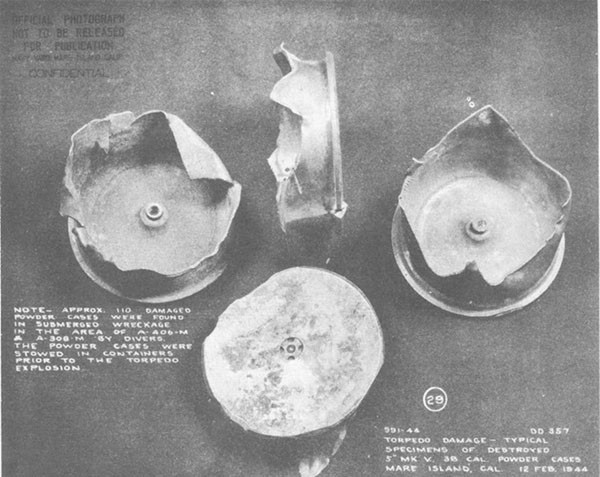
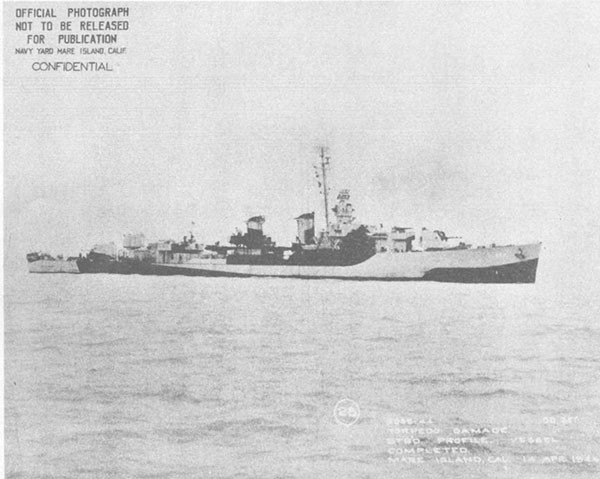
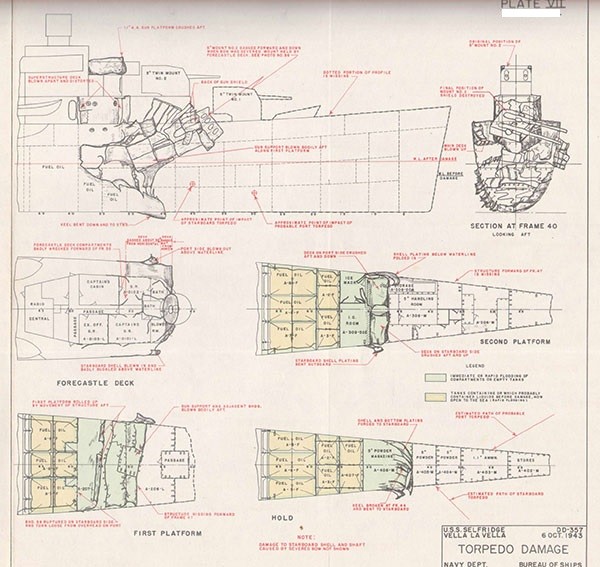
Loss in Action
Northwest African Waters
13 October 1943
Class
| BRISTOL (DD453) | Length (O.A.) | 348 ft. 4 in. | |
| Launched | 25 July 1940 | Beam (O.A.) | 36 ft. 0 in. |
| Displacement (Standard) | 1630 Tons | Draft (estimated, mean, prior to damage) | 13 ft. 3 in. |
Reference:
(a) C.O. BRISTOL ltr. A16-3/P6-1, Serial 00 of 26 October 1943 (Loss Report).
PLATE VIII
10-1. The data on which this report is based were obtained from the Commanding Officer's report, reference (a). That reference included statements by all the surviving officers, and is a more complete description than is usual in the rare cases of rapid loss. The details of the structural damage, understandably, were largely undetermined. The Bureau, accordingly, has supplemented the data contained in reference (a) with an estimate of the probable extent of structural damage. Plate VIII was prepared using a combination of the known facts and an estimate based on other war experience.
10-2. On the morning of 13 October 1943, BRISTOL was a unit of a destroyer squadron escorting a transport division in the western Mediterranean. BRISTOL was patrolling at 15 knots on the port side of the convoy. The moon was high, full and bright. Visibility was excellent. The sea was moderate with a slight swell running. Wind was five knots from the north. No vessels were in sight except the convoy nor were any enemy vessels sighted during the attack on BRISTOL.
10-3. BRISTOL was using the SG radar for station keeping and for making 360-degree searches. Sound searches were being conducted 70 degrees on each side of the ship's heading. At 0423, while steadying on course 230 degrees true, the hydrophone effect of a torpedo on the port bow was heard over the sound gear, but was not identified as such at the time. About 10 seconds later, a submarine torpedo struck BRISTOL and detonated on the port side at about frame 93 in way of the forward engine-room (plate VIII). All power, both propulsive and electrical, was lost. On the bridge the general alarm, general announcing system, sound-powered telephones, and TBS were inoperative. Emergency lighting came on for a few minutes in the forward section, but not in the after part of the ship. Although shock was severe throughout the ship it was the worst on the bridge and in forward living spaces where equipment and men were thrown to the deck. There were no fires. In a few minutes BRISTOL broke in two and sank. Loss of life was relatively small.
10-4. The detonation blew a large hole in the shell and effectively holed bulkheads 86-1/2 and 103. The forward three main machinery compartments undoubtedly flooded quickly as there were no survivors from these spaces. The boilers or steam lines in the forward fireroom were damaged as personnel on deck noted steam escaping from this compartment. Electrical workshop B-103-E, above the forward engineroom, was wrecked. However, two of the six men sleeping in the electrical workshop survived. Another indication of the rapidity with which the three forward machinery spaces flooded is the fact that the main deck was awash shortly after the detonation. There also was probably some off-center flooding, perhaps in tanks B-6W, B-8W, and B-10W, as a port list of about 10 degrees developed.
10-5. In the after engineroom no damage is known to have occurred except that the floor plates were thrown about by shock and No. 2 turbo-generator tripped out. All personnel in this compartment survived. In the after living spaces lockers and loose gear were thrown about by shock. No other damage aft was reported.
10-6. Bulkhead 67, the after boundary of the I.C. and plotting rooms, probably was undamaged. However, the instant the detonation occurred an officer was stepping through doorway 2-56-2 from crew's mess A-205-L into the plotting room. The shock threw him backwards through the open doorway to the deck in the crew's mess. He climbed up the ladder to the hatch in the main deck at frame 57, went aft through the galley
--44--
passage, and escaped by opening the starboard quick-acting watertight door in bulkhead 67. An enlisted man who escaped through the port quick-acting watertight door in bulkhead 67 reported that the starboard door was blocked by debris and an inrush of water when he reached it. There is no evidence that watertight doors 2-56-2, 1-67-1 or 1-67-2 were closed by personnel evacuating forward spaces. Failure to close these doors, would, of course, facilitate progressive flooding forward and increase the rapidity with which the vessel sank.
10-7. On the main deck the port motor whaleboat was broken in two with each part remaining fastened to its davit. The remains of this boat were carried under water as the vessel settled amidships. The starboard motor whaleboat was undamaged, but the davits forced it underwater as BRISTOL settled. There was insufficient time to release the starboard boat before it was swamped. The forward smokepipe was tilted forward apparently by the distortion of the main deck and midship deck house.
10-8. Immediately after the hit, BRISTOL began to sag in the vicinity of the forward smokepipe. A grating sound was heard by survivors which undoubtedly was created by the failure of various parts of the hull structure. This noise continued until the bow and stern each were about 10 degrees from the horizontal, and then ceased. However, the grating sound soon resumed and continued until the bow was about 20 degrees from the horizontal. At this time, the rupture of the hull was complete and the two sections separated. Although the exact time of complete separation was not reported, this apparently occurred about 4 or 5 minutes after the hit. The ship then was ordered abandoned. During the breaking up process, the port list varied. There was a slow rolling motion, but never a starboard list. The vessel seemed to twist to the right as it broke in two.
10-9. The after section increased its trim to about 35 degrees from the horizontal with the stern in the air and then sank bodily with a small port list about 8 minutes after the hit. In the meantime, the trim of the bow section continued to increase as the bridge structure submerged. The bow finally assumed a vertical position with the sound dome about 15 feet above the surface. The bow then rotated about 90 degrees to port and plunged. At 0435, 12 minutes after the torpedo hit, the bow of BRISTOL disappeared from view. There were no explosions other than the initial detonation.
10-10. It was the practice on BRISTOL to keep all depth charges set on "safe" until immediately before a depth charge attack. At the time of the hit, all charges were on "safe", and they were inspected prior to abandoning ship to insure that they were still on "safe". As a result, no detonations occurred in the water.
10-11. There was no trouble in releasing the life rafts except for those in the immediate vicinity of the damage. Eight of the 10 life rafts originally on board and 2 rubber life nets were used. TRIPPE (DD405) and WAINWRIGHT (DD419) rescued the survivors, who made good use of small plastic whistles in making their presence known. Of the 293 officers and men who were aboard BRISTOL at the time, 241 were saved.
10-12. Since the enemy craft firing the torpedo was never seen in spite of the excellent visibility, it is probable that the attacking vessel was a submerged submarine. Subsequent intelligence has indicated that the torpedo causing damage to BRISTOL probably was a German electrically-driven acoustic torpedo, known as "T-5". This type is fitted with a warhead containing 590 pounds of block-loaded German hexanite, equivalent to about 770 pounds of TNT.
--45--
10-13. Structural damage to BRISTOL was unusually severe. In most cases of contact torpedo hits in way of machinery spaces, two engineering spaces are badly damaged and opened to the sea whereas a third may flood slowly. In this instance, however, there were no survivors from either of the three forward machinery spaces, indicating that extensive damage and rapid flooding occurred in all three compartments.
10-14. The depth at which the torpedo struck the hull apparently was a major factor in the rapid structural failure and loss of BRISTOL. Although few details of the structural damage are known, it appears that the point of impact may have been at the bilge keel*. If so, all of the bottom structure, including the keel, undoubtedly was destroyed. The rapid flooding of three main machinery spaces caused severe sagging amidships. Thus, the lower intact strakes of shell plating were highly stressed in tension. Tension failure of remaining upper members of the hull girder quickly followed. The main deck in the meantime was placed in compression and developed deep buckles which permitted the vessel to begin to "jack-knife". As tension failure progressed, the angle of the bow and stern became larger until the bow reached an angle of about 20 degrees, at which time failure was complete and the two sections separated.
____________
*The pistol mechanism in the "T-5" torpedo will be initiated magnetically in case of a deep miss.
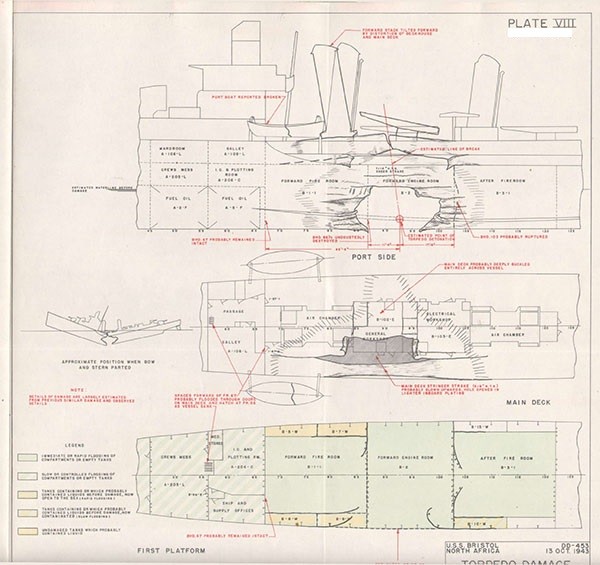
Torpedo Damage
Empress Augusta Bay, Bougainville Island
2 November 1943
| Class
|
FLETCHER (DD445) | Length (O.A.) | 376 ft. 6 in. |
| Launched | 11 October 1942 | Beam (O.A.) | 39 ft. 4 in. |
| Displacement, (Standard) | 2100 Tons | Draft (estimated, mean prior to damage) | 13 ft. 1 in. |
References:
(a) C.O. FOOTE ltr. DD511/A16, Serial 259 of 7 November 1943 (Action Report).
(b) C.O. FOOTE ltr. DD511/A16/L11-1, Serial 293 of 1 December 1943 (War Damage Report).
(c) C.O. FOOTE ltr. DD511/A16/L11-1, Serial 306 of 7 December 1943 (War Damage Report).
(d) C.O. WHITNEY ltr. AD4/L11, Serial 073 of 23 November 1943 (Report of Temporary Repairs).
(e) C.O. DIXIE ltr. AD14/A9/L11-1, Serial 55 of 6 January 1944 (Report of Temporary Repairs).
(f) C.O. FOOTE ltr. DD511/S25/(00-8) dated 25 February 1944 (Report of Towing Operations).
(g) C.O. Naval Drydocks, Terminal Island ltr. NY13/DD511/ L11-1 (D-2), Serial C-280 of 16 June 1944 (Supplementary War Damage Report).
(h) C.O. Naval Drydocks, Terminal Island ltr. NY13/DD511/L11-1(D-2), Serial C-294 of 28 June 1944 (Supplementary War Damage Report).
Photographs Nos. 57 through 61 (furnished by the Commanding Officers WHITNEY (AD4) and DIXIE (AD14) and the U.S. Naval Drydocks, Terminal Island).
PLATE IX (Prepared from sketches provided by the Commanding Officer).
11-1. FOOTE was a unit of a task force composed of four cruisers and eight destroyers which were supporting amphibious operations in Empress Augusta Bay, Bougainville Island. On the night of 1-2 November 1943, this force was directed to intercept and destroy a Japanese task force, composed of cruisers and destroyers, threatening the landing operations. FOOTE was at General Quarters with material condition ABLE set. At 0100, speed was 20. knots. The night was clear and dark with no moon. The sea was calm with a slight swell running from the southeast. Wind was force 1 from east southeast.
11-2. At 0230, radar contact was made with the enemy force. At 0249, FOOTE's speed was increased to 34 knots. At 0256, the enemy was taken under fire by cruisers of the U. S. force. At 0301, while FOOTE was steadying on course 270 degrees true, a shallow-running Japanese torpedo was sighted on an approximately parallel course abreast the starboard bow at a distance variously reported as 25 to 200 feet. Before any evasive action could be taken, the torpedo struck and probably detonated on the rudder skeg at about frame 203 (photo 57). A column of water about 75 feet high was thrown up on the port side, and solid water and heavy spray drenched the after portion of the ship. No flash or flame was observed by any surviving personnel. The shock did not cause appreciable damage. Flexural vibration occurred and resulted in minor damage. The foremast whipped about 10 feet in a fore and aft direction. All radio and radar equipment suffered derangement and was inoperable for about 10 minutes. Some depth charges that had been lost with the stern were heard to detonate very deep in the water. The torpedo detonation caused the loss of all propulsive power and steering, and the ship quickly came to a stop. A fire appeared to start in the damaged structure at the stern, but was extinguished by a wave before the firefighting party arrived. There was a port list of about 5 degrees and a large increase in trim by the stern. Friendly vessels laid a complete screen of oil and chemical smoke around FOOTE. No further damage was sustained. At 0638, FOOTE was taken in tow for Purvis Bay for temporary repairs.
11-3. The detonation destroyed all of the structure aft of frame 196 (photo 57 and Plate IX). The main deck was torn away and missing aft of frame 189 at the center and aft of frame 199 on the port and starboard sides. The remainder of the main deck aft of frame 182 was deflected upward. Hatch 1-167 was sprung and two dogs were torn loose. The main deck was wrinkled deeply and cracked in six places between frame 170 starboard and frame 166 port. The shell plating at these frames also was wrinkled deeply down to the turn of the bilge (plate IX). There also were two deep wrinkles down the port and starboard sides at frame 163 (photo 58). Quick-acting doors 1-170-1 and 1-170-2 were partially sprung open when the door frames wrinkled. The top of the deck house was wrinkled at frame 169.
11-4. Below the main deck, compartments aft of bulkhead 196 were missing. Bulkhead 196 was missing except for a small portion on the port side below the first platform. The port side of the first platform in C-205-L was blown upward while the starboard side was buckled. The first platform was wrinkled at frame 180 on the port and starboard side of No. 5 handling room. Bunks, stanchions and lockers in compartment C-204-LM were damaged. The deck in compartment C-203-L was buckled across the ship at frame 167. This deck was cracked and broken at nine different places, permitting leakage from fuel oil tanks C-8F and C-9F.
--47--
Bulkhead 182 had some small wrinkles and some leaky seams but was substantially intact (photo 59). Bulkheads forward of frame 176 were intact. All hatches in C-205-L were blown open or sprung. The quick-acting doors on the starboard side of bulkheads 182, 170 and 157 were sprung, permitting some leakage into forward spaces. The corresponding watertight doors on the port side, which were not of the quick-acting type, were watertight. Powder tank scuttle 2-173 could not be closed because it was buried under scattered ammunition and bunks. Hatch 2-161, through which the handling room crew escaped, could not be closed. A subsequent examination revealed that two bunk chains were hanging over the lip of the hatch. Compartment C-201-L was undamaged structurally. A small amount of fuel oil and water, however, leaked up into this compartment through the manhole to starboard fuel oil tank C-7F. Compartment C-202-E was intact and dry except for about 6 inches of diesel oil from tank C-6F. This oil leaked through the manhole in the after end of the compartment.
11-5. The second platform aft of bulkhead 182 was deflected upward. On the starboard side, the bottom was dished deeply aft of frame 180 (plate IX). Bulkhead 192 was buckled and watertight door 3-192 which was dogged tightly prior to the detonation was blown open. The severe upward deflection of the bottom crushed the ordnance stores in C-307-A, the 20mm ammunition in C-310-M, the engineering stores in C-308A, the 40mm ammunition in C-306M, and the bulk stores in C-309A. In the 40mm magazine, the ammunition cases were bent and jammed together. These spaces were open to the sea. Between frames 172 and 188 the stern tubes were pulled away from the hull, opening fuel oil tanks C-10F and C-11F to the sea (photo 60). Fuel oil tanks C-9F, C-8F, C-7F and C-4F were open to the sea as a result of cracks in the hull caused by the deep wrinkles. The shell in way of stuffing box compartments C-2-EA and C-5E also was opened and these spaces flooded. Although not reported, the shell in way of diesel oil tank C-6F probably was split. Diesel fuel oil tank C-501-F and void C-502-V also were opened to the sea, through shell fractures. Five-inch powder magazine C-305-M flooded from void C-502V (immediately below) and through the scuttle which was left open in door 3-176. C-304-M, the 5-inch handling room, also flooded from void C-502-V through a rupture in the deck near the ammunition hoist. C-303-M flooded through door 3-170 which could not be closed by evacuating personnel due to floating powder cases catching in the doorway. Similarly, compartment C-301-M flooded through door 3-163. The deck was buckled slightly in C-301-M and oil entered through the deck from diesel oil tank C-501-F (underneath). There was a small amount of leakage from C-8F into 40mm magazine C-302-M.
11-6. Immediately after the detonation, the main engines stopped. When an attempt was made to turn over the engines, the port turbines would not rotate. The starboard shaft turned about 60 degrees, creating a loud pounding and tearing noise in the after end of the ship. When the throttle was closed, the shaft reversed and returned to its previous position. Subsequent investigation revealed that the starboard propeller blades were missing, although the hub remained on the shaft. The starboard shaft, with the strut bearings bent and jammed, was bent in at least two places and hung downward from the hull at an angle of about 20 degrees. The port propeller was intact; the port shaft, however, was bent downward also about 20 degrees. Flexing of the starboard shaft caused some concern. "C" clamps were used to hold the starboard shaft bearings close to their foundations since there was a chance that if the shaft were allowed to flex it might rupture the after bulkhead of the after engineroom. Some damage to the main machinery units resulted because of the sudden stoppage of
--48--
the shafts. Damage was incurred primarily by the two reduction gear units, which are of the locked-train double reduction type, and the port low pressure turbine. The damage to the reduction gears consisted principally of slight eccentricities and shearing or partial shearing of several keys. In addition, the port low pressure turbine was allowed to run free due to the shearing of the key between the after end of the low pressure lower first reduction gear and the second reduction quill shaft. As a result, the turbine bearings wiped, allowing the rotor to settle. Various packing rings were damaged beyond repair and the rotor surfaces were scored deeply. Machinery damage is discussed further in the Summary, Section II.
11-7. Shock was appreciable, but resulted in only minor damage. Flexural vibration likewise caused some minor damage. There was a buckle across the main deck at frame 29 which extended down the port side to the first platform and across the first platform to the centerline. The 5-inch gun director, Mark 37 Model 2, was lifted from its roller path but no damage was done to the holding down clips. When the director came to rest, the roller path was dented at the 240-degree point. This caused the 5-inch battery to be off in elevation on this bearing. No other derangement of ship or fire control was noted.
11-8. The only fire reported was one which appeared to start in the damaged structure at the stern, but was extinguished by a wave before the firefighting party arrived. Torn ends of cable attached to the main deck and sides at frame 95 were seen arcing until switches on the after board were opened. All the circuits aft were disconnected except those to the portable electric submersible pump outlets.
11-9. Some of the depth charges that were blown overboard were felt detonating very deep in the water. All of the 600-pound depth charges except one were missing. This depth charge was found later buried in the wreckage at frame 194 on the port side. The safety wire and depth safety fork were still in place and the depth setting was on "safe". Three of the 300-pound depth charges on the after throwers and roller loaders had broken safety wires and the depth settings had changed to about 35 feet. The three after 20mm mounts, two depth charge racks and two smoke screen generators were lost with the after section of the main deck. 5-inch mount No. 5 was intact, although jammed in train. This was caused by a slight buckling of the base ring and a sharp bend in the training pinion shaft.
11-10. After the torpedo detonation, the turbo-generators continued to supply the ship's service distribution boards. However, in case the after turbo-generator should be made inoperative if the after engineroom were to flood, the emergency diesel generator was started manually. The circuit from the after distribution switchboard which had been energizing the emergency diesel generator switchboard was cut out while cutting in power to the emergency diesel generator switchboard from the emergency diesel generator. At that time, the radar and radio circuits were taking power from the emergency diesel generator (the power switch was on "emergency"), and the momentary loss of current during the switching operation caused all power relays in the radio and radar circuits to trip out. It took about 5 minutes to get the radio and radar equipment back in operation, and the SG radar receiver, required considerable re-tuning before normal ranges could be obtained. Whether the emergency diesel generator starts automatically or is controlled manually, a momentary loss of power will trip the present type of power relays in connected radar and radio circuits. Energizing these circuits through the
--49--
emergency diesel generator switchboard during normal operation is apt to delay energizing more important circuits in an emergency because of the limited load which the emergency diesel generator can handle.
11-11. As a result of the loss of the stern and the flooding described previously, FOOTE began to settle aft. Within 2 minutes after the damage occurred, the port side of the main deck, from the wrinkles at frame 172 to the wrinkles at frame 183, was level with the water. The draft forward was about 6 feet. The ship listed about 5 degrees to port. In order to increase the freeboard aft, all 300-pound depth charges were jettisoned after the pistols and boosters had been removed. Depth charge arbors and empty acetylene and oxygen cylinders also were thrown overboard. Full cylinders were moved to the forecastle. These measures reduced the list to about 3 degrees and increased the freeboard aft about 3 inches. Since the stability appeared adequate, the torpedoes were retained on board for use in case the enemy should approach within range. The after main circulating pump was placed on bilge suction in order to remove the water entering the after engineroom bilges through the leaky shaft stuffing boxes. Additional water was removed later by the steam-driven fire-and-bilge pump. All portable electric submersible pumps aboard were used to dewater compartment C-203-L. All gasoline-driven handy billy pumps were brought aft and used to dewater compartments C-201-L and C-202-E. By 0325, C-201-L and C-202-E were dry and the handy billy pumps were shifted to compartment C-203-L, where the submersible pumps had been unable to lower the water level. Difficulty was experienced in pumping C-203-L because bedding and personal gear clogged the suctions of the submersible pumps. A screened intake was devised from the expanded metal holder of the after floater net. This improvised strainer was effective and C-203-L was partially dewatered. Freeboard aft was increased about 3 inches by these efforts. All three of the portable submersible pumps on board eventually failed - the result of more than 30 hours of attempting to remove the heavy mixture of oil and water. Section II contains a discussion of the use of portable electric pumps with mixtures of fuel oil and water.
11-12. At 0400, while FOOTE was still dead in the water, an unidentified aircraft commenced a low altitude approach on the port side. Fire was opened by all 5-inch mounts except No. 5. The plane immediately withdrew. 5-inch mount No. 4 ceased firing after four rounds were expended because of the heavy vibration in the damaged area. At this time heavy tools and bars of stock were removed from the general workshop and placed on the starboard side of the forecastle. All depth charge loaders were burned off and jettisoned, and the torpedo handling crane at frame 149, and the 5-inch loading machine less rammer and motor also were jettisoned. These measures removed all of the remaining list.
11-13. At 0638, THATCHER (DD514) commenced towing FOOTE at 4 knots. At 0800, FOOTE again was attacked by enemy aircraft. The forward two 5-inch mounts were used to repel this attack. No damage was sustained. After this attack, the tow was shifted to SIOUX (AT75). Course was set for Purvis Bay through Blanche Channel. There were no provisions for steering FOOTE, as the steering gear and rudder had been lost, but SIOUX was able to tow at 9 knots despite some yawing. While in Blanche Channel, about 75 square feet of the upturned main deck was removed. Numerous bunks, stanchions and other easily removed material in compartment C-205-L were thrown overboard. This action increased the freeboard aft about 2 inches. At 1500, 4 November, FOOTE arrived in Purvis Bay and secured alongside WHITNEY (AD4). Emergency temporary repairs were made in order to make the vessel seaworthy and
--50--
safe for passage under tow to Espiritu Santo. All flooded compartments forward of bulkhead 182, with the exception of C-304-M, the fuel oil tanks and the stuffing box compartments, were pumped dry. All possible weight was removed from the after portion of the vessel. This included 5-inch mount No. 5, the barrel of 5-inch mount No. 4, all five-inch/38 caliber and 40mm ammunition, both shafts (cut off just aft of the stern tubes), the port propeller, all damaged portions of the hull aft of frame 182, and all damaged equipment and material in the damaged compartments. Bulkheads 182, 170 and 157 were made watertight and shored. Door 2-170-2 was blanked off. Bulkheads of compartments C-301-M, C-302-M, C-303-M and C-305-M were shored. Weakened structure was reinforced by installing strength members. All water-soaked motors were washed out thoroughly and baked until resistance readings were normal. The section of the starboard shaft in the after engineroom was secured by a wire strap to prevent movement. On 23 November FOOTE was towed by BOBOLINK (AT131) to Espiritu Santo, arriving on 27 November. Difficulty was experienced in towing inasmuch as FOOTE yawed 60 degrees on each side of her course. Later, an APc was towed astern and acted as a sea anchor, but the yawing was not reduced appreciably.
11-14. At Espiritu Santo, FOOTE was placed in a floating dry dock. All of the damaged structure aft of frame 182-1/2 was cut away. An additional bulkhead was installed just aft of bulkhead 182 (photo 61). The bulkheads at frames 182, 170 and 157 were made watertight. The stern tubes and shafts aft of frame 161 were removed and patches were placed over the hull. All of the openings in the hull were patched and reinforced adequately by installing I-beams. Two fixed "rudders" were installed to port and starboard (photo 61). On 21 January 1944, FOOTE left Espiritu Santo under tow of a commercial tanker. No difficulties were encountered and FOOTE arrived at Terminal Island on 4 March. The fixed "rudders" installed at Espiritu Santo were effective in preventing excessive yawing. At Terminal Island, permanent repairs together with authorized alterations were made. FOOTE returned to service on 30 June 1944.
11-15. The torpedo which caused the damage to FOOTE was fired by a Japanese destroyer or cruiser. Intelligence data indicate that nearly all the destroyers and cruisers present were of recent classes, probably equipped with the "Type 93" torpedo, with a warhead containing 1086 pounds of "Type 97" explosive, approximately equivalent in effectiveness to an equal weight of TNT. Although this is a large charge, damage was not appreciably greater than that which has been caused by smaller charges striking in the same vicinity on other destroyers. Damage to the extremities of destroyers does not vary directly with size of charge and large charges will rarely cause a significant increase in damage beyond that caused by a moderate charge - say 600-700 pounds of TNT.
11-16. The cover of hatch 2-161 could not be closed because of two bunk chains which were hanging over the lip of the hatch. The latest specifications for bunks require steel straps for support, rather than chains. A man in magazine C-304-M was killed by projectiles which fell out of bins because horizontal battens were jarred out of place. Detailed instructions, including sketches to prevent this type of casualty have been issued by the Bureau to all ships and stations showing approved methods for securing vertical and horizontal battens of projectile bins. A number of quick-acting watertight doors were sprung and leaked. A research program is now underway with the purpose of developing watertight doors, both the quick-acting and dogged types, which will more effectively resist blast than present types.
11-17. Damage control measures on FOOTE were undertaken quickly and were effective. FOOTE's survival was never in doubt.
--51--
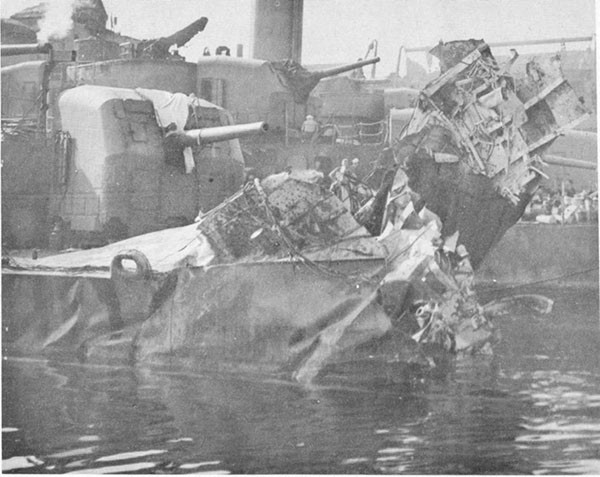
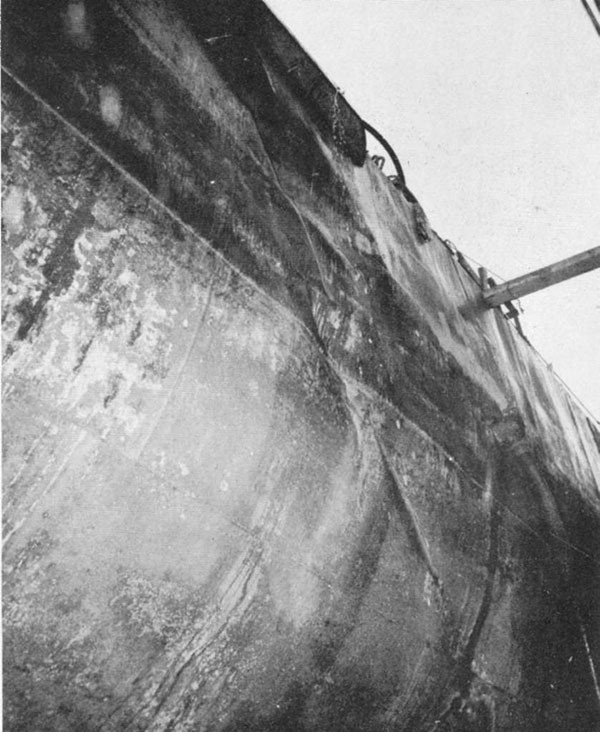
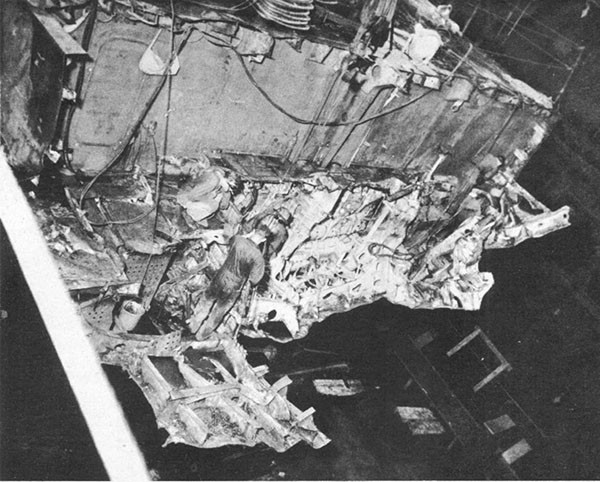
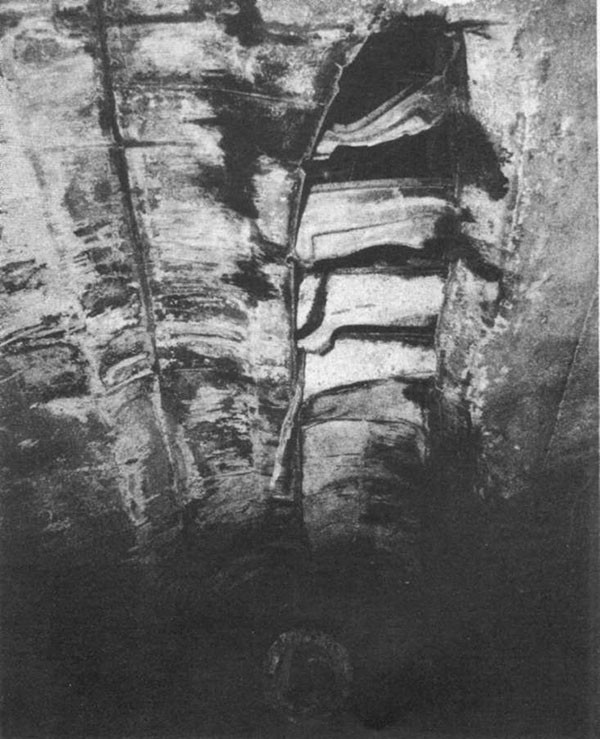
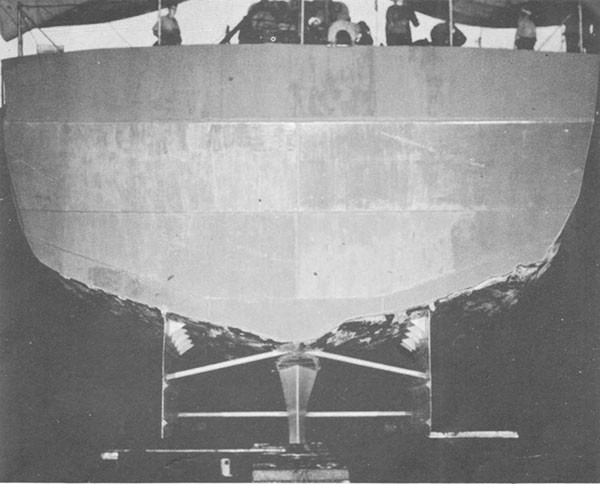
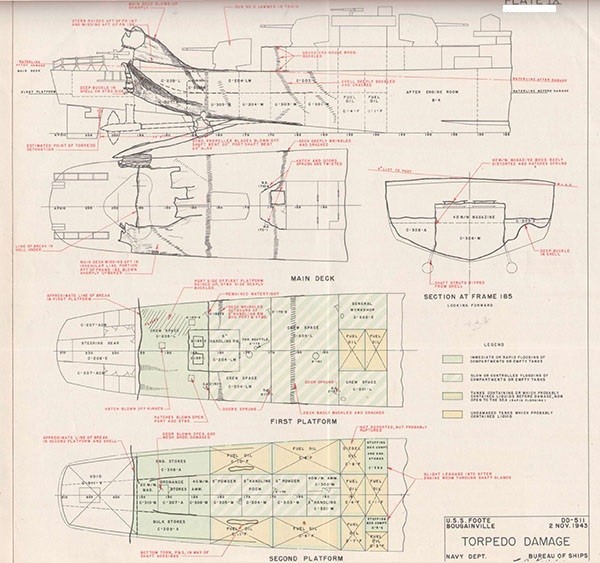
Loss in Action
Northwest African Waters
6 November 1943
| Class | BRISTOL (DD453) | Length (O.A.) | 348 ft. 0 in. |
| Launched | 20 December 1941 | Beam (O.A.) | 36 ft. 0 in. |
| Displacement (Standard) | 1630 TONS | Draft (estimated, mean, prior to damage | 13 ft. 3 in. |
References:
(a) C.O. BEATTY ltr. A9 of 12 November 1943
(b) C.O. BEATTY ltr. A9 of 22 November 1943
(War Damage Report).
PLATE X (Prepared from sketches provided by the Commanding Officer, USS BEATTY).
12-1. On the evening of 6 November 1943, BEATTY was a unit of a task group which was escorting a convoy in the western Mediterranean. BEATTY was steaming at 13-1/2 knots on the starboard quarter of the convoy. The machinery plant was operating in a completely split condition, except for the two main generators which were paralleled. No. 3 boiler was taking fuel oil suction from C-7F and supplying steam to the after plant, while No. 2 boiler was taking suction from A-2F and furnishing steam for the forward plant. Nos. 1 and 2 turbo-generators and the main distribution switchboards were in parallel. The ship was at General Quarters. Material condition ABLE was set. The sea was calm with occasional ground swells. The wind was about 5 knots. The night was clear with a bright moon.
12-2. At 1803, the convoy was attacked by German aircraft. About 1813, 4 of the enemy planes approached from the starboard side. These planes launched at least two torpedoes in spite of heavy anti-aircraft fire from the U. S. task group. One of the torpedoes passed close astern of BEATTY and the other struck and detonated on the starboard side in way of the after engineroom at about frame 124 (Plate X). No flash or smoke was observed and very little water was thrown up by the torpedo detonation. No fires were reported. As a result of damage to the starboard shaft and the immediate flooding of the after engineroom, all propulsive power was lost. Battle lanterns provided the only means of illumination.
12-3. A small list to port was assumed, away from the side of impact. There was a considerable loss of freeboard. Almost immediately the port side of the main deck amidships was noted to be awash. The port list increased and the hull girder started to fail. Damage control measures were ineffective. About 4 hours and 20 minutes after the detonation, BEATTY was abandoned. She broke in two and sank about 30 minutes later.
12-4. As a result of the detonation, the after engineroom flooded to the waterline immediately. There were no survivors from this space. The forward bulkhead (122-1/2) of the after engineroom, which was about 2 feet from the estimated point of detonation, was destroyed on the starboard side. In the after fireroom, No. 4 boiler was pushed about 2 feet forward and probably a short distance to port. All lights and power failed immediately. No. 3 boiler had been taking fuel oil suction from C-7F and supplying steam to the after engineroom. One, or more, of the steam lines undoubtedly were broken inasmuch as this compartment filled with steam. It was impossible to see anything, even with battle lanterns. In spite of the presence of steam and the rapid flooding, there were 6 survivors from the after fireroom, including one man who had been standing on the floor plates. There were 3 men lost in this space.
12-5. The torpedo, which apparently detonated slightly below the level of the starboard shaft, displaced the shaft inboard and upward. This resulted in damage to the after bulkhead of the forward engineroom sufficient to cause this space to flood rapidly. The shaft gland stuffing box was torn from the bulkhead, shearing all bolts holding it in place, and was pushed forward into the forward engineroom about 8 to 10 inches along the shaft. The inboard and upward movement of the shaft caused three splits in this bulkhead. One of these cracks extended upward about 18 inches, one inboard about 18 inches and one downward. There was a clear space of approximately 8 inches around the shaft. No other damage was reported to this bulkhead, which was about 37 feet forward of the point of impact. The forward fireroom incurred no structural damage or flooding.
--52--
12-6. Aft of the after engineroom, 40mm magazine C-301-M undoubtedly was flooded. Handling room C-302-M was observed to be flooding slowly through the lower edge of the forward bulkhead, apparently from C-301-M. On the first platform in compartment C-201-L, several lockers were thrown adrift apparently from shock. This compartment flooded slowly with a mixture of oil and water. Oil is known to have entered the compartment from fuel tanks below through a vent on the port side. The forward bulkhead (139) of C-201-L was about 25 feet from the point of detonation. Although the condition of this bulkhead was not reported, it presumably was damaged by fragments or blast. Powder magazine C-303M was examined only superficially, but appeared undamaged. 40mm magazine C-304-M was not inspected. Within a short time, the mixture of oil and water in C-201-L was 30 inches deep at the centerline. Portable gasoline handy billy pumps were employed, but difficulty was experienced in pumping the mixture of oil and water. In addition, the suctions were fouled continually by bedding and personal gear. A bucket brigade was formed and succeeded temporarily in keeping even with the water.
12-7. On the main deck, the area between frames 113 and 139 on the starboard side was a shambles. The main deck starboard stringer strake (3/5-inch HTS) was torn loose from the sheer strake between frames 117 and 132 and bulged upward a maximum of 3 feet. The next inboard strake adjacent to the stringer also was blown upward with a large hole noted between frames 121 and 128. It was noted in reference (b) that failure along the inboard seam of the stringer strake did not occur in the line of rivets but rather 3 inches inboard of the line of rivets. Survivors also observed two radial cracks which extended outboard from the corners of the hatch at frame 111, starboard. The starboard bulwark was blown outboard from frame 119 aft with the end projecting about 10 feet over the side. The starboard depth charge projector at frame 125, 4 depth charges and half of the rack were blown overboard. The life raft at frame 115 and the floater net on the after end of the midship deck house also were lost overboard.
12-8. As soon as the extent of damage was determined and in order to improve stability and increase the freeboard, the following large items were jettisoned: 3 torpedoes, all depth charges, all 5-inch and 40mm ready service ammunition, all port 20mm guns and ammunition, search light, smoke generator, both boats, all life rafts and nets, all fenders, the forward port davit, towing cables (by mistake), all powder and projectiles from No. 4 magazine, all 40mm ammunition from clipping rooms, all 40mm barrels, the port 24-inch searchlight, and in addition, about two tons of small gear from various ship's shops.
12-9. Immediately after the detonation, all electrical power was lost and portable battle lanterns were employed for illumination. In the forward engineroom, the shaft revolution indicator dropped to "zero" in spite of the fact that the throttle had not been closed. The admission of more steam failed to turn the shaft, and the throttle then was closed. No. 1 turbo-generator in the forward engineroom and No. 2 in the after engineroom and the ship's service distribution switchboards had been operating in parallel prior to the detonation. The reason for this set up of the electrical plant was not reported, although parallel operations of generators when the rest of the plant is split is inconsistent. Several attempts were made to put No. 1 generator on the line, after bus tie circuits to the after main board had been pulled, but each time the generator circuit breakers tripped, indicating other electrical damage. Reference (a) reported that this apparently was due to damage at the rear of
--53--
the board, a reasonable probability. Since 1630-ton destroyers have no emergency diesel generators, there was no emergency power available. An attempt was made to control the flooding in the forward engineroom by the use of the main circulator. This was not successful because the rate of flooding was much greater than the capacity of the pump. Efforts to plug the holes in the bulkhead with a mattress were unsuccessful. Within 10 minutes, the forward engineroom was flooded to the waterline.
12-10. It will be recalled that at the time the forward plant was being furnished steam from No. 2 boiler. Fuel oil suction was being taken from A-2F. About 8 or 9 minutes after the hit, the fires under this boiler were extinguished because of the presence of water in the fuel oil. About 3 minutes later, No. 2 boiler was secured, the safety valves were lifted and the fireroom abandoned on orders from the bridge. All efforts to relight the fires had failed. Upon realizing that the ship would not sink immediately, personnel reentered this compartment and attempted to light off No. 1 boiler as the water in No. 2 had dropped out of sight. Fuel oil pressure was maintained with the hand-operated fuel oil pump, taking suction on the fuel oil service line. The fires were lighted using natural draft. About 15 minutes later these fires died out because of contaminated oil. During the next hour, fuel oil suction was shifted to each of the forward fuel oil tanks in turn but no uncontaminated oil could be found.
12-11. 5-inch gun No. 1 was jammed in train and could not be trained in manual, but could be elevated in manual. The training handwheel of No. 2 would not engage but swung freely, although manual elevation was normal. No. 3 was undamaged. No. 4 was jammed in train, but could be operated manually in elevation.
12-12. The 4 depth charges that had been blown overboard had been set on safe with the safety fork in place, and no underwater detonation was reported following their loss. However, about 12 seconds after the first 600-pound depth charge was jettisoned, a deep underwater detonation occurred. About one minute after the second 600-pound charge was jettisoned, another underwater detonation was felt. From then on, pistols were removed prior to jettisoning the charges.
12-13. At 1900, the list began to increase. At that time, the list was about 5 or 6 degrees to port. A slight swell was running but the ship was not rolling appreciably. By 1930, the list had increased to about 12 degrees with the ship frequently dipping to 19 degrees with slow recovery. Until 2100, little change in this condition was noted. About 2100, however, the list started to increase again slowly. By 2150, the list was 15 degrees with a few deeper rolls. Initially, no relative movement between the two sections of the ship forward and aft was noted. However, at about 2200, it was noted that the bow section forward of frame 124 was listed appreciably, while the after section was listed only to about 15 degrees. At 2205, the forward section was at about 25 degrees. At this time, the port side of the main deck was about 4 feet underwater at frame 124. On the starboard side, there was about 2 feet of freeboard at frame 124. The freeboard at the bow was about normal. The port side of the main deck aft of frame 124 was underwater with the waterline just to starboard of the centerline. At this time, water was beginning to enter C-201-L through hatch 1-144 on the starboard side. Previously, the water in this compartment had been held to a depth of about 3 feet at the centerline by a bucket brigade. When C-201-L began to flood, at about 2205, the stern was abandoned. By 2215, the list of the forward section had increased to about 30 degrees. At 2230, the ship was abandoned. The list of the forward section
--54--
then had increased to about 45 degrees. At 2305, the ship broke in two at about frame 124. The bow section capsized to port and sank while the stern apparently sank bodily with a port list of about 15 degrees.
12-14. The largest of the known types of German aircraft torpedoes is an 18-inch torpedo with a warhead charge of 470 pounds of German hexanite, equivalent to about 610 pounds of TNT. Absence of flash and smoke, with only a small column of water, indicate that the torpedo which struck BEATTY was a deep one. Although the details of the structural damage below the waterline were not observed, the bottom of the ship undoubtedly was largely destroyed. A torpedo with 600 pounds of TNT could have caused the damage reported. A significant factor in the loss of the ship was the flooding of the forward engineroom, caused by the displacement of the starboard shaft. The damage which caused this was independent of size of charge - being the unfortunate result of location of impact.
12-15. It should be noted that as failure of the hull girder progressed, the list of the bow section increased while the stern tended to remain upright. After complete structural failure, the bow section finally capsized. The stern section remained at an angle of about 15 degrees and finally sank bodily because of progressive flooding. This is further evidence that bow sections of destroyers are inherently unstable, whereas the stern sections in general have ample stability.
12-16. Personnel of BEATTY gave an excellent damage control performance, but the situation was beyond control.
--55--
